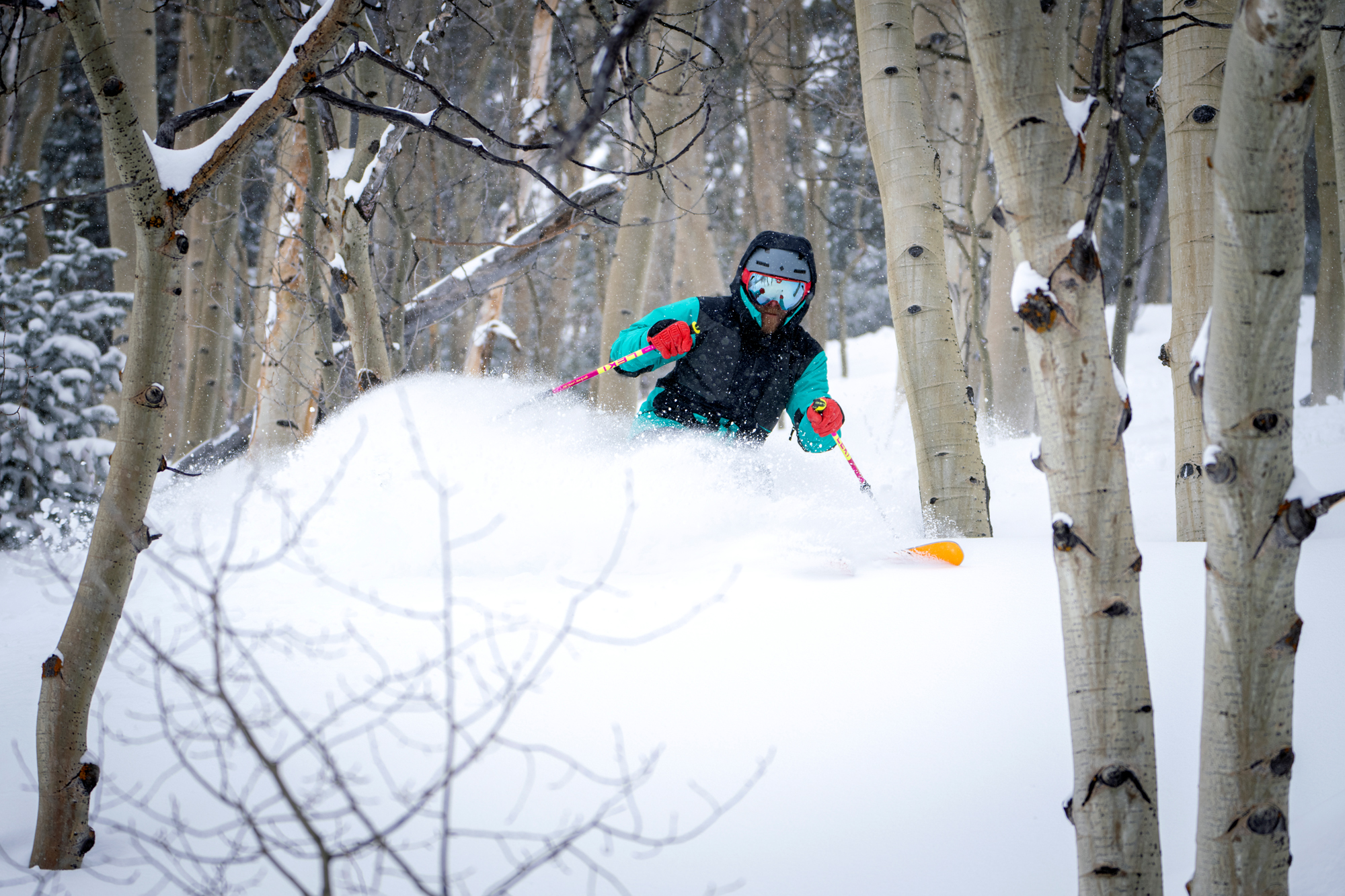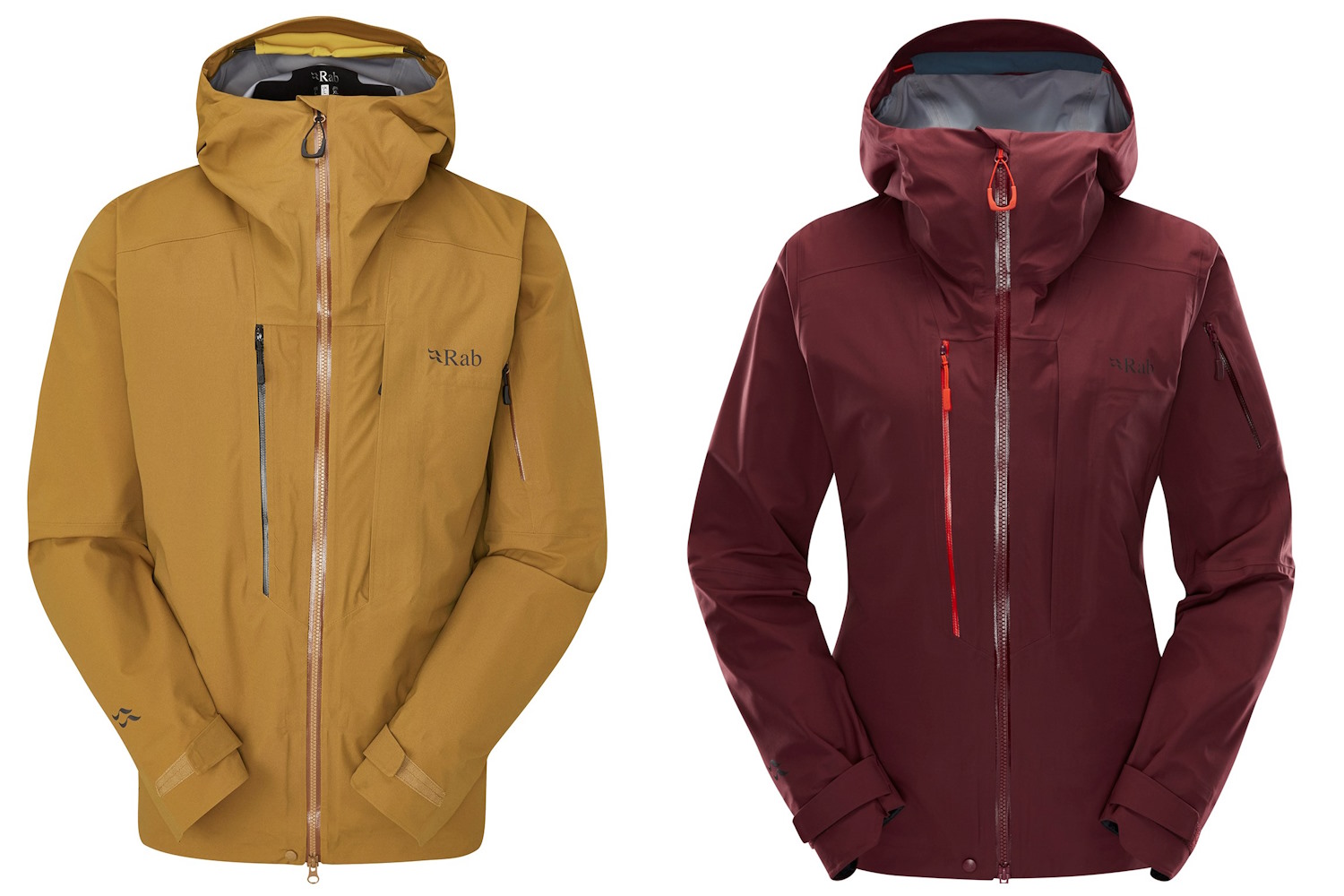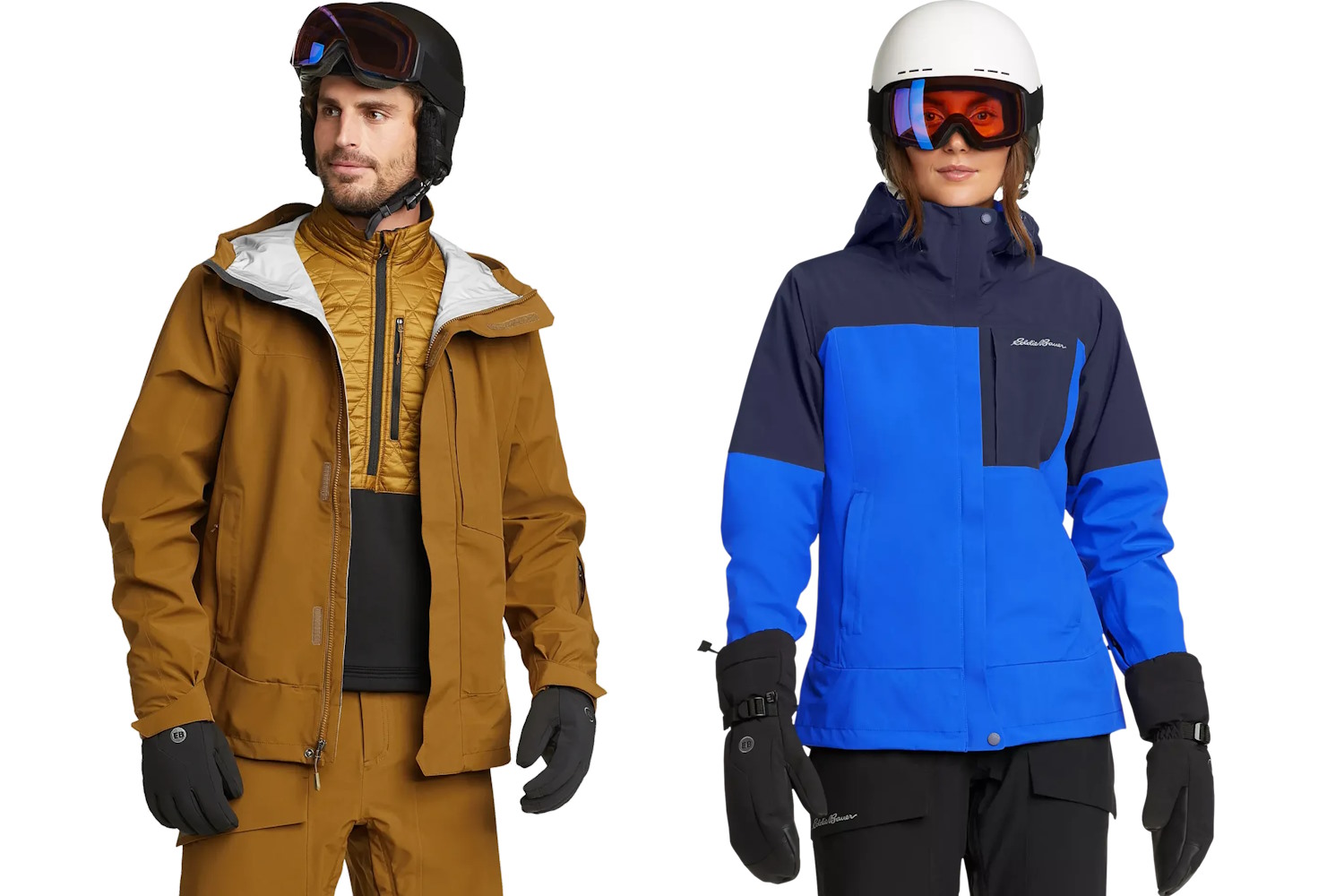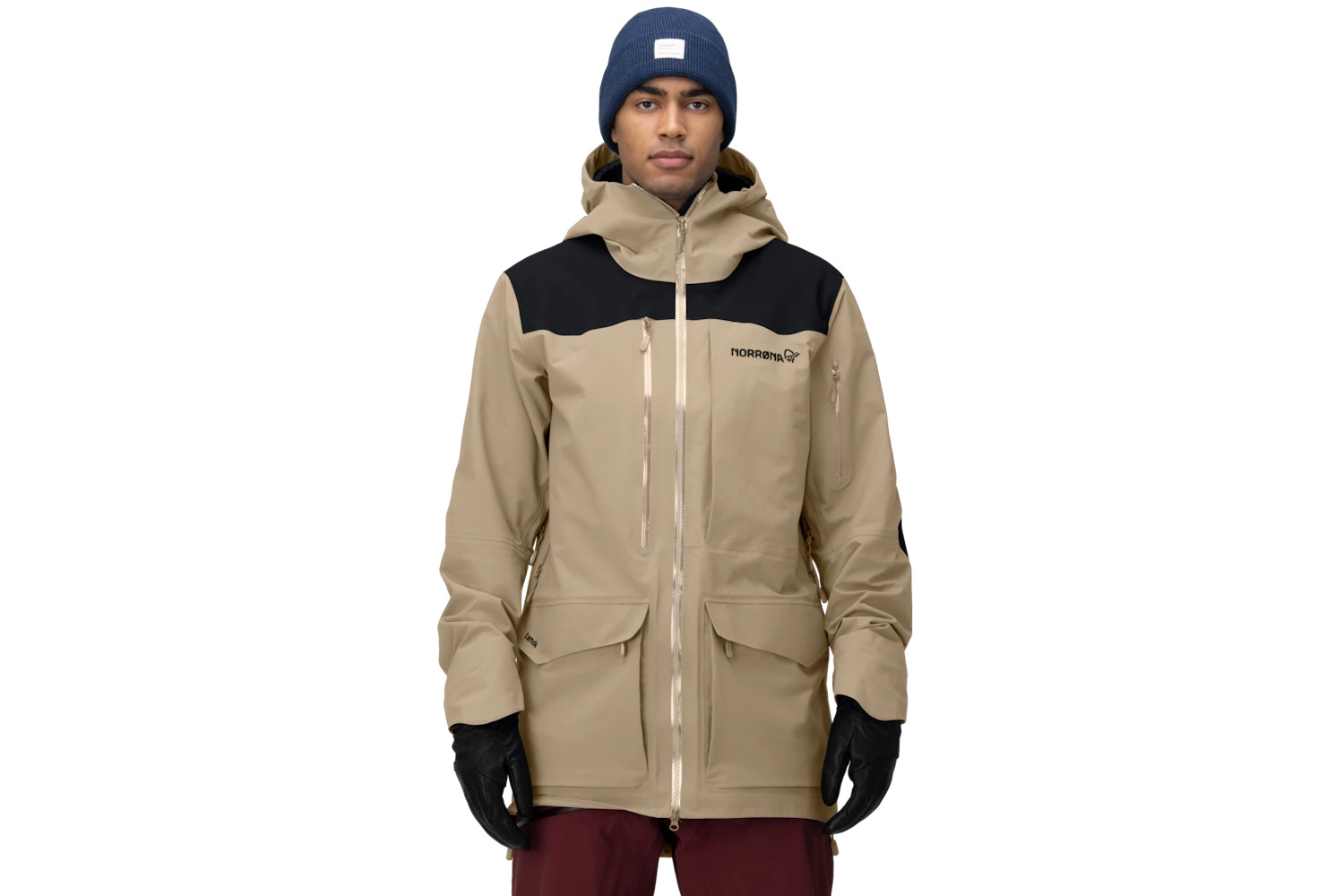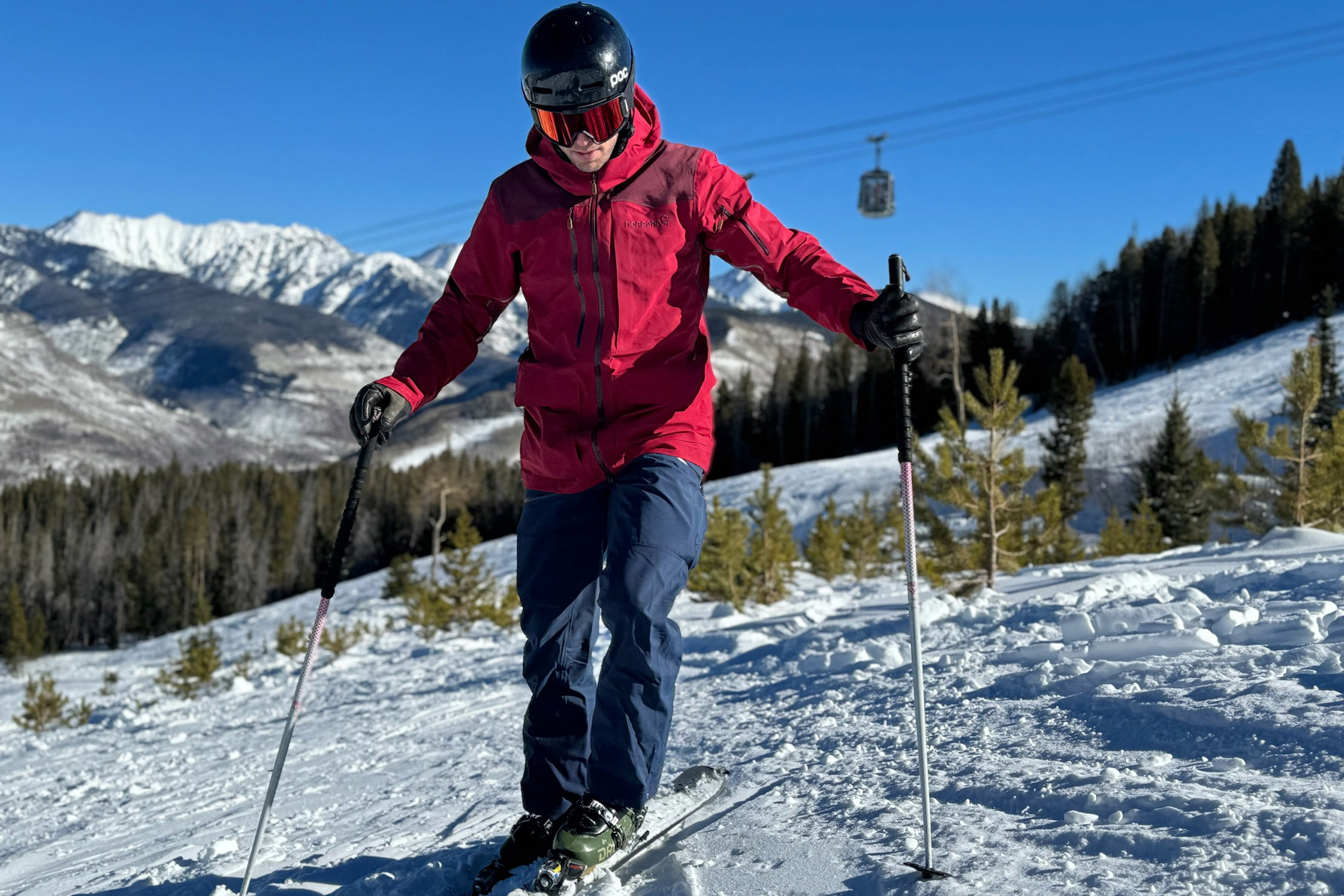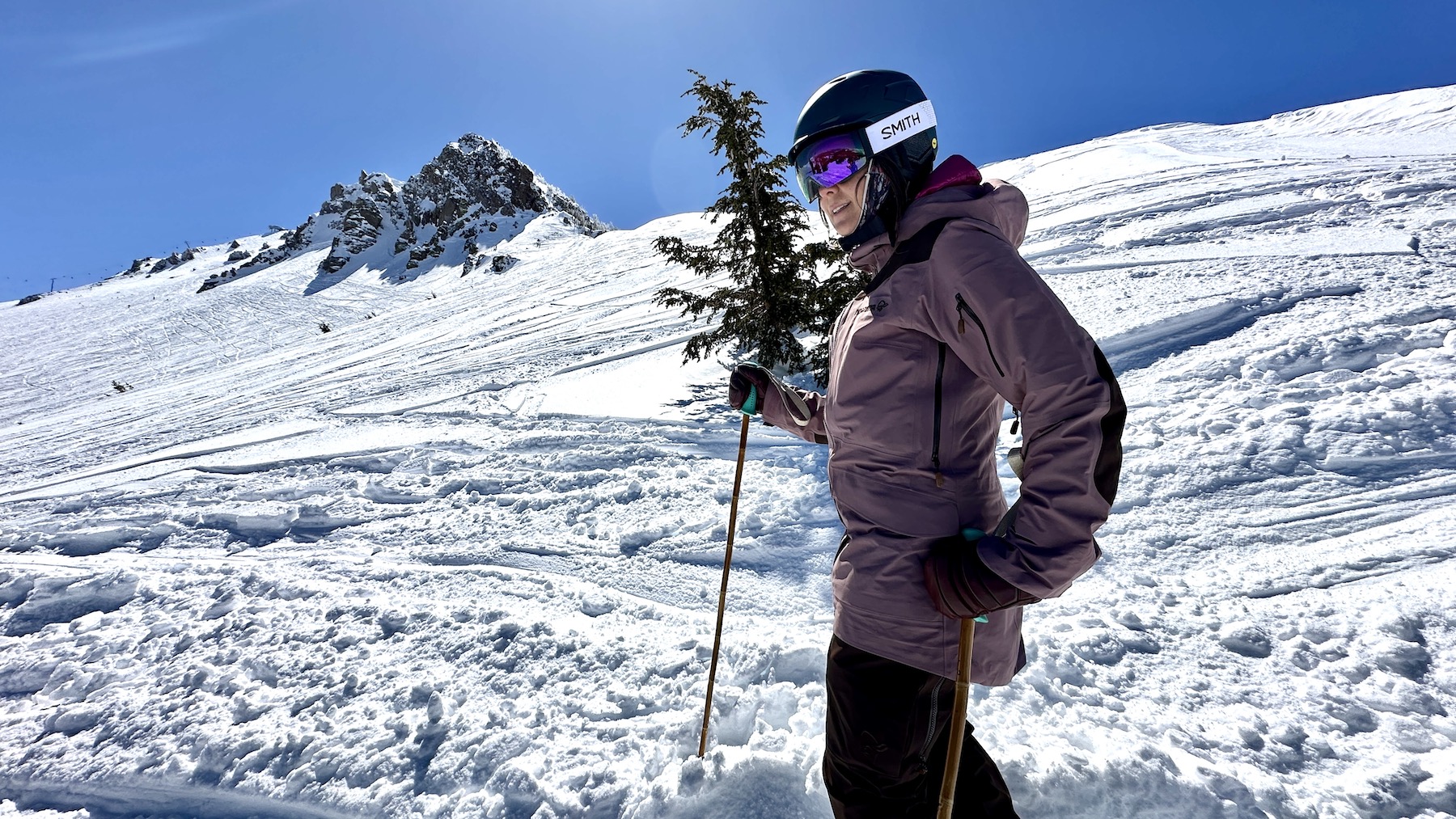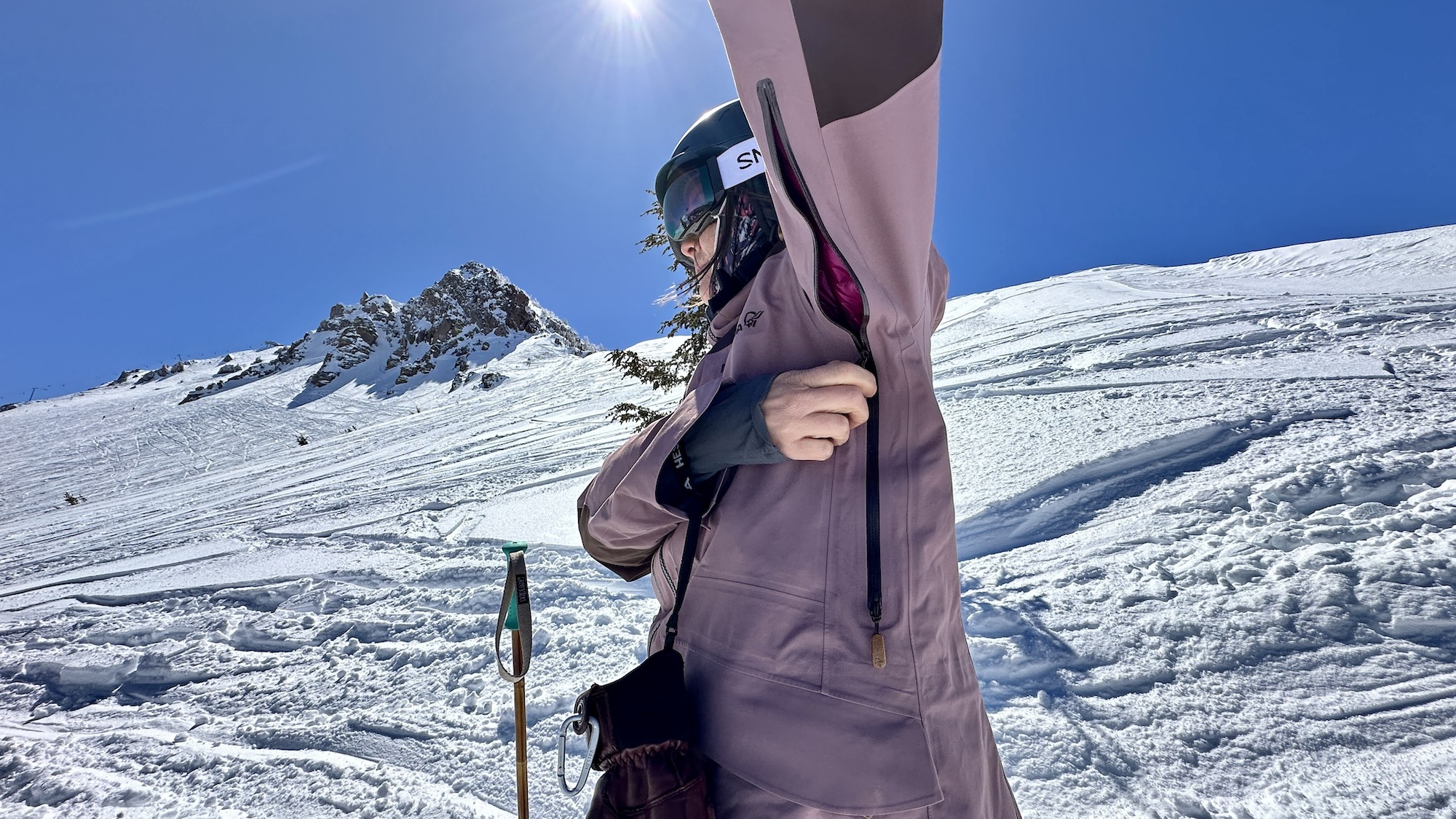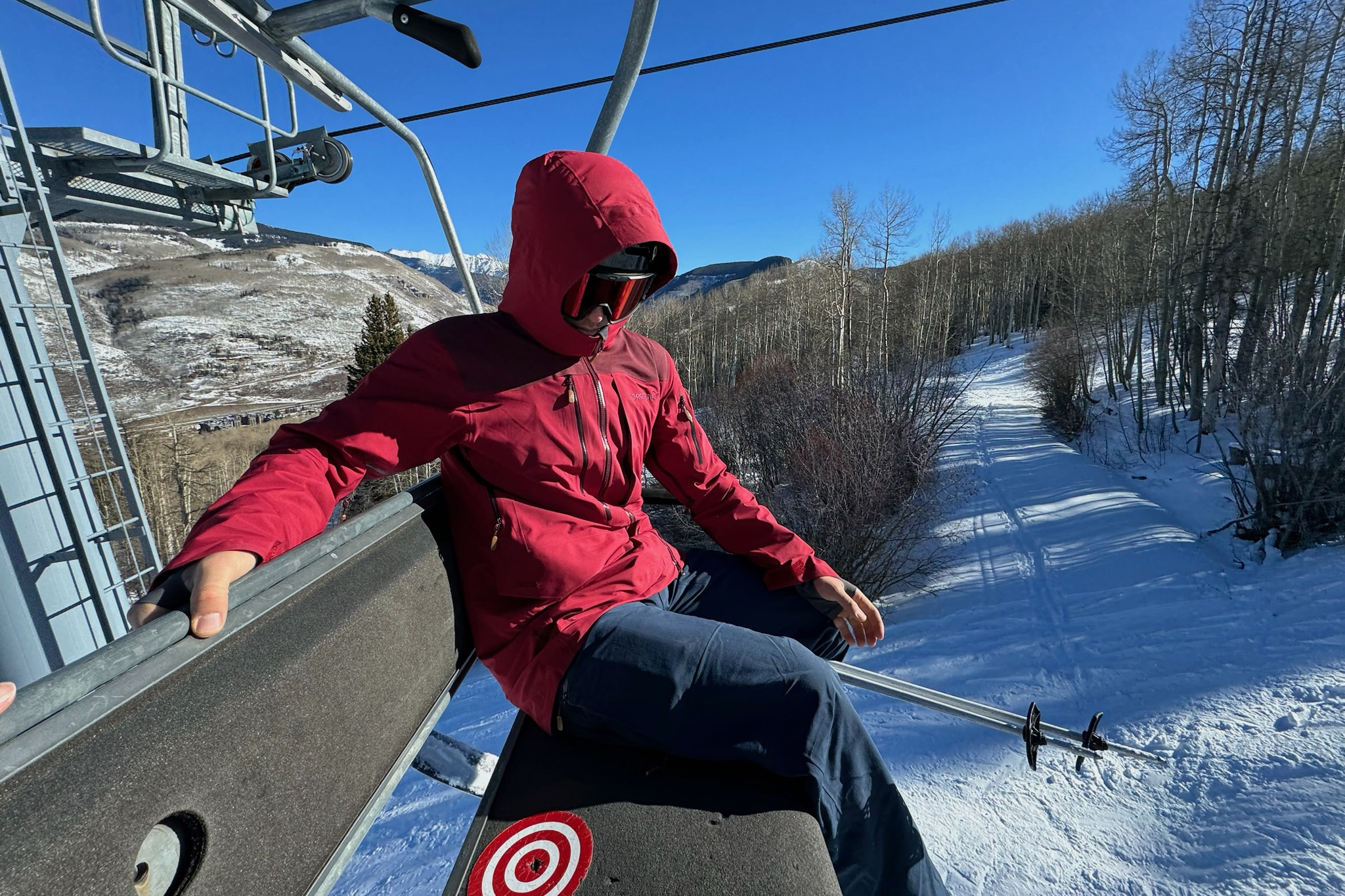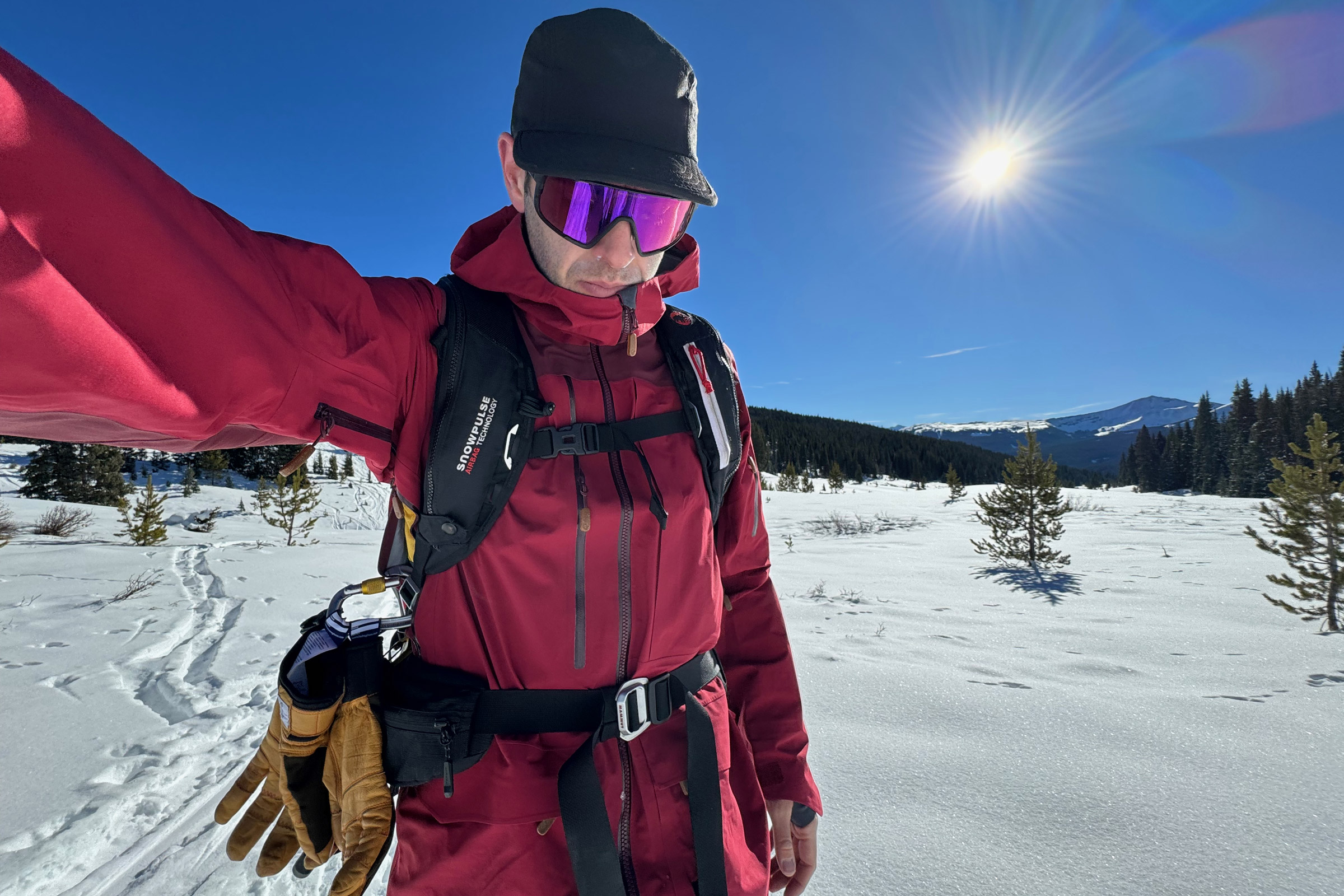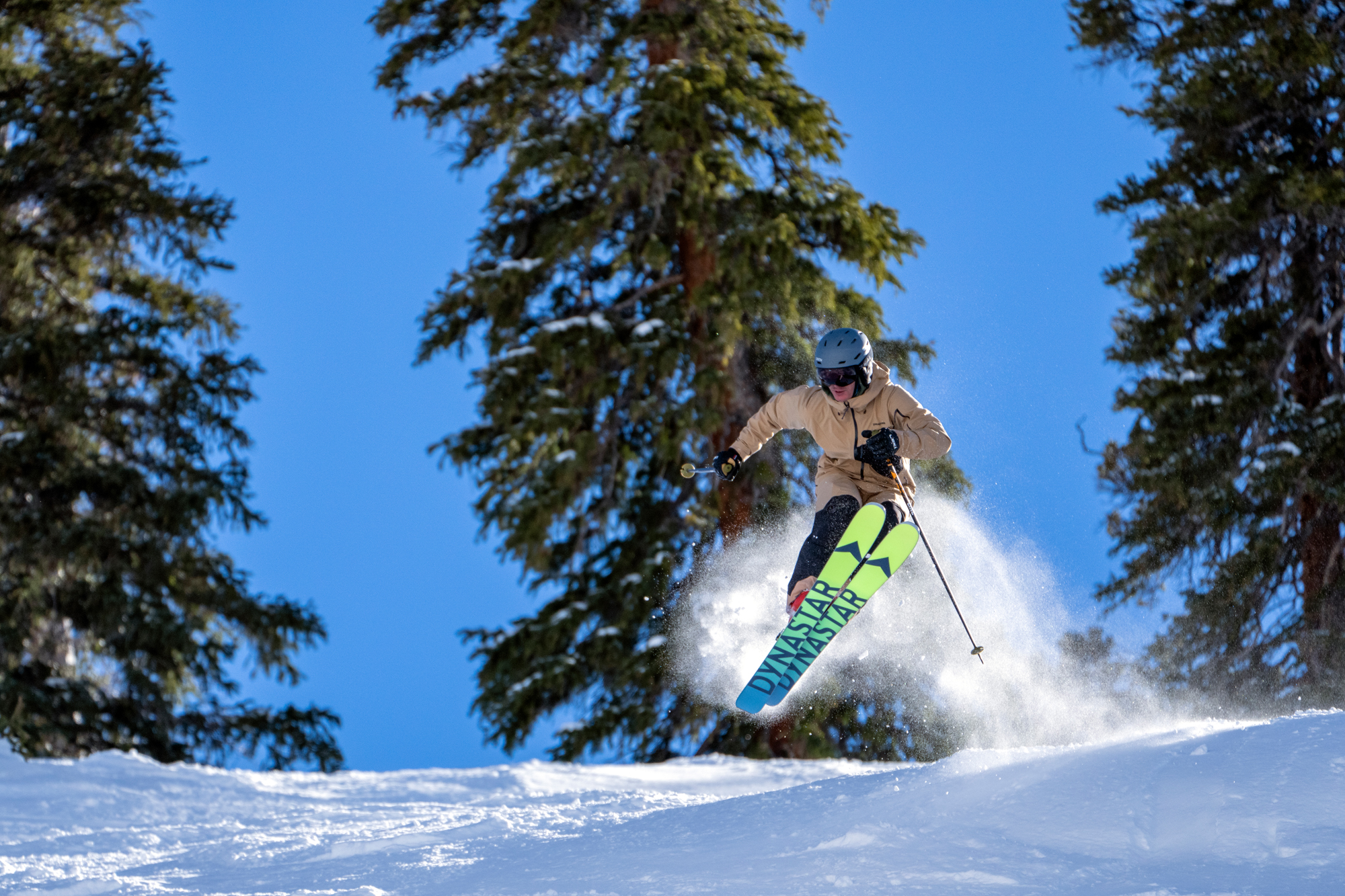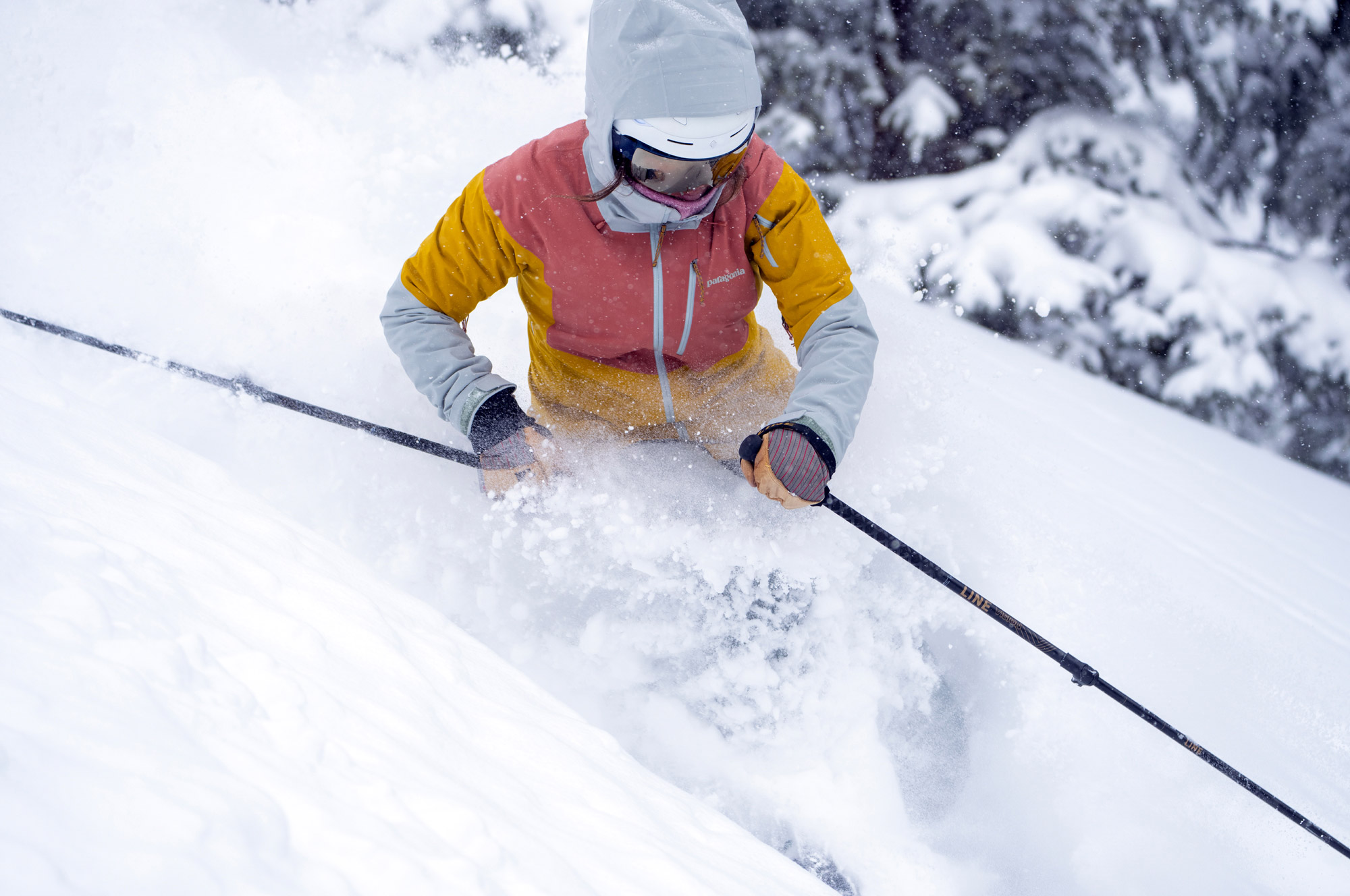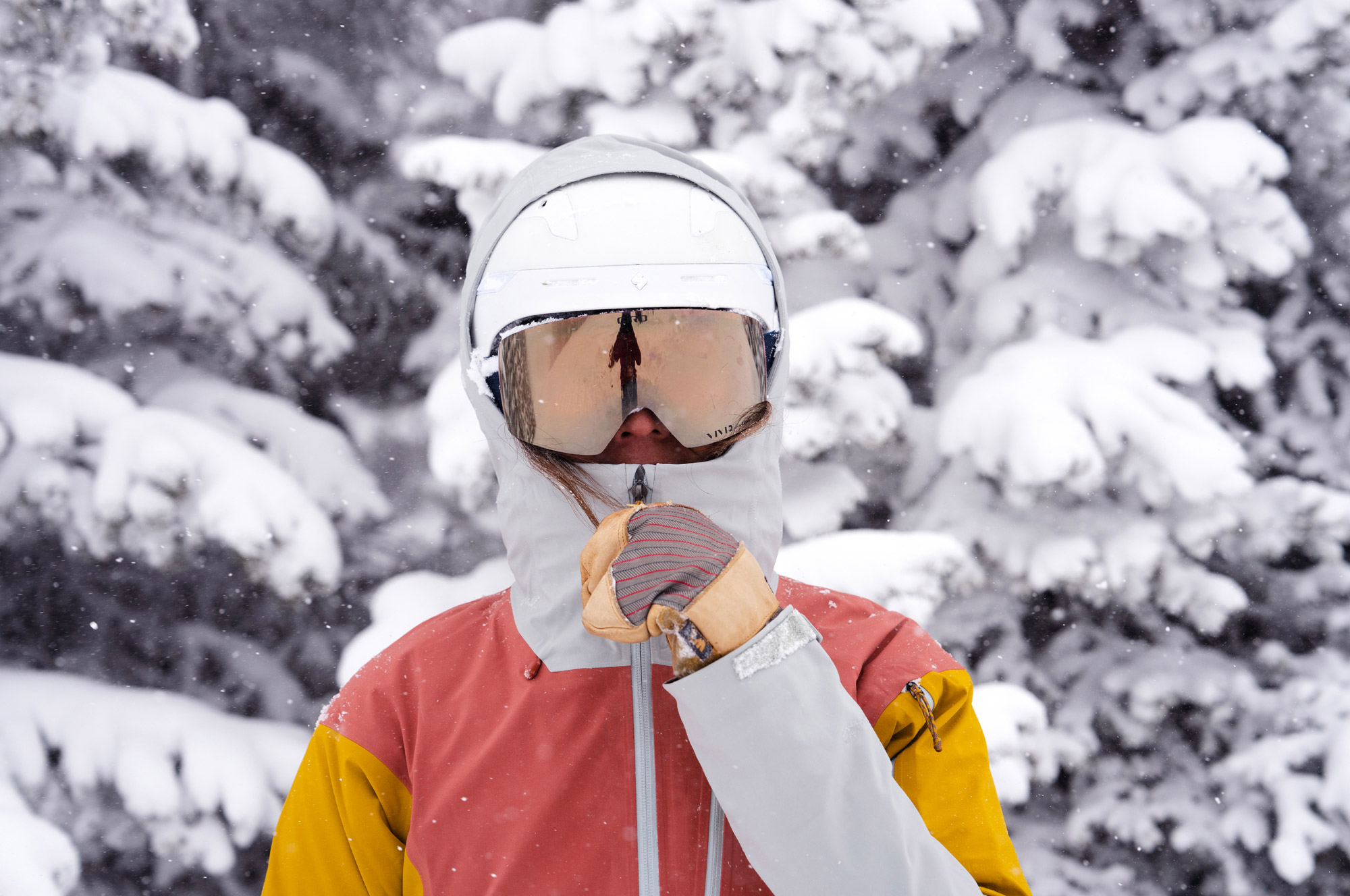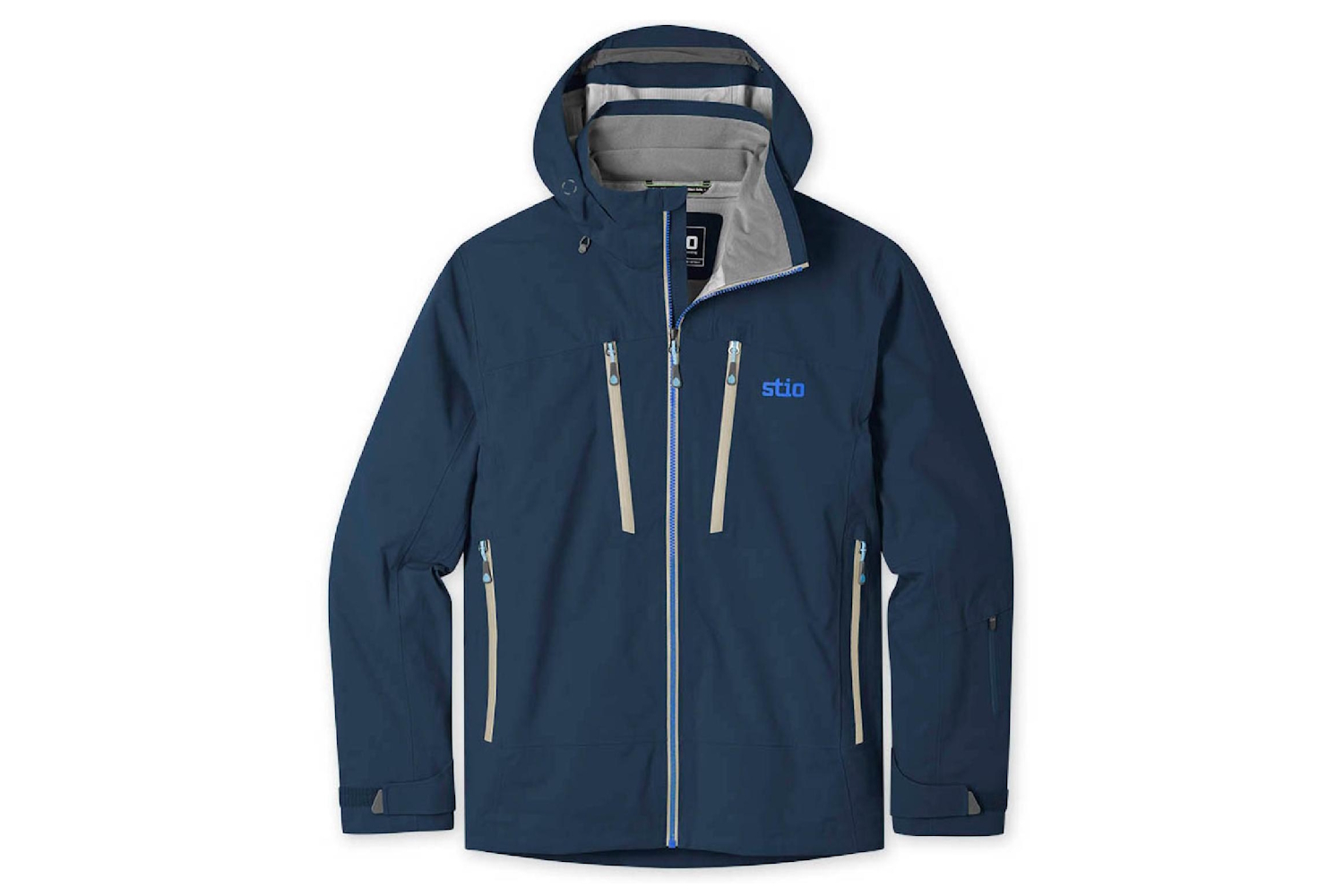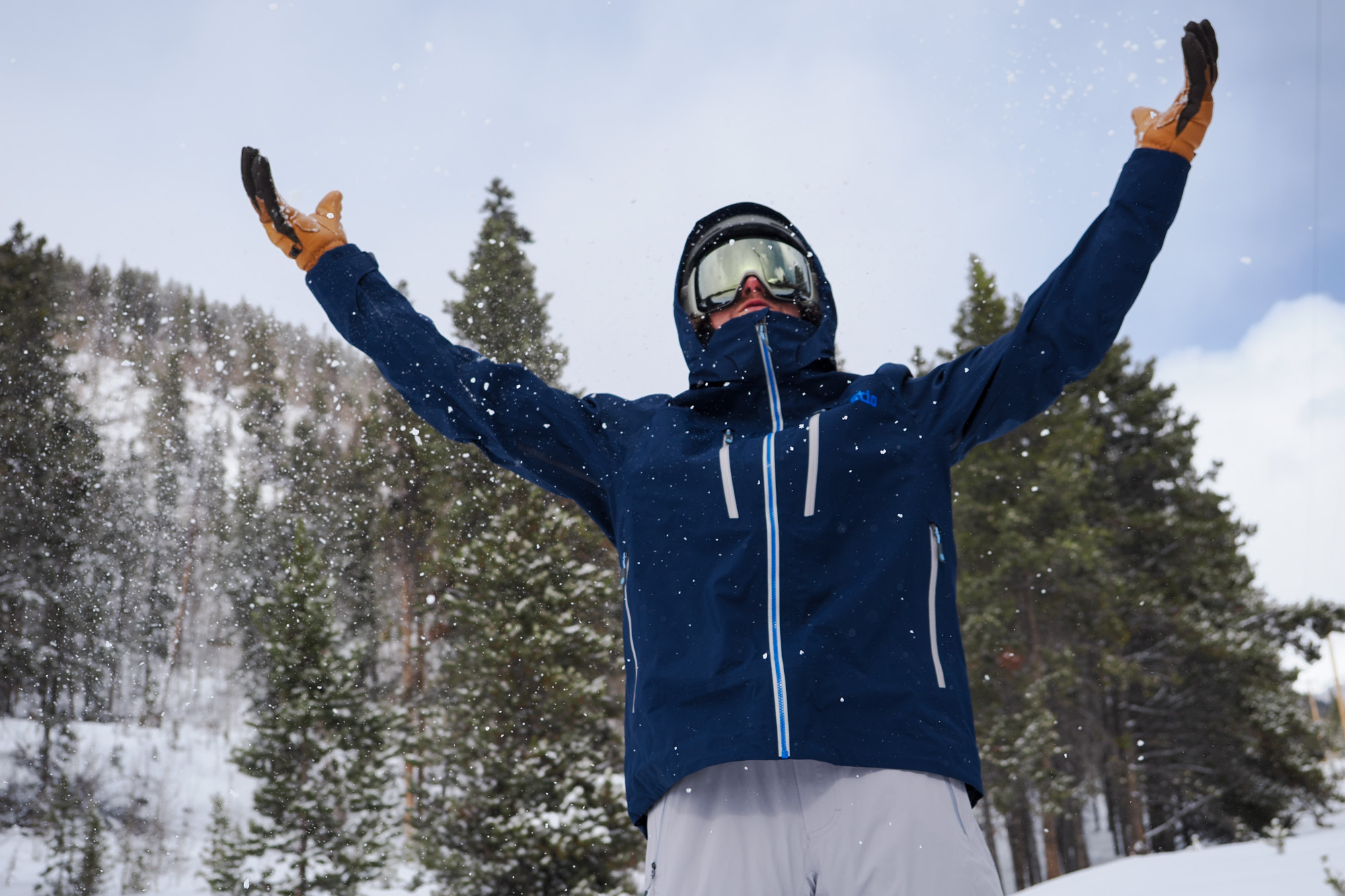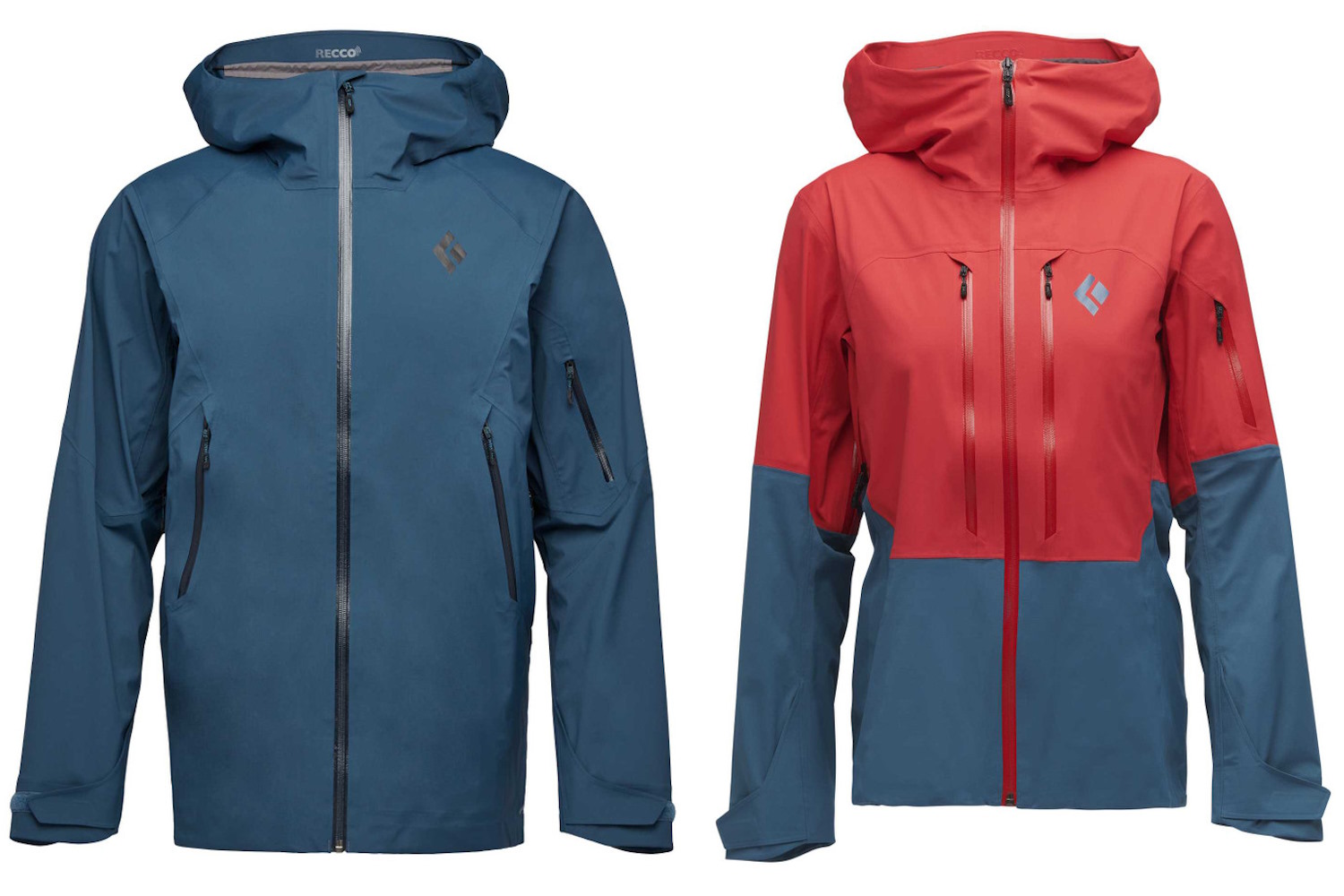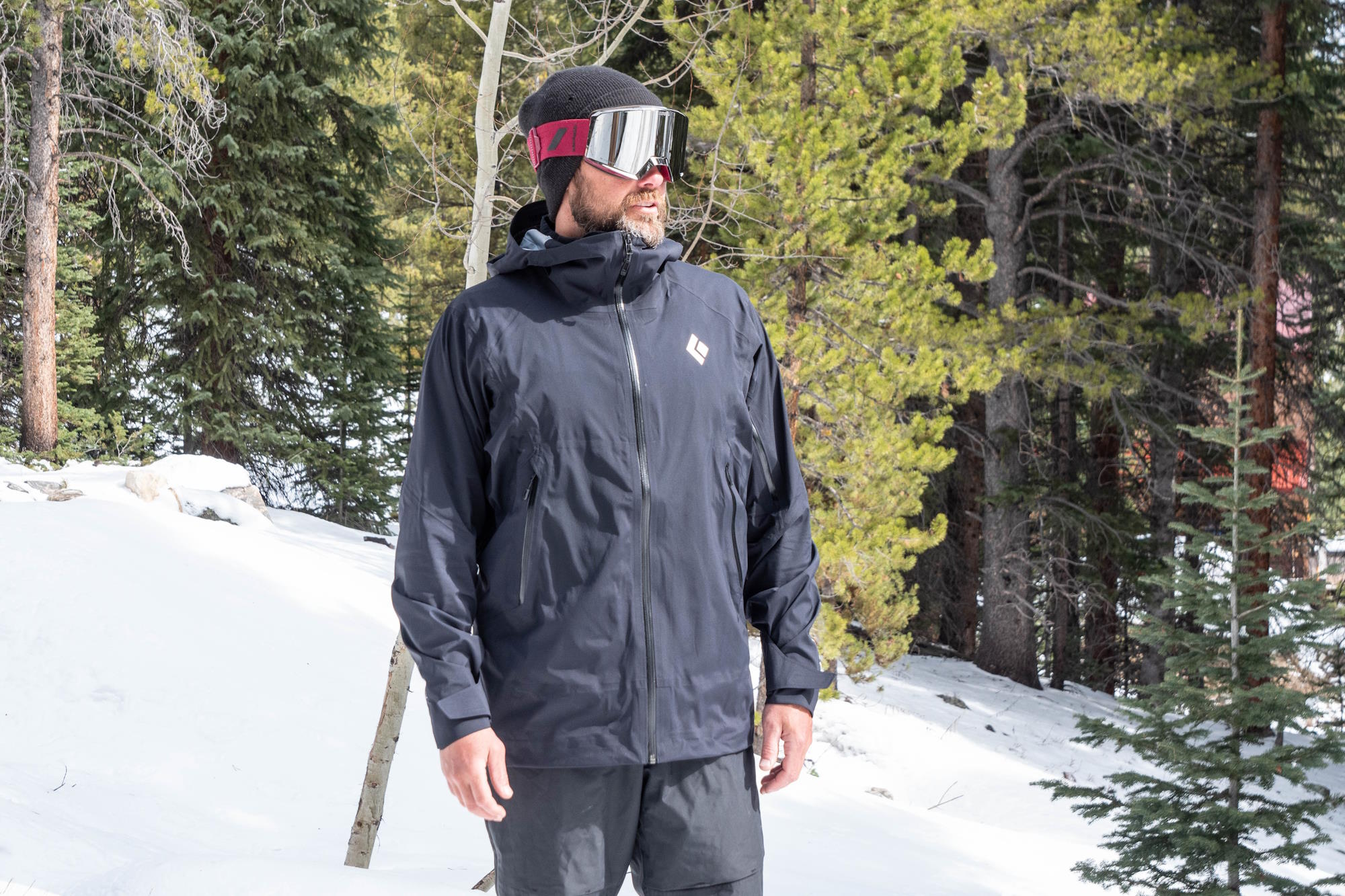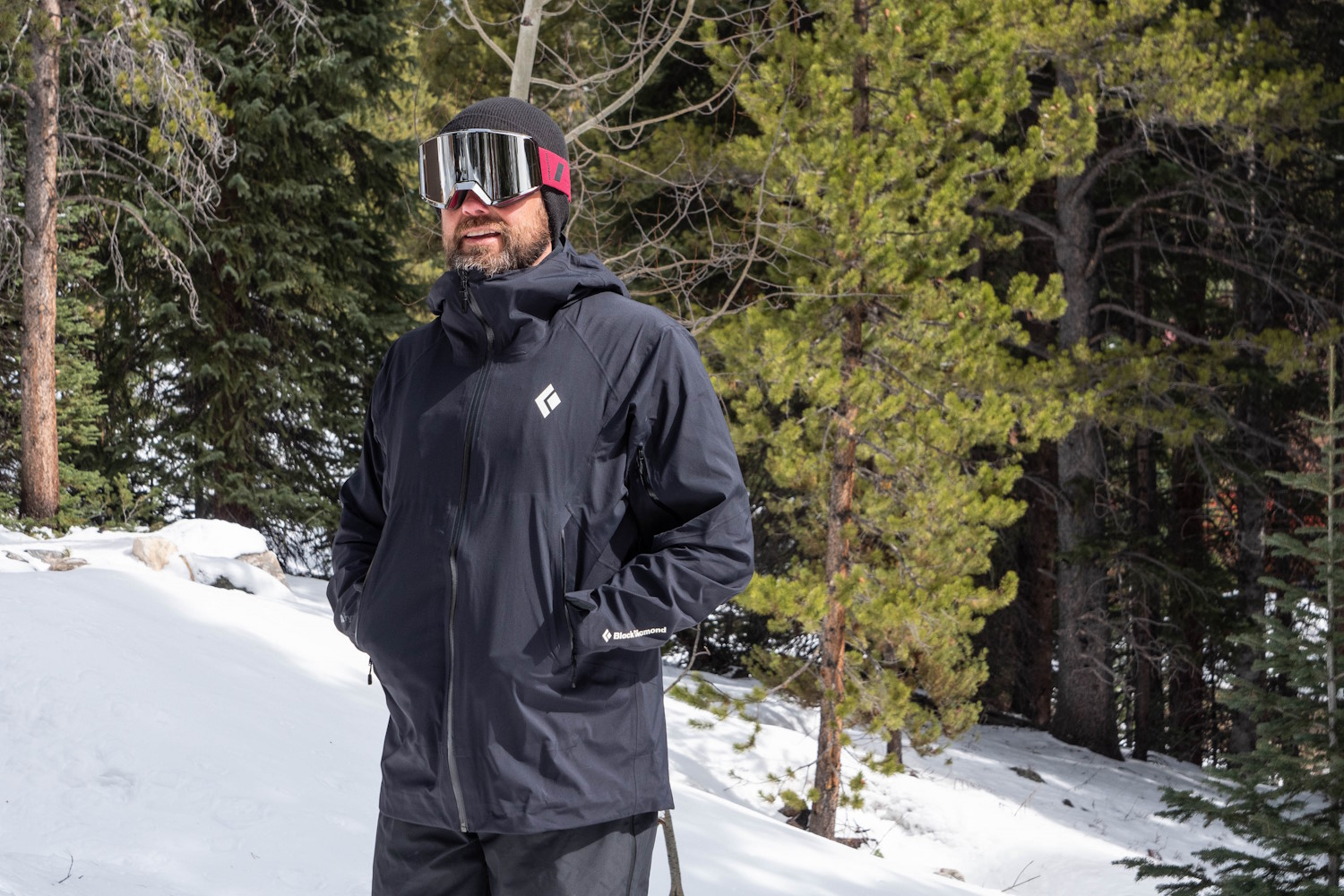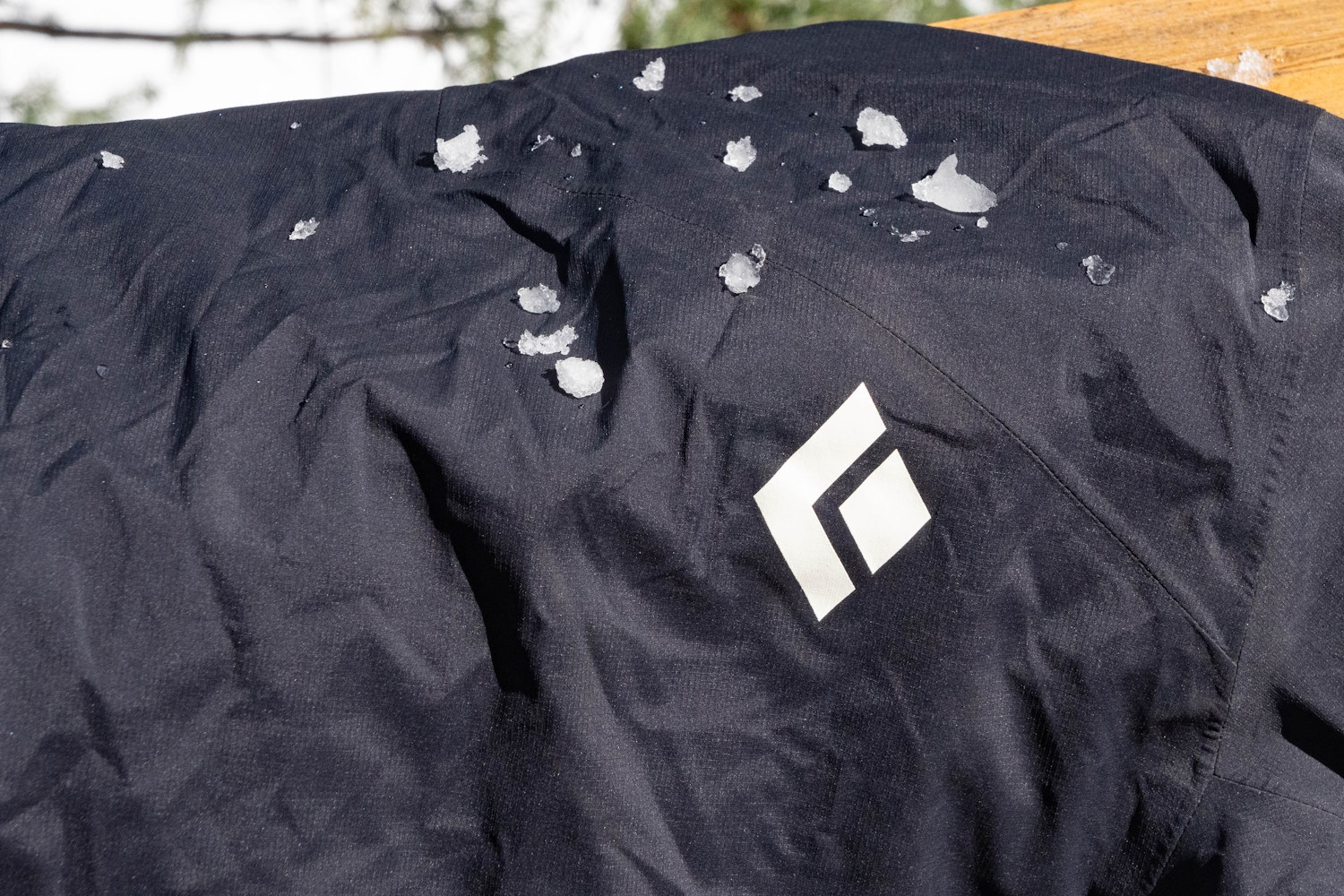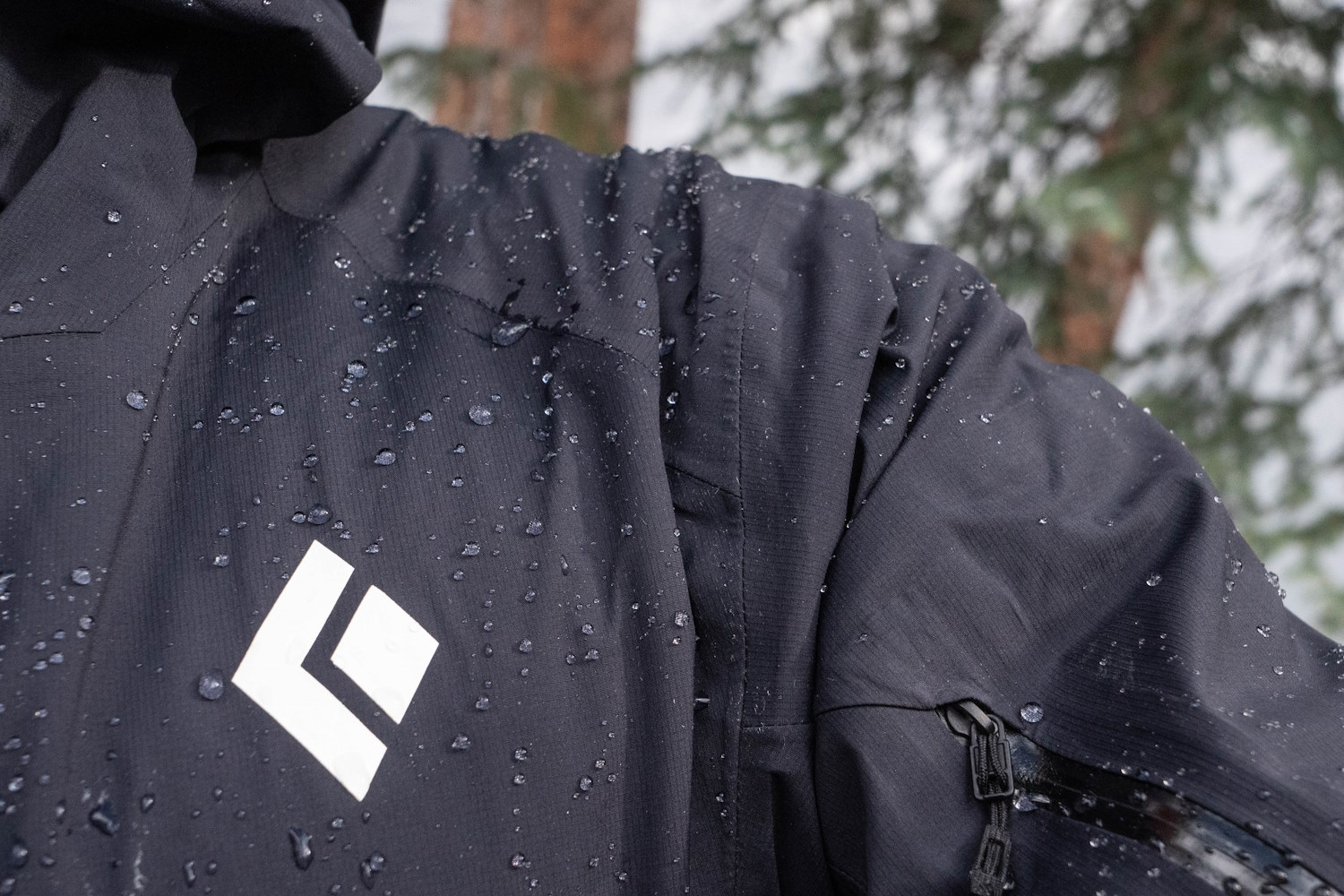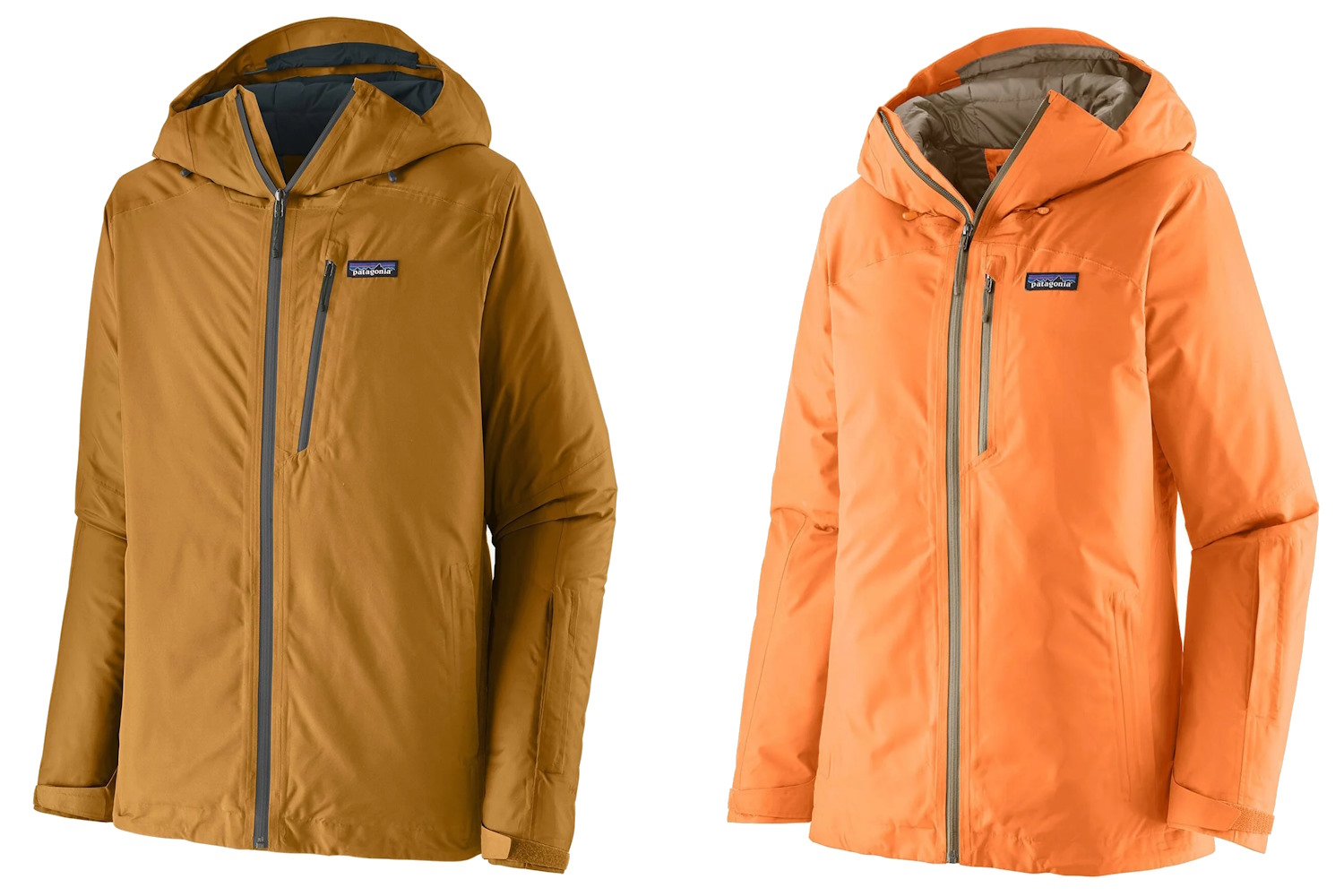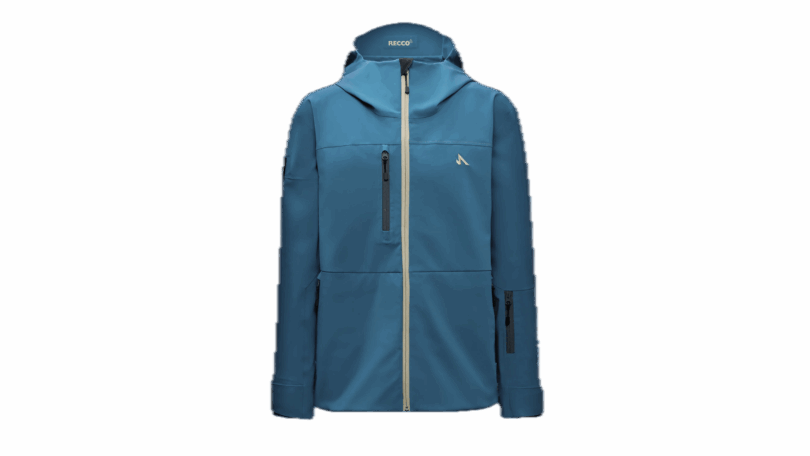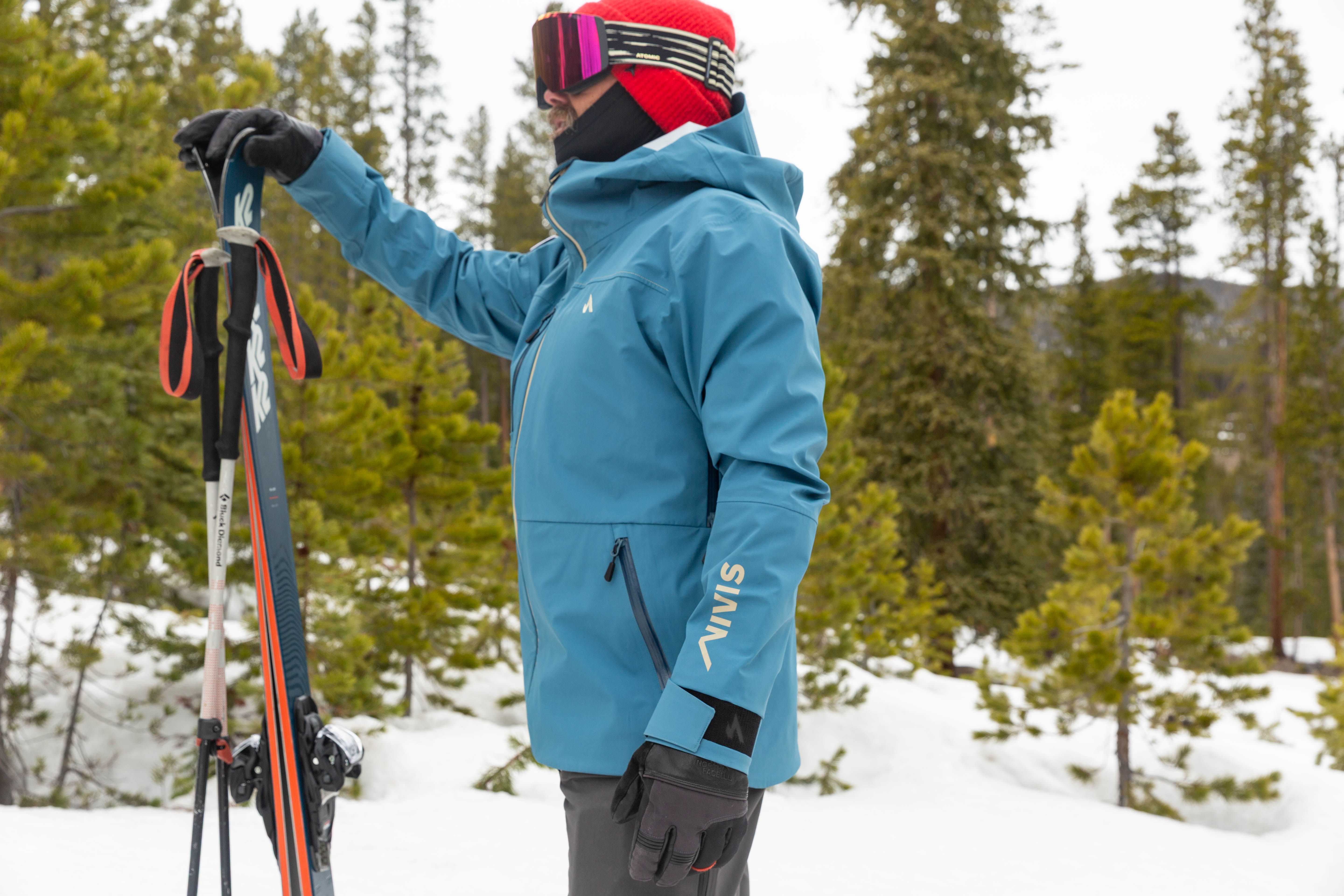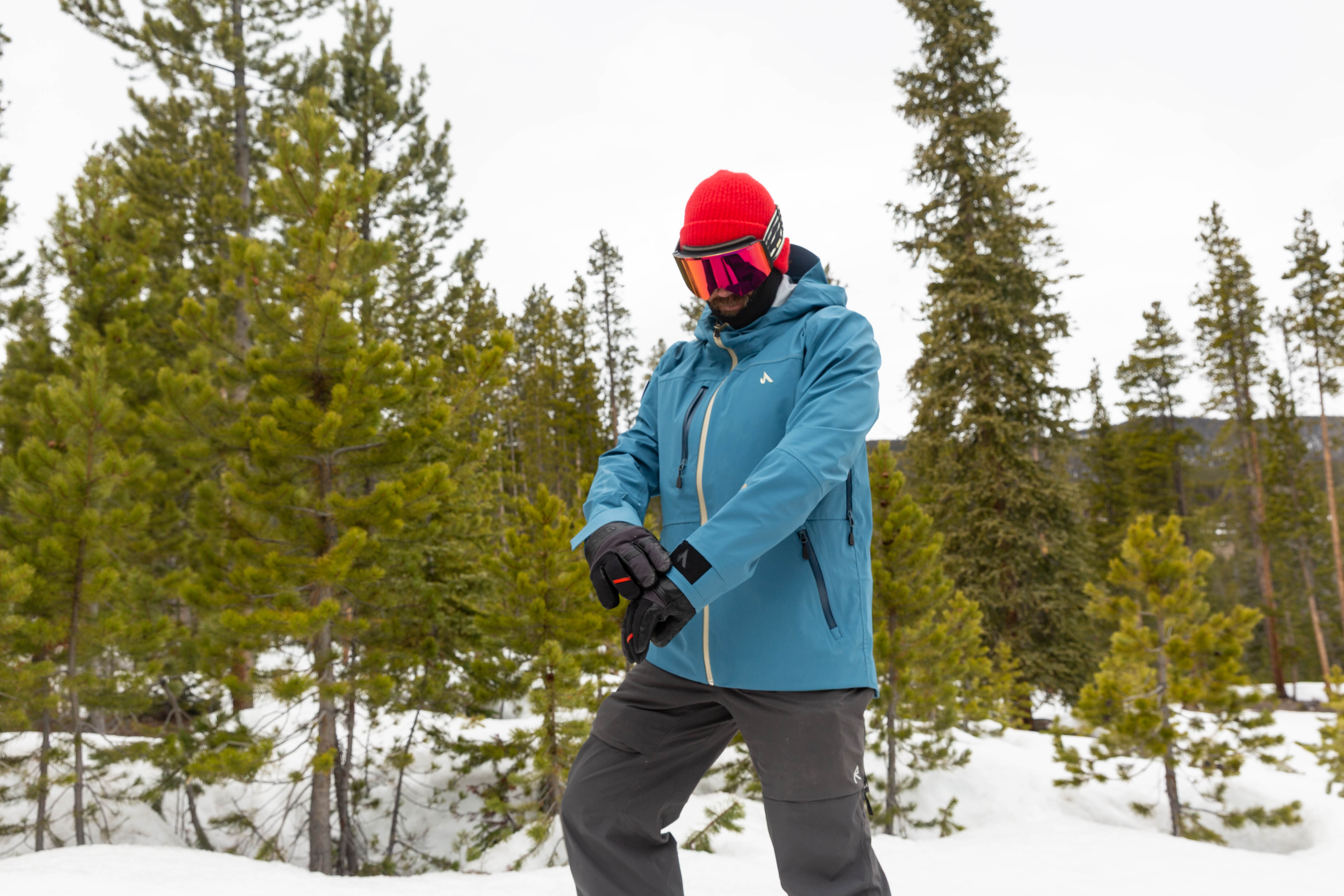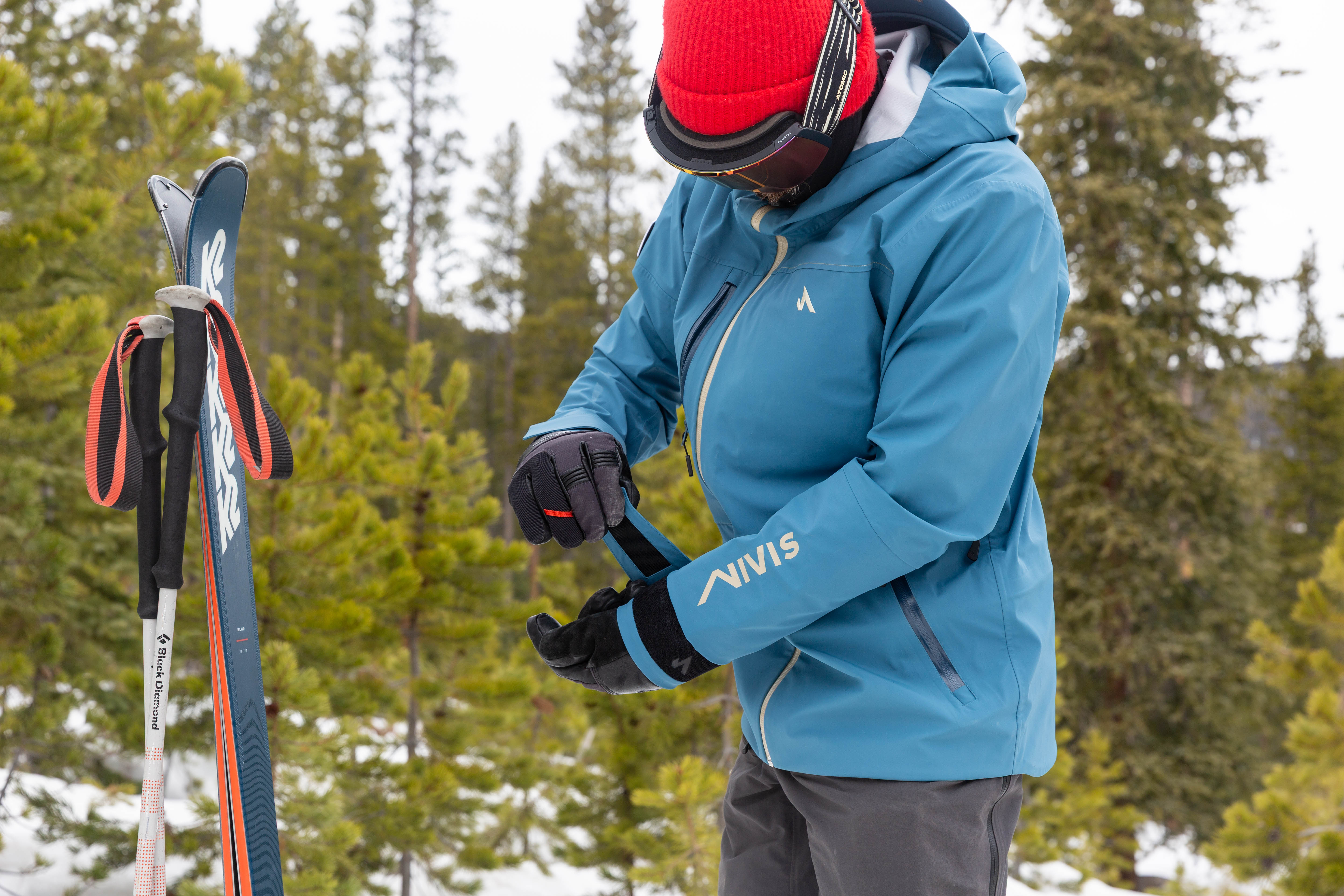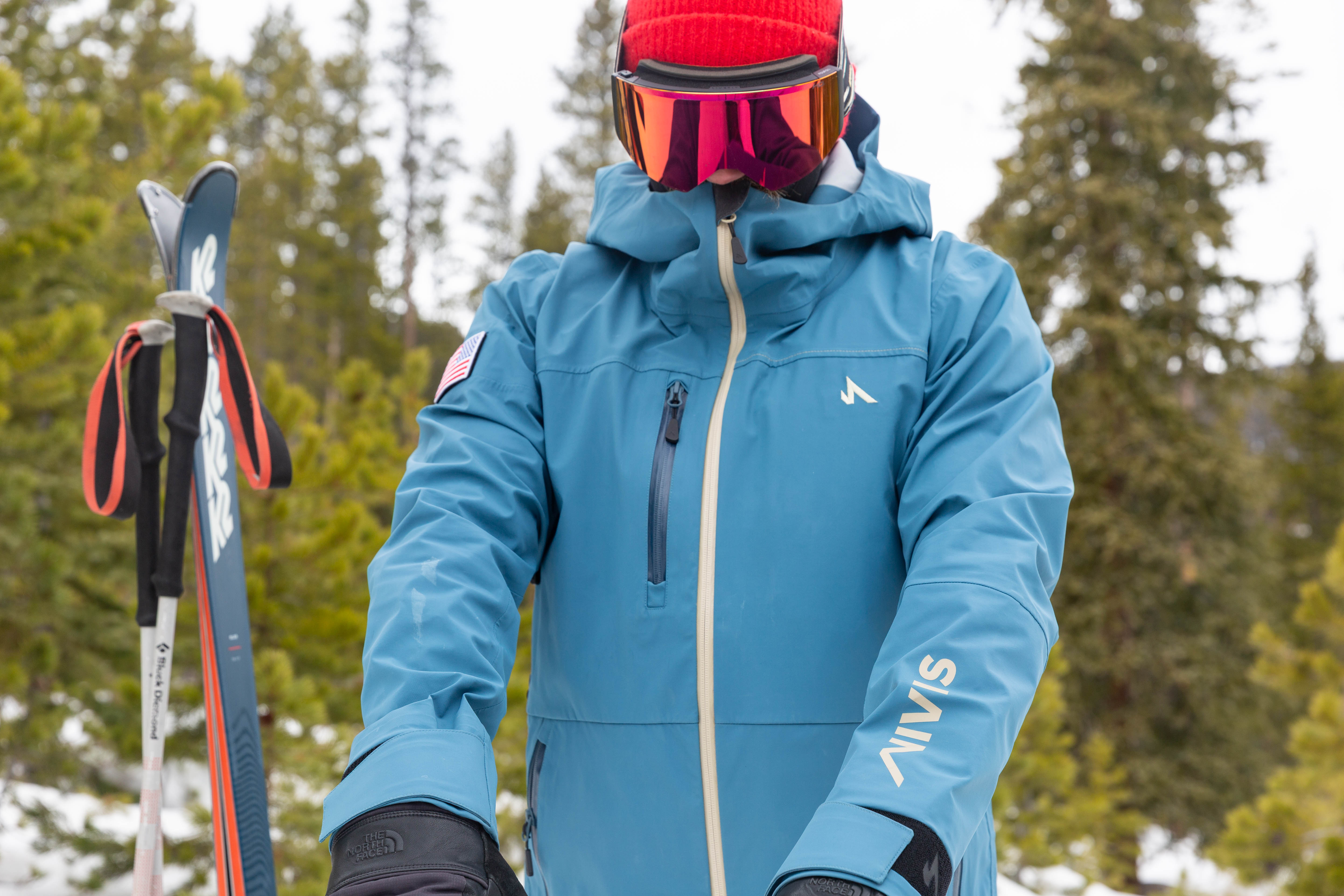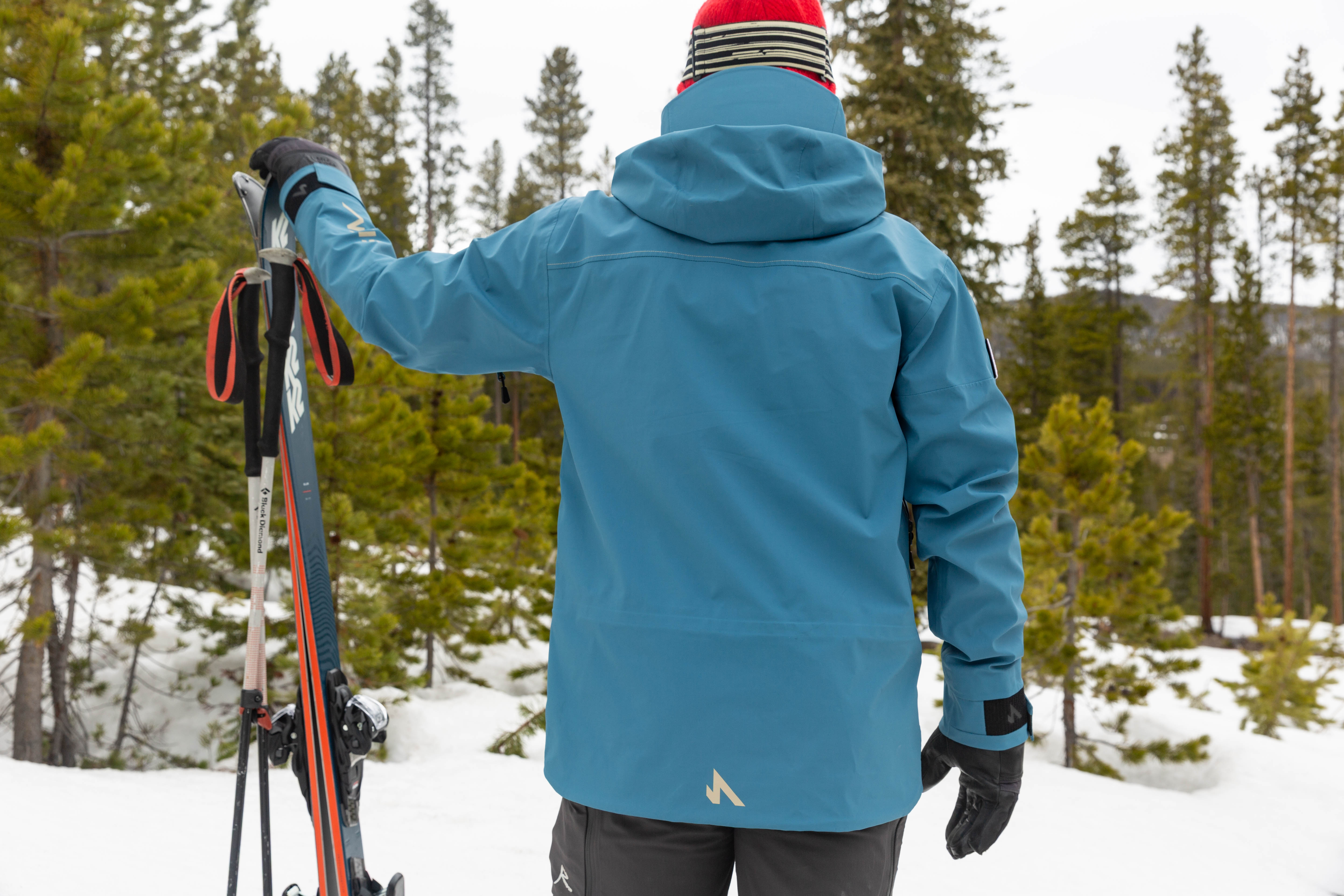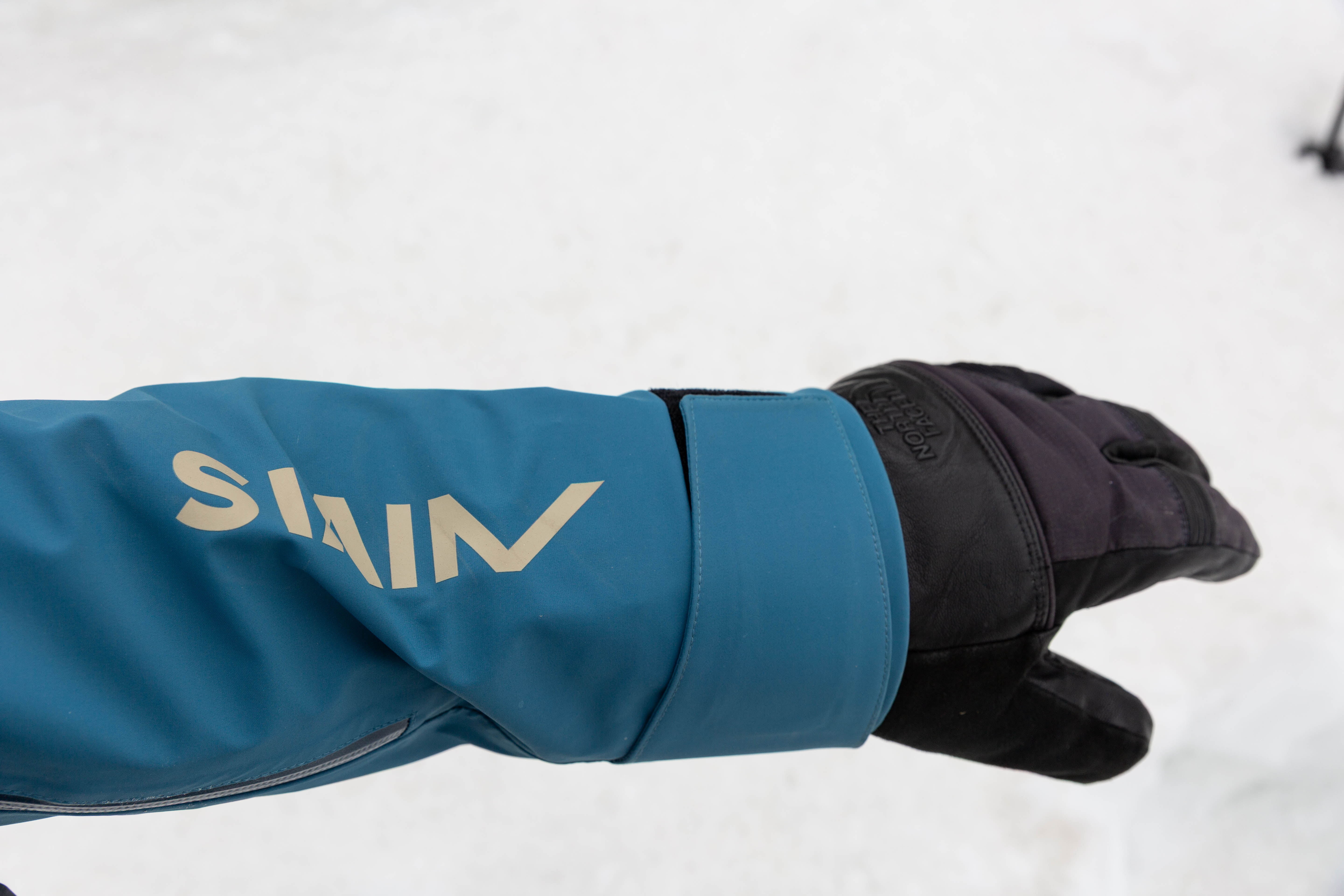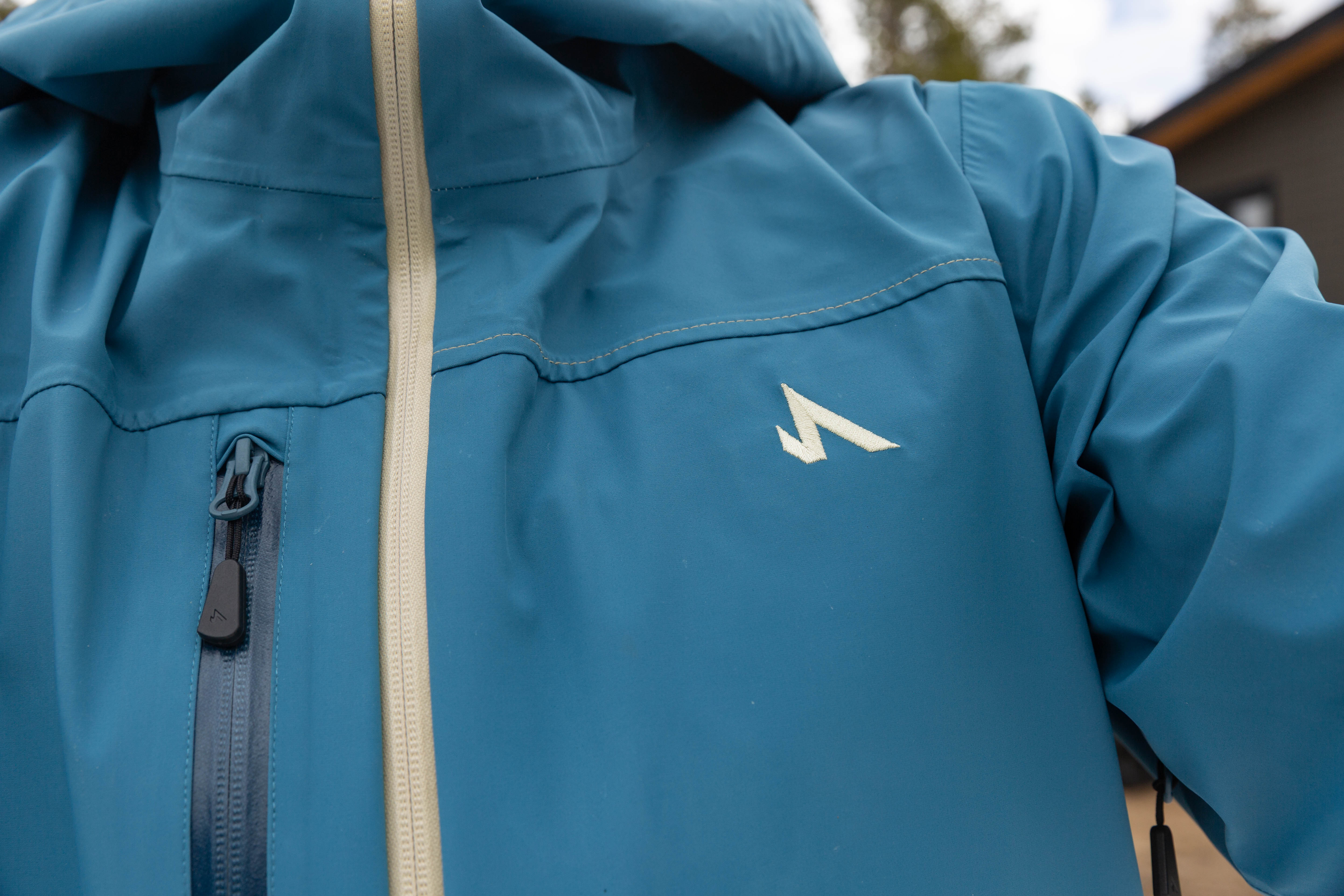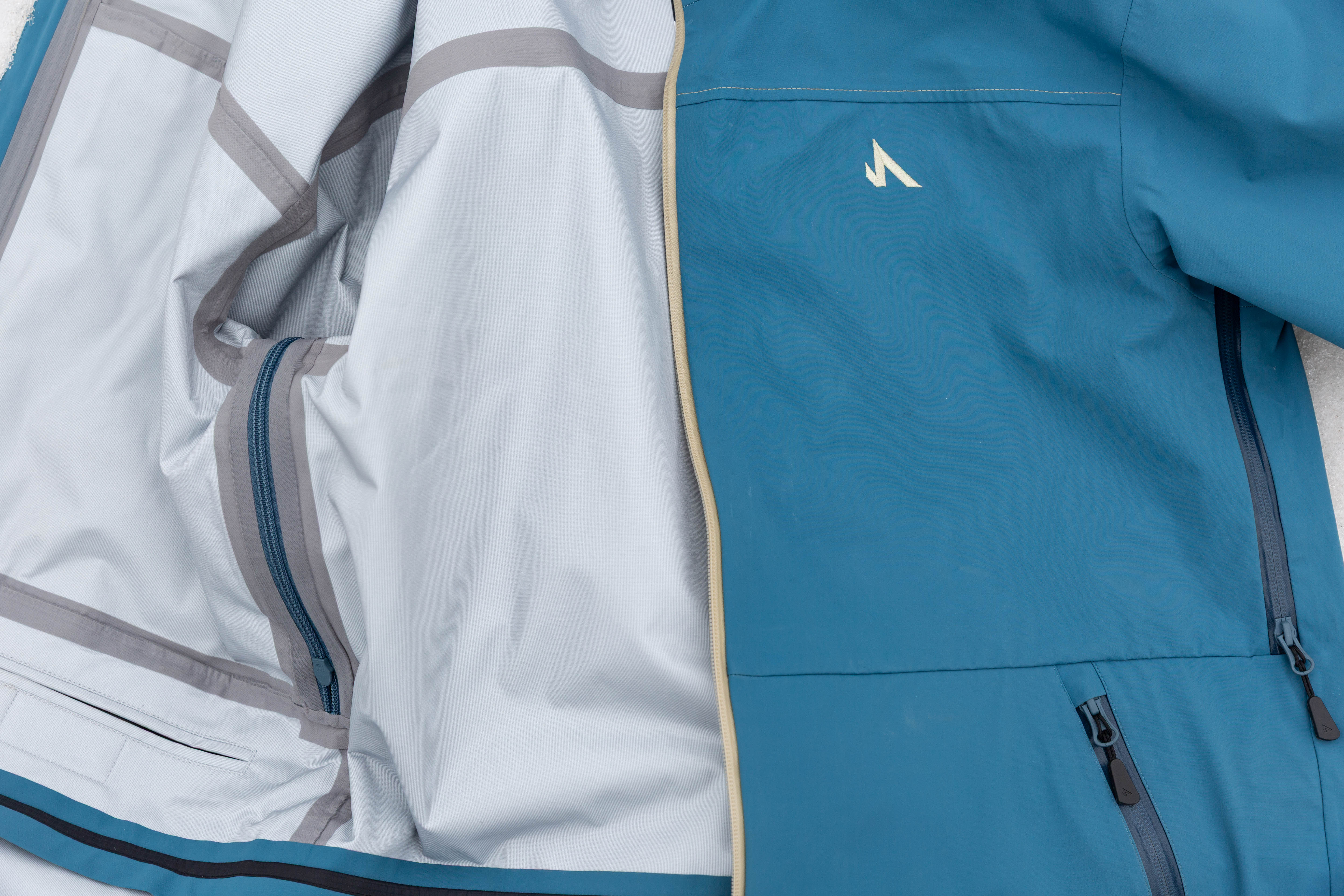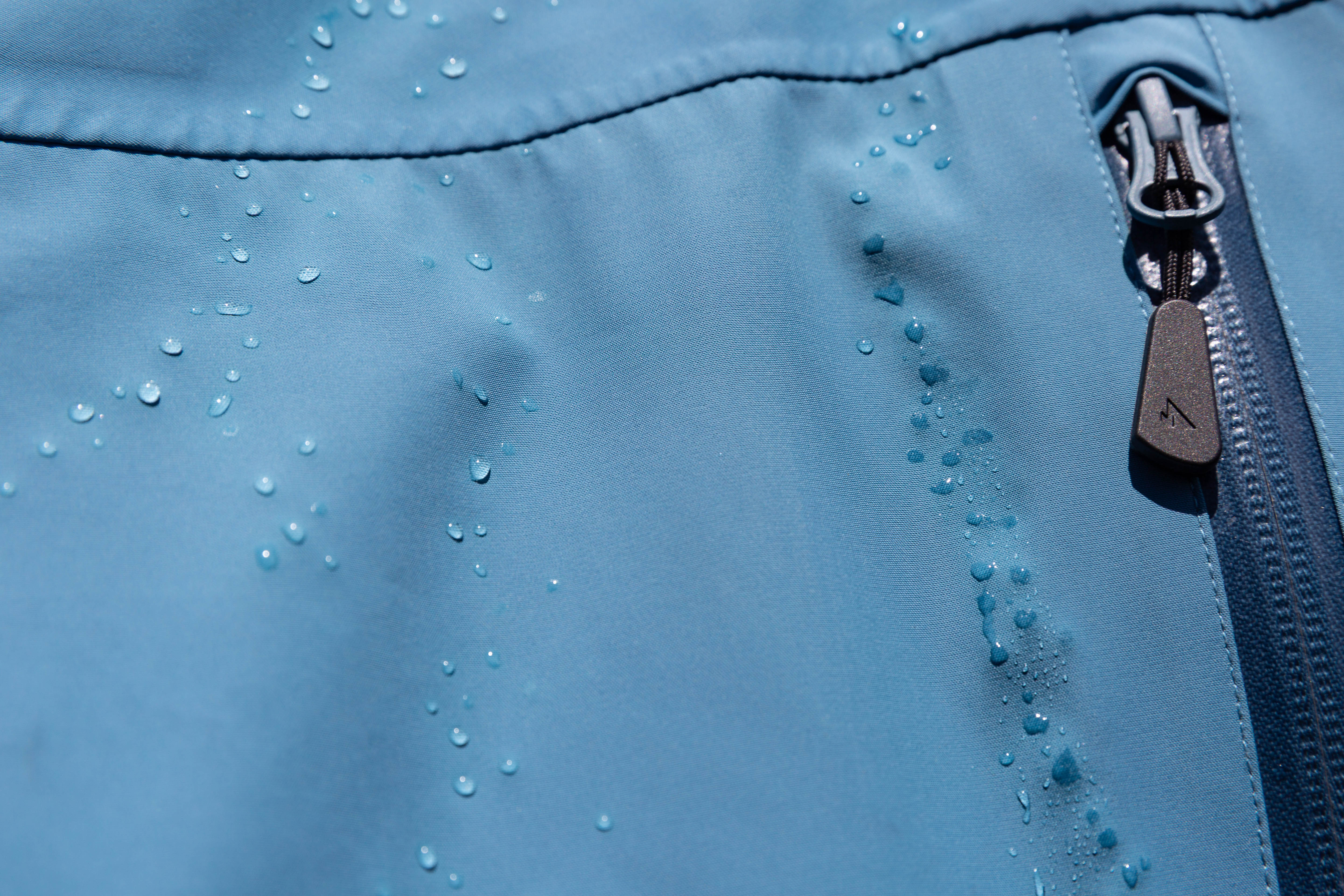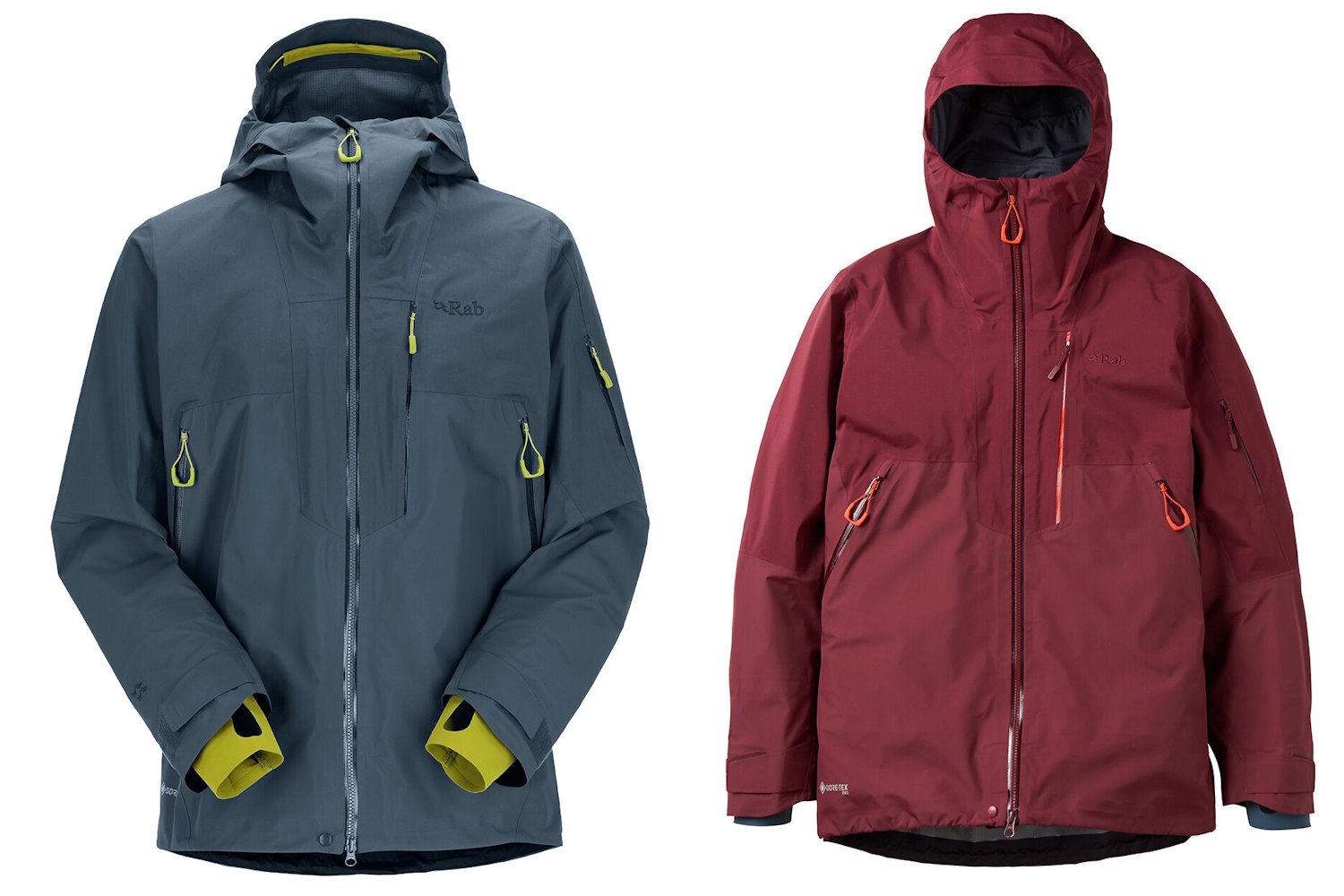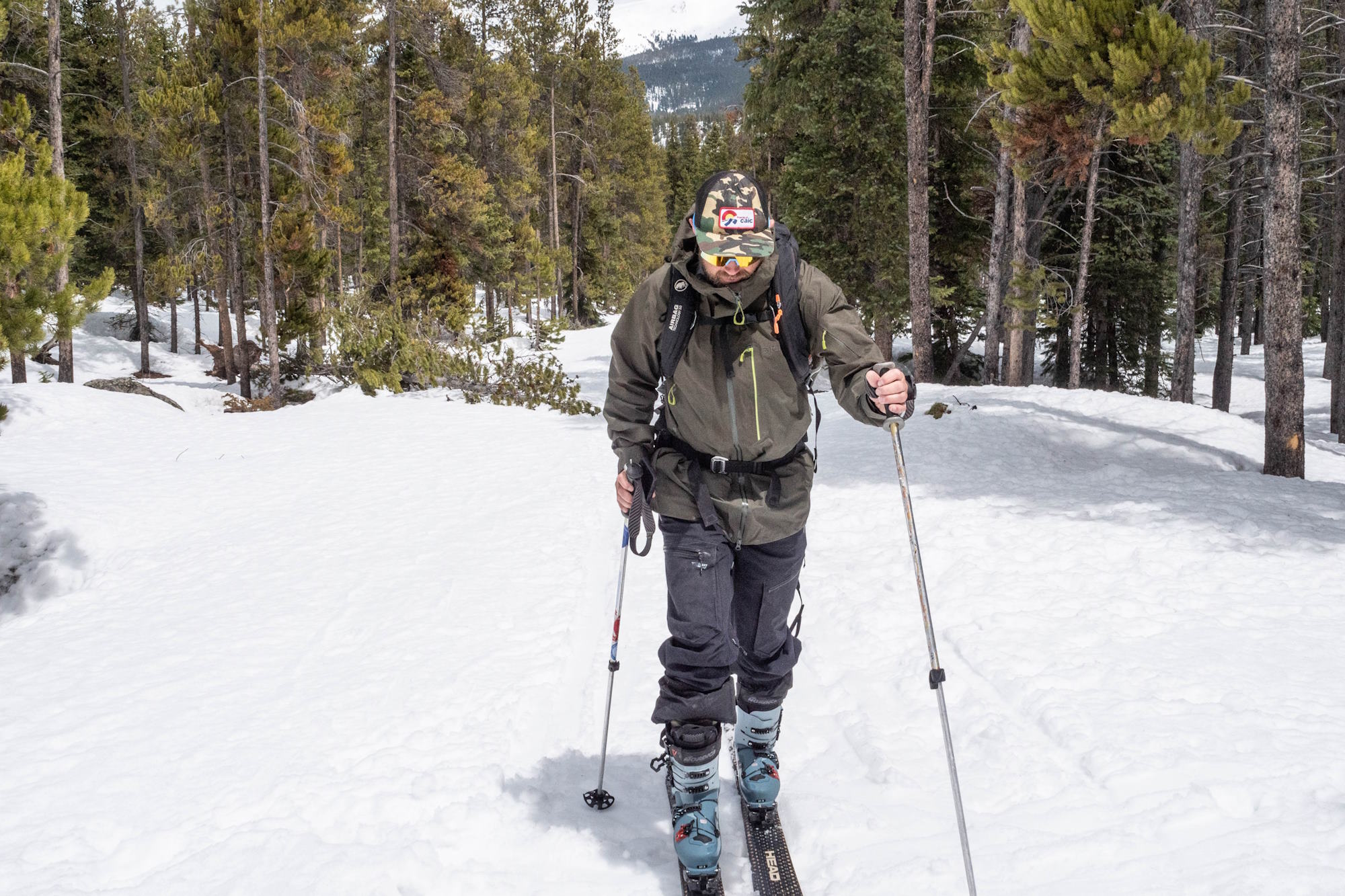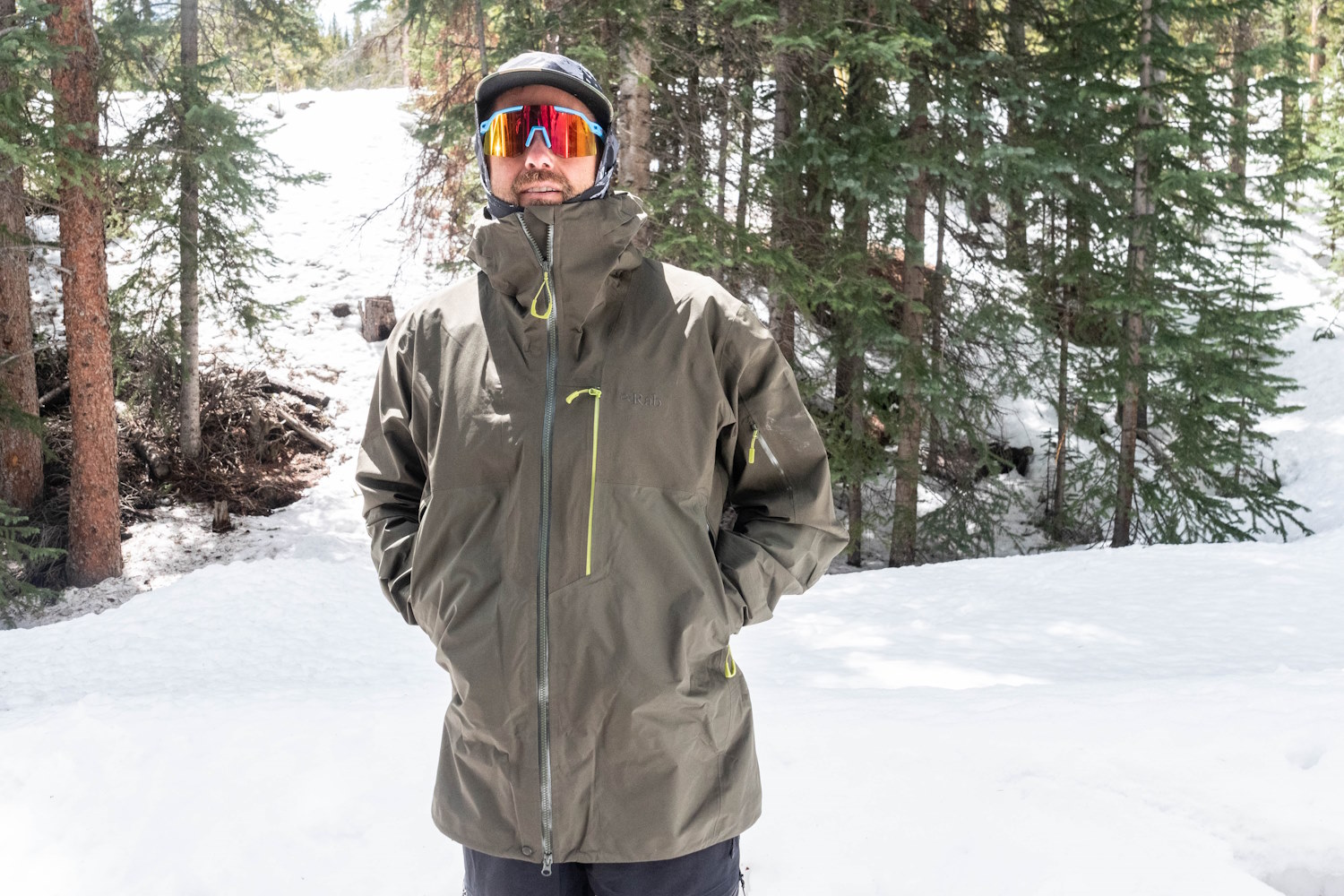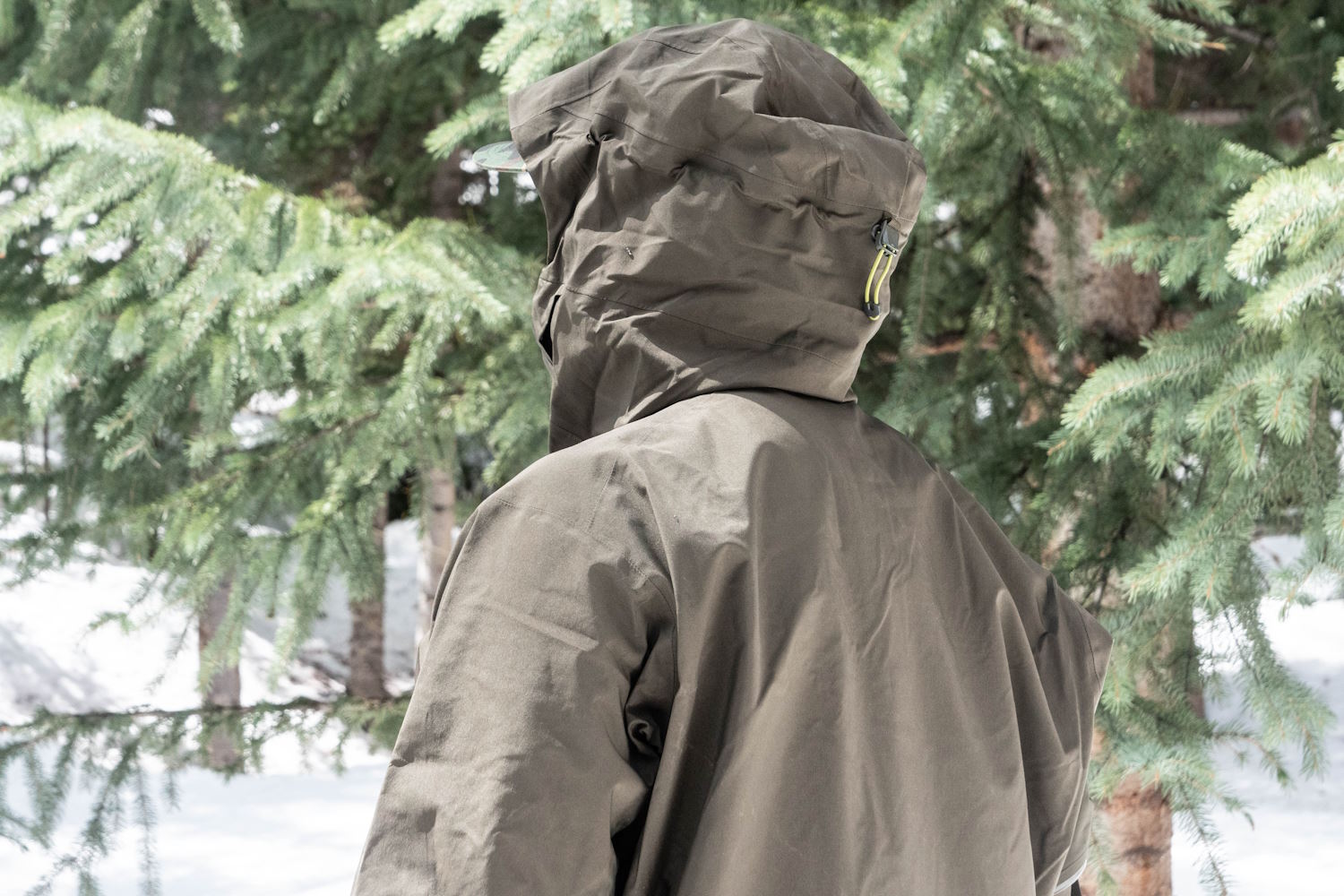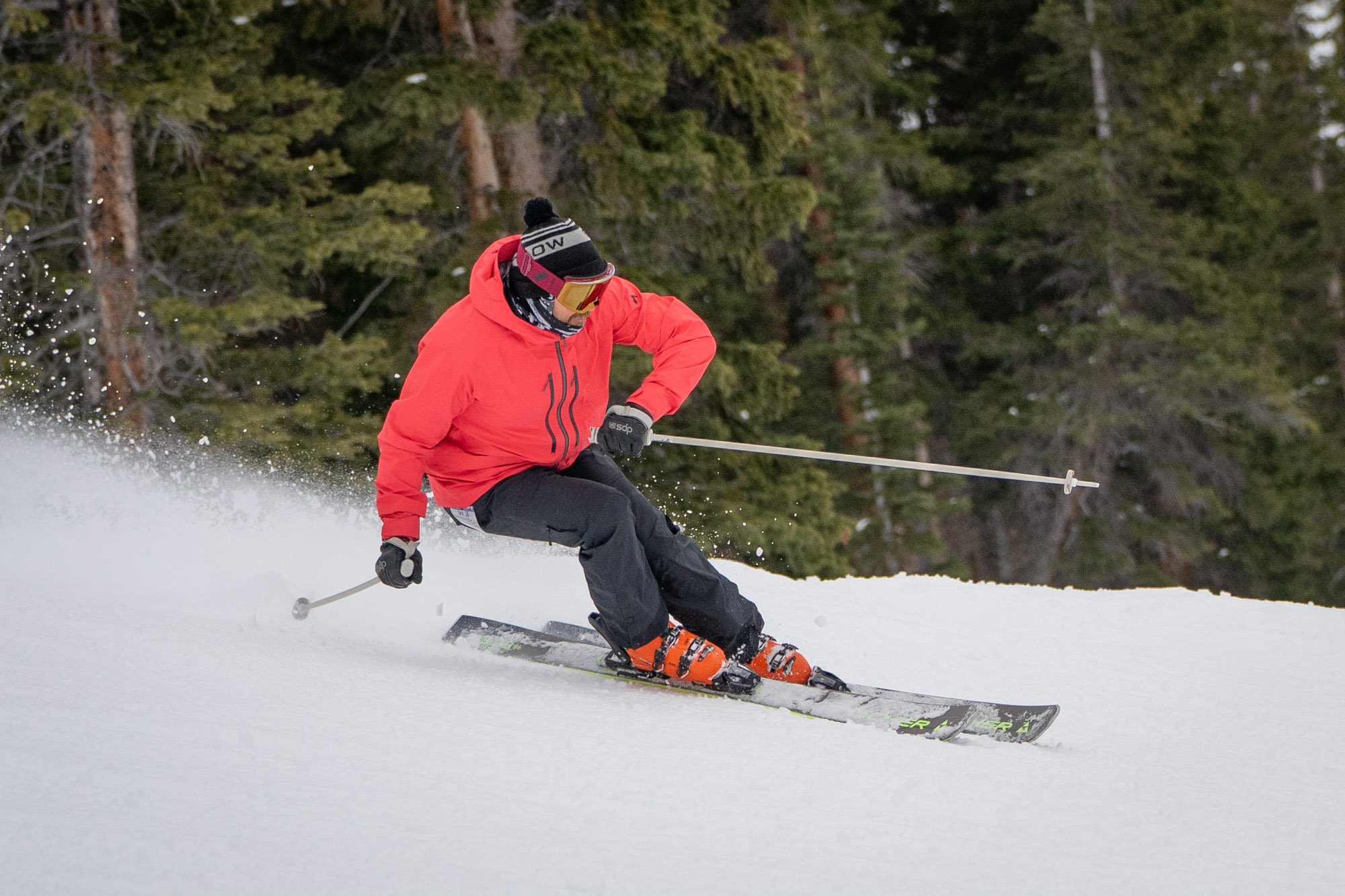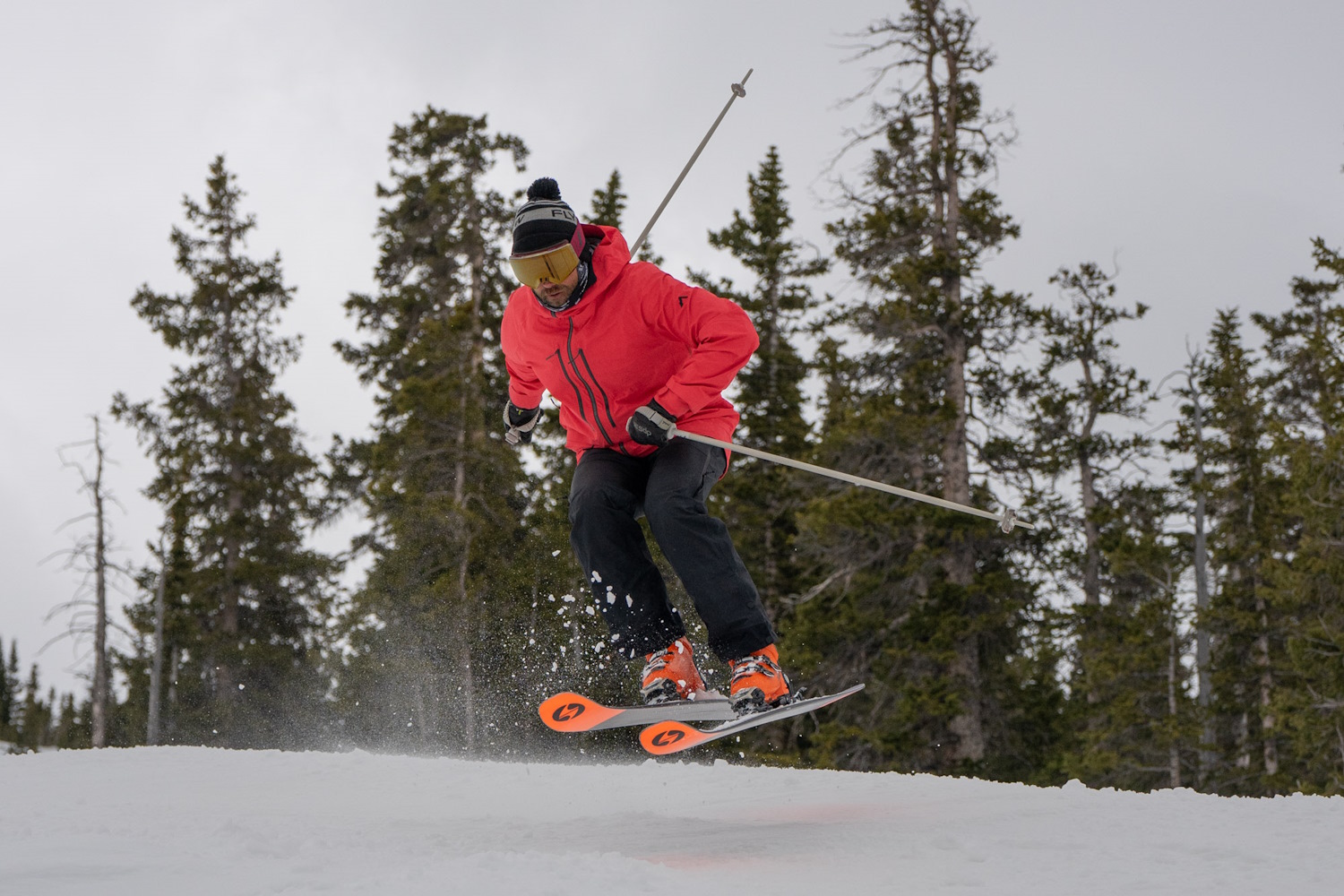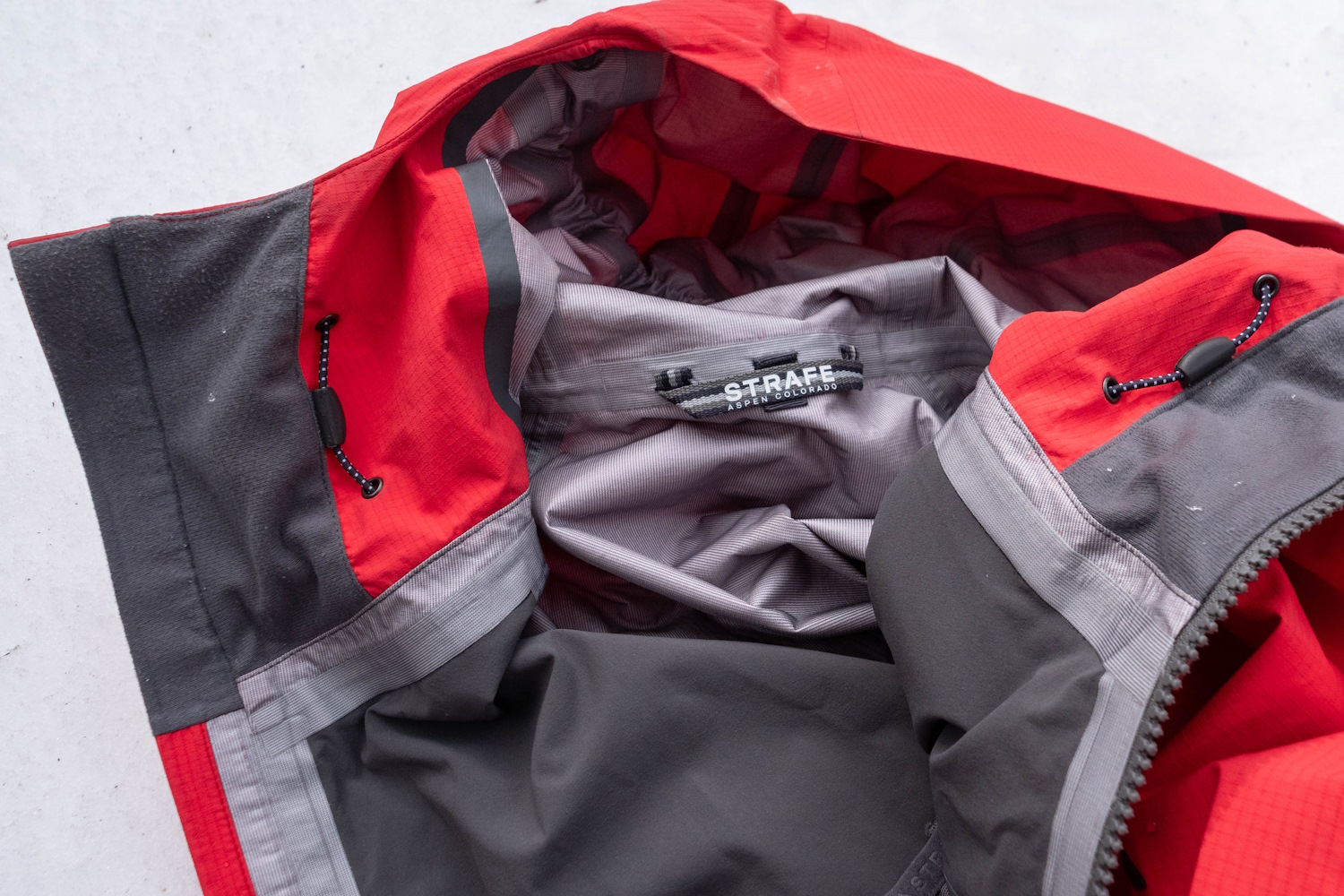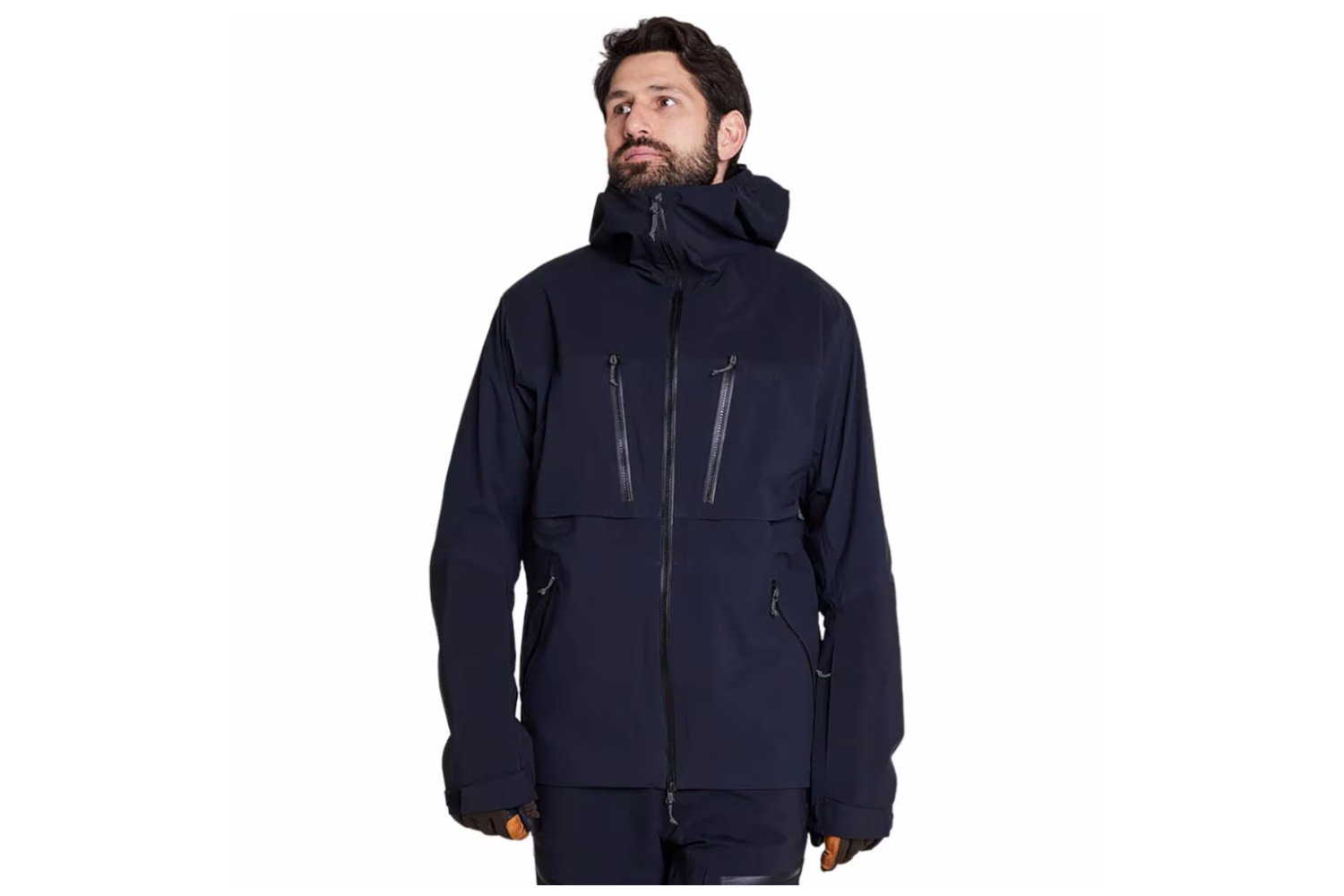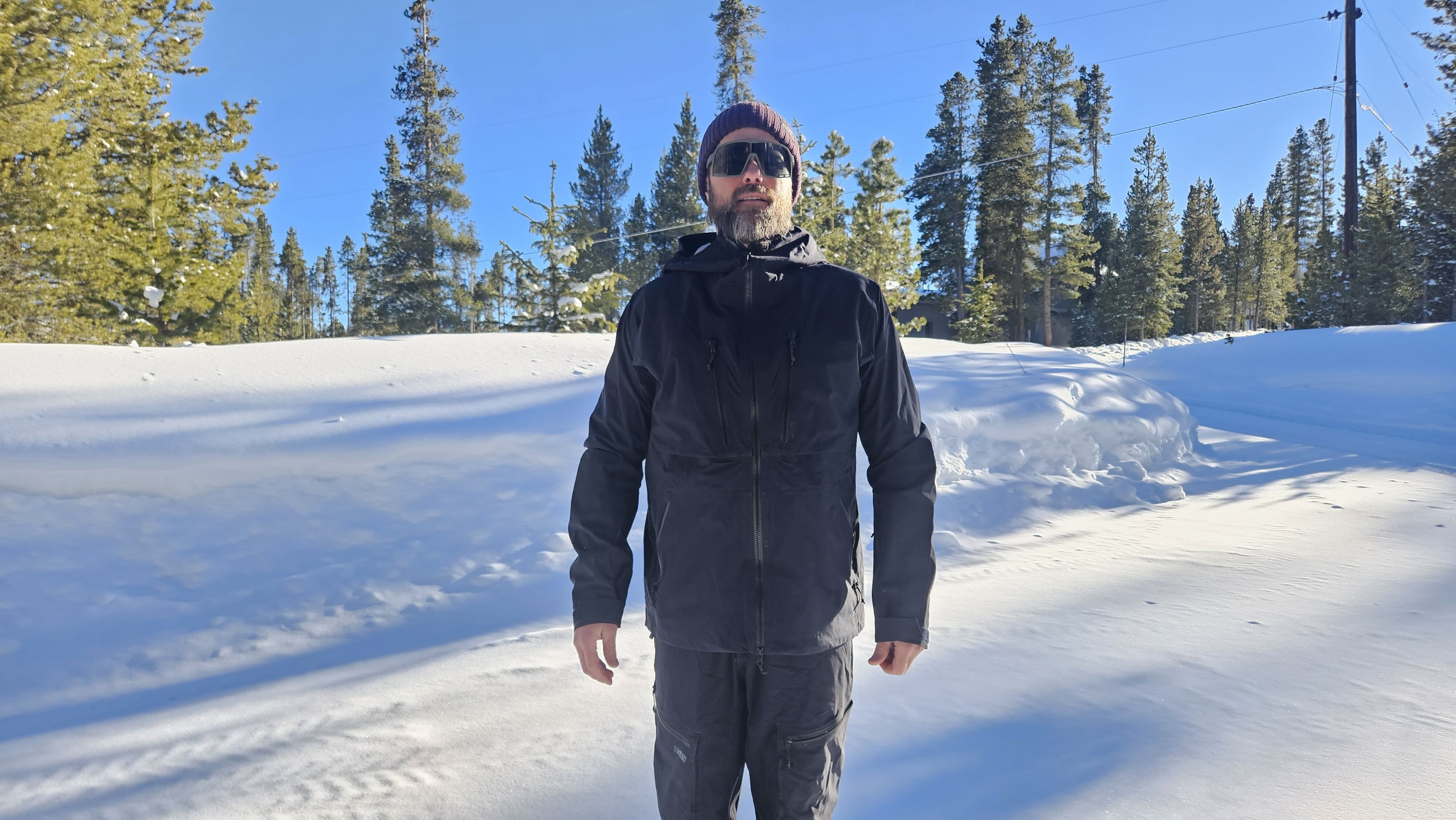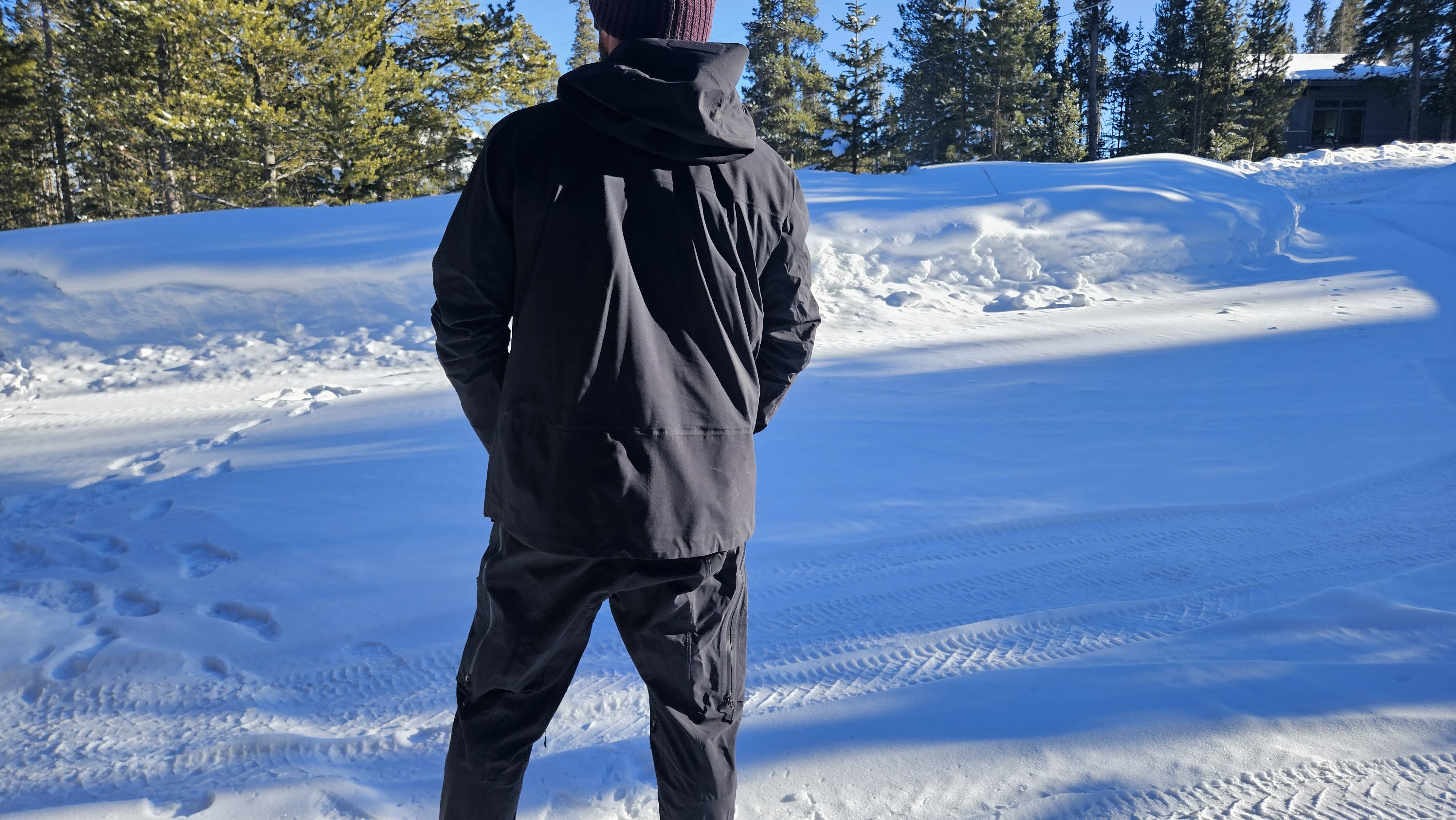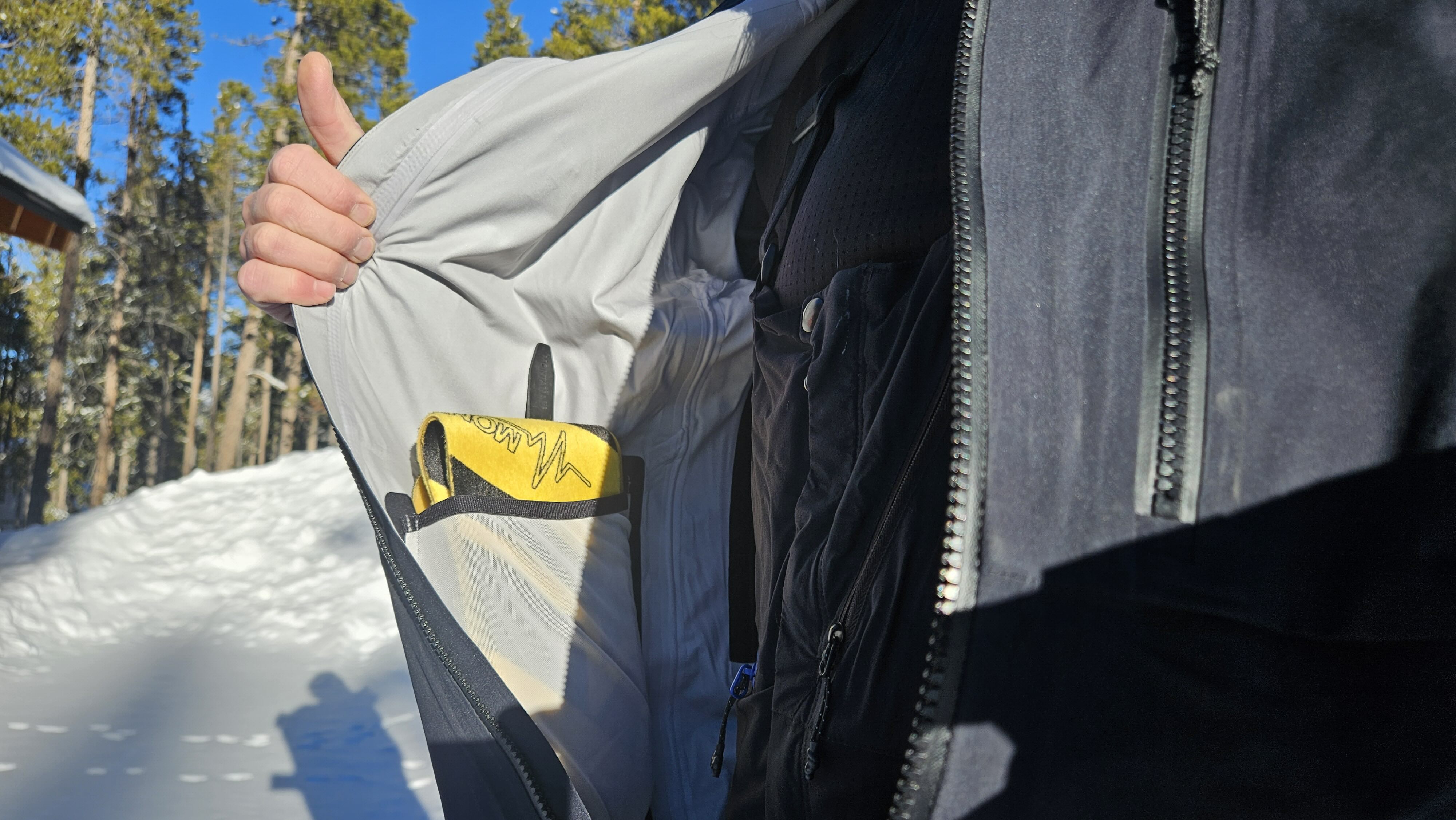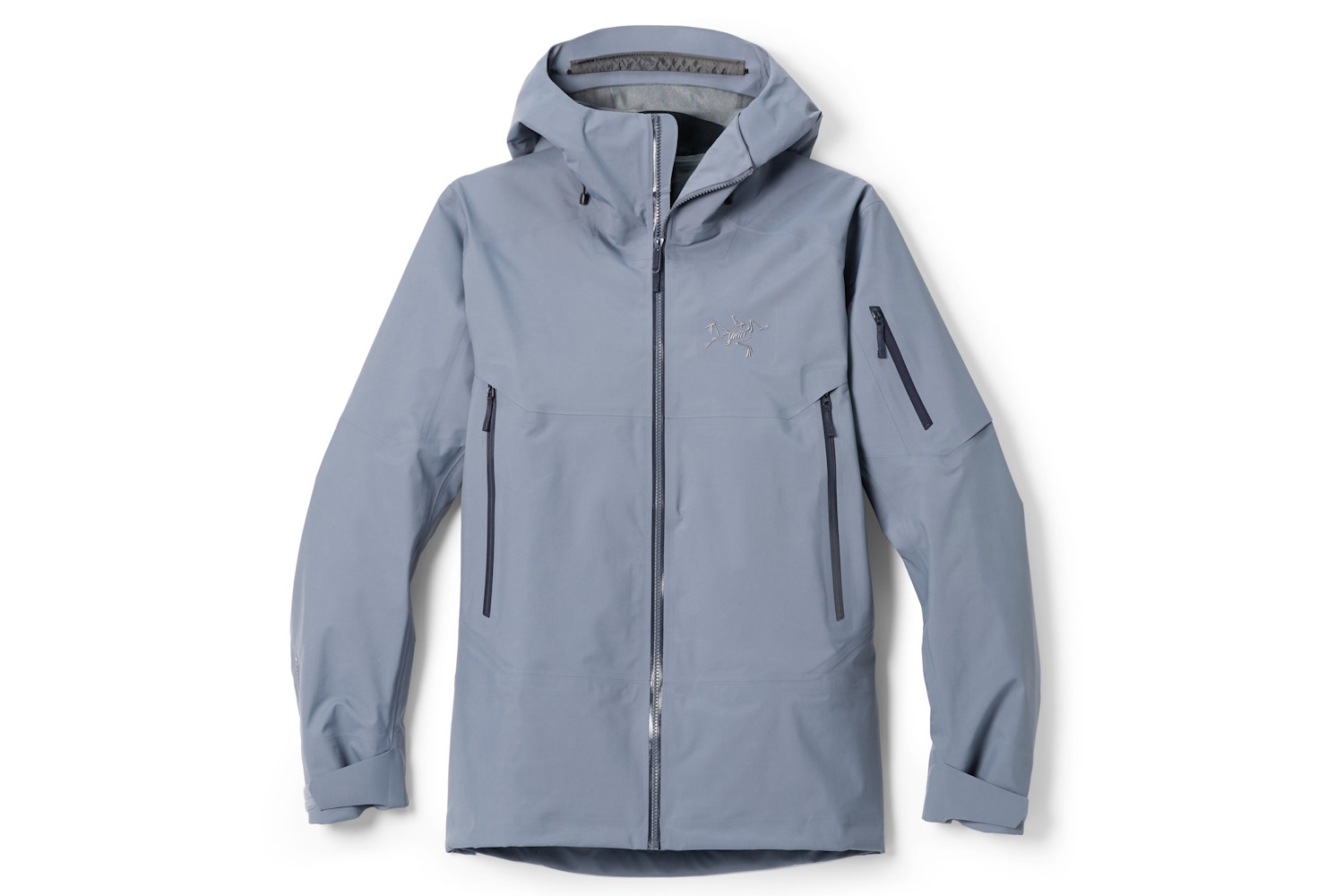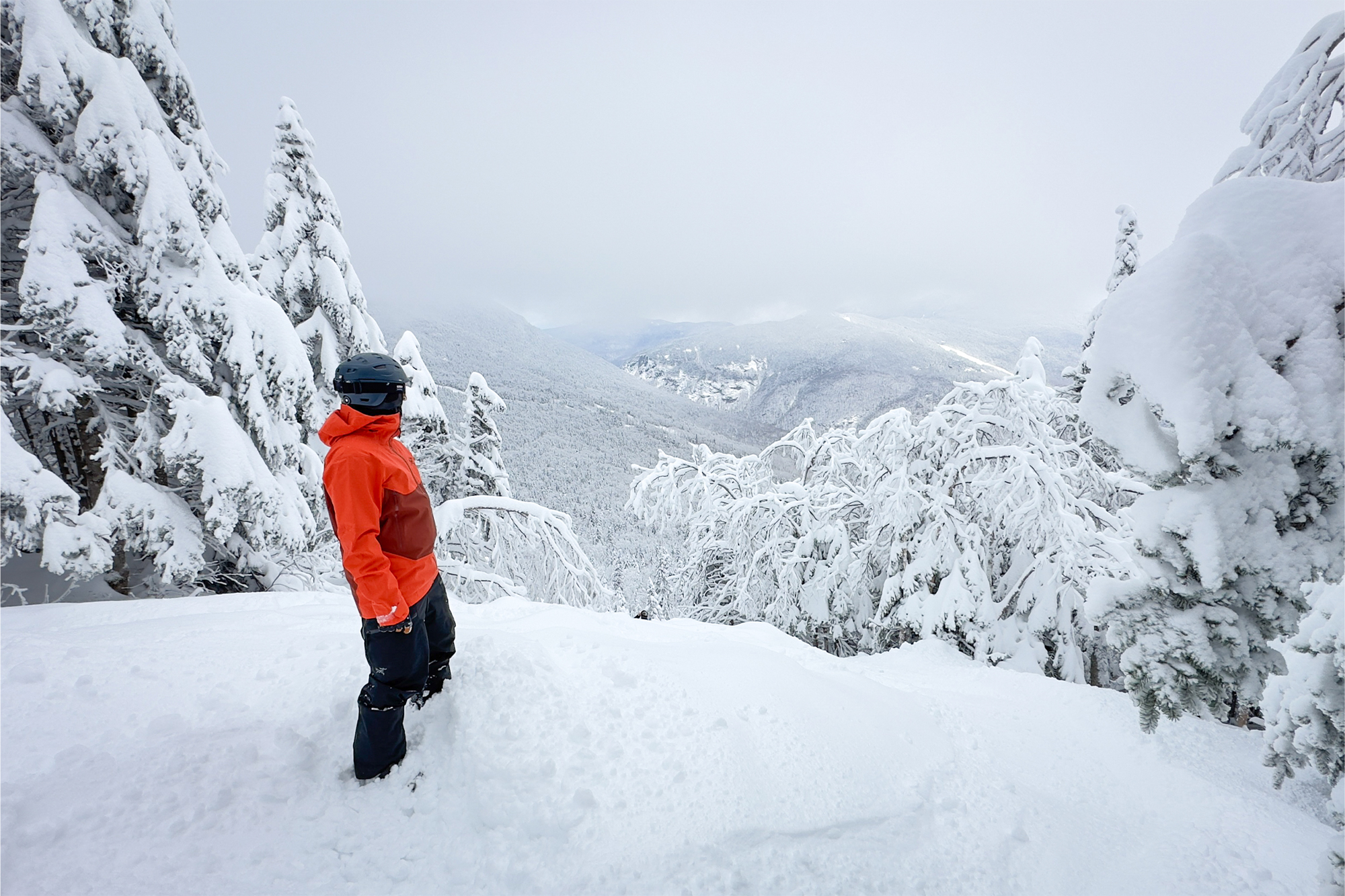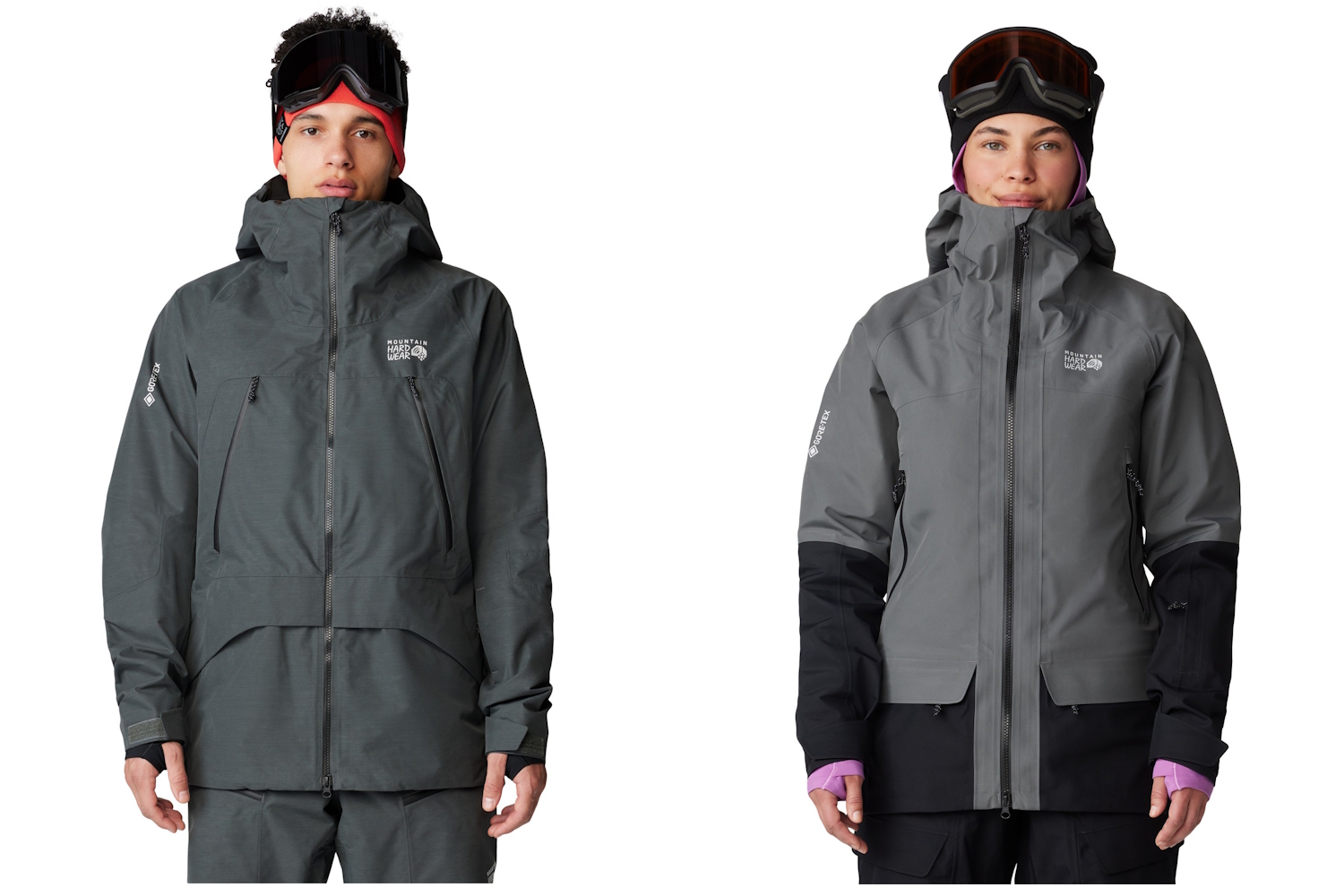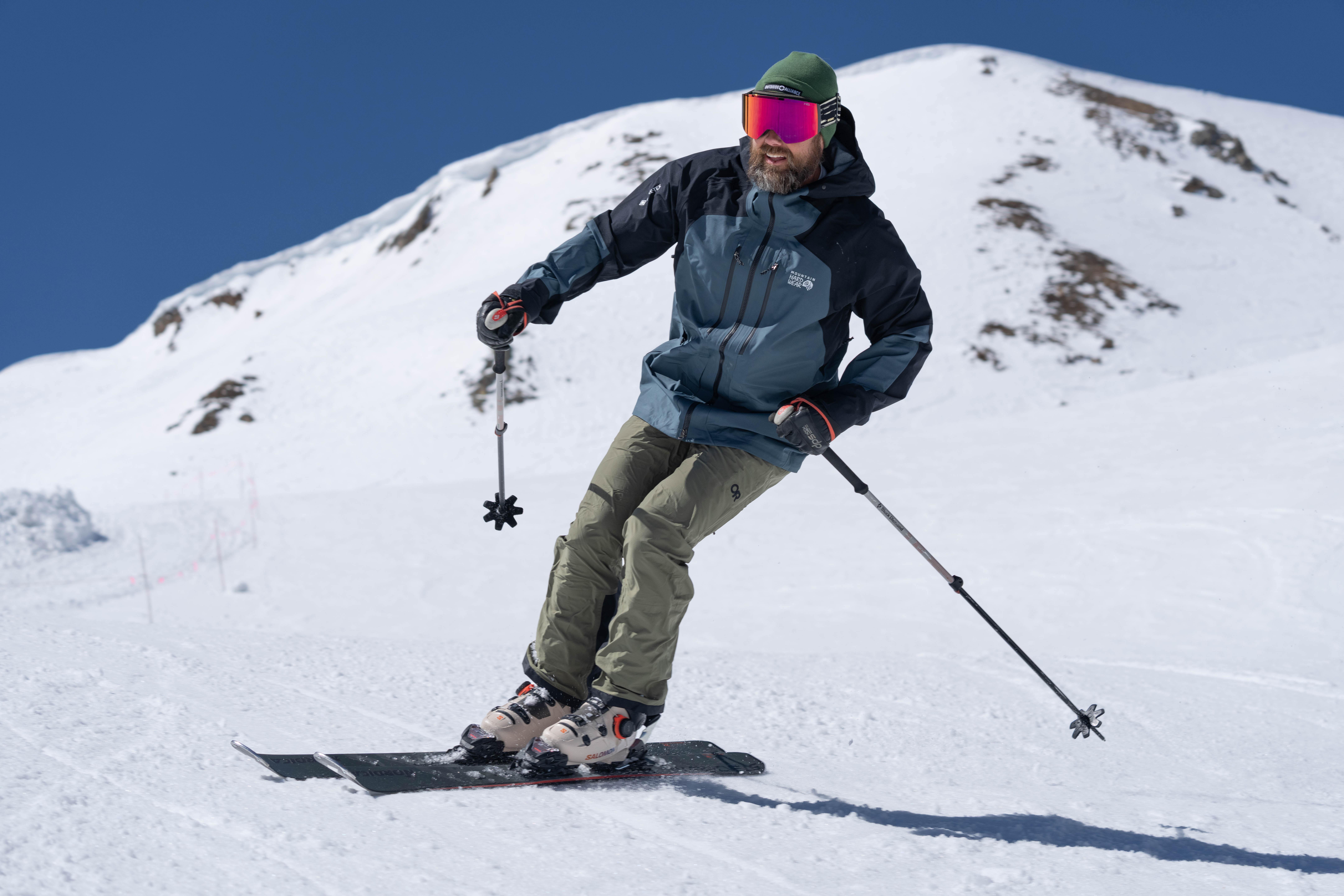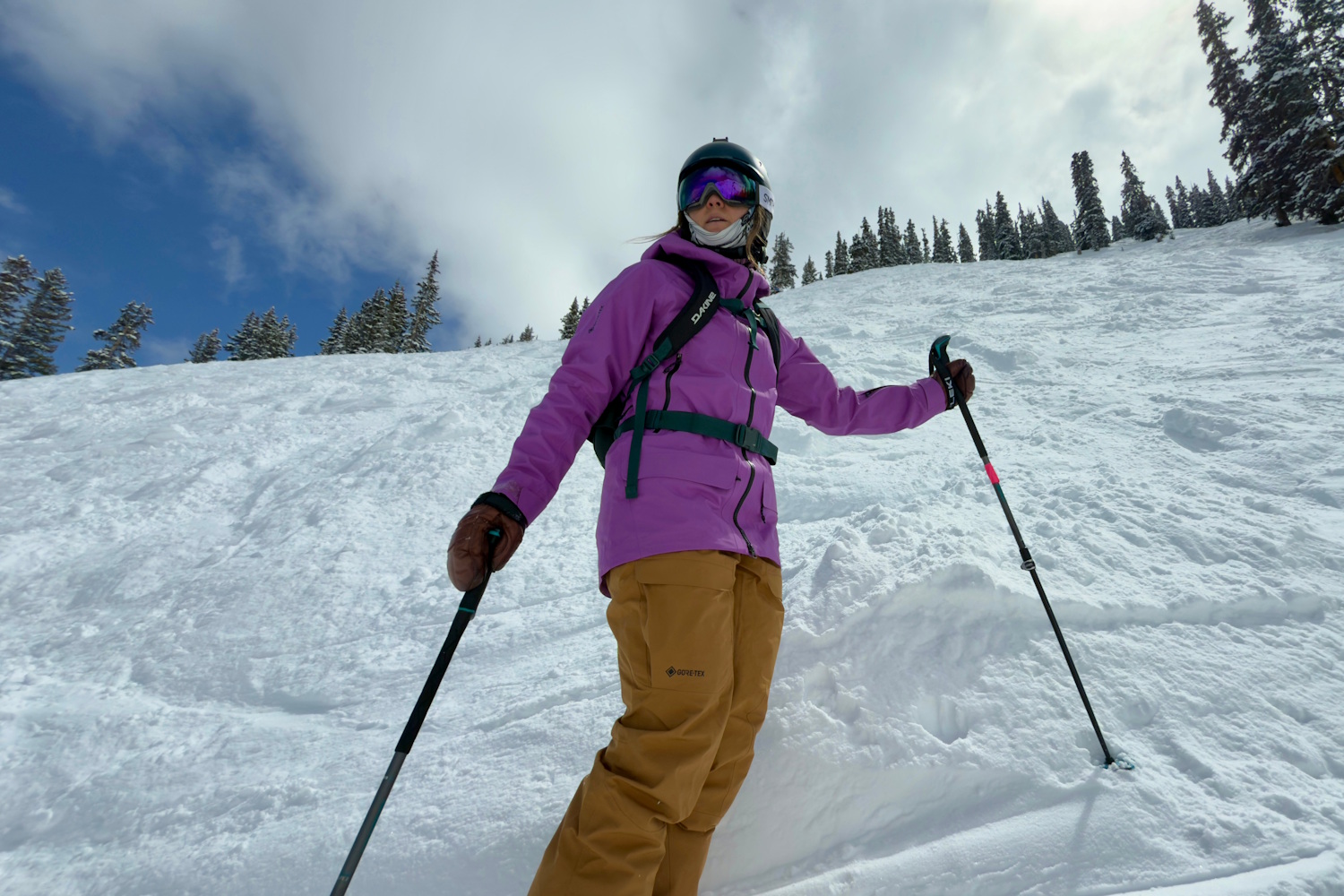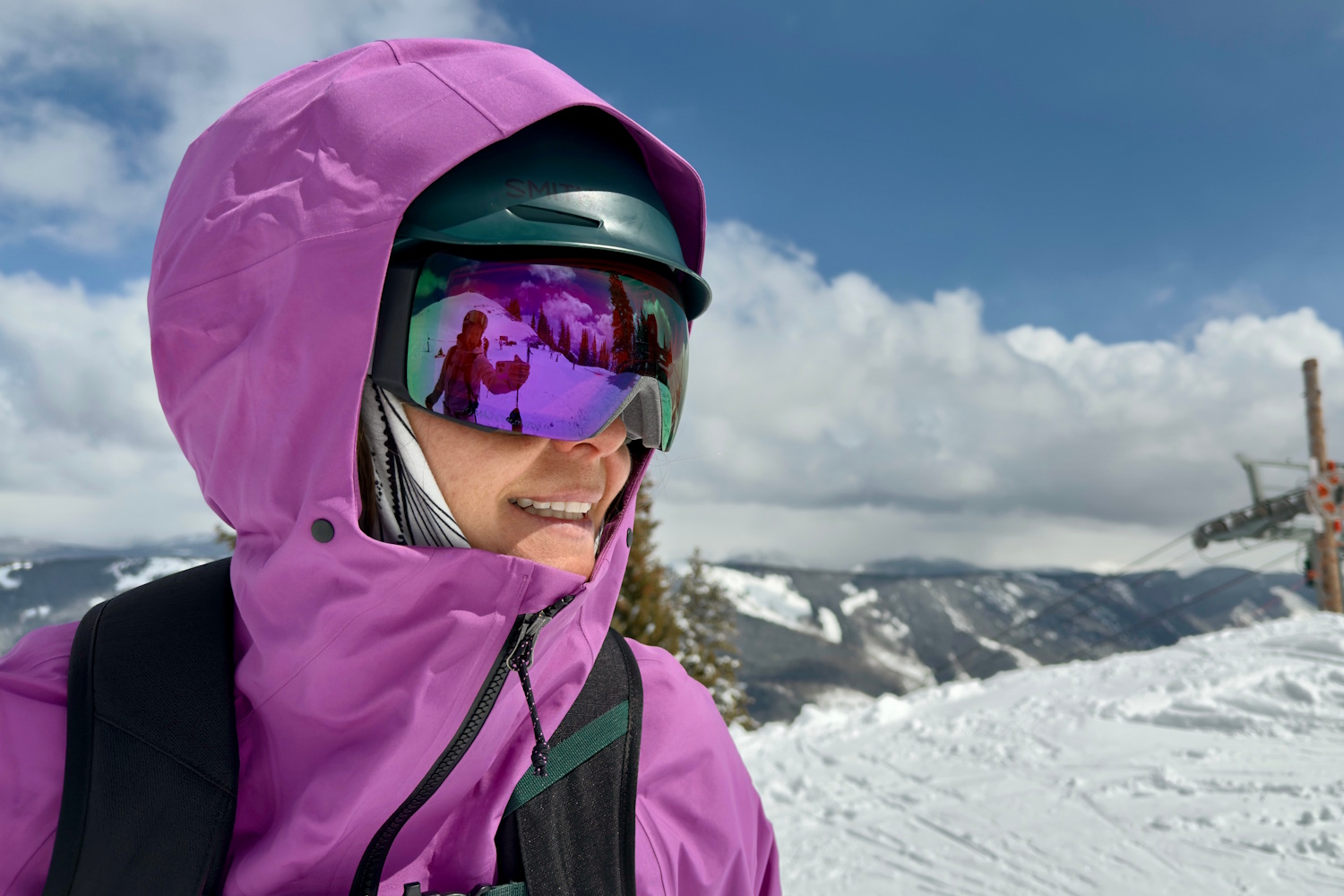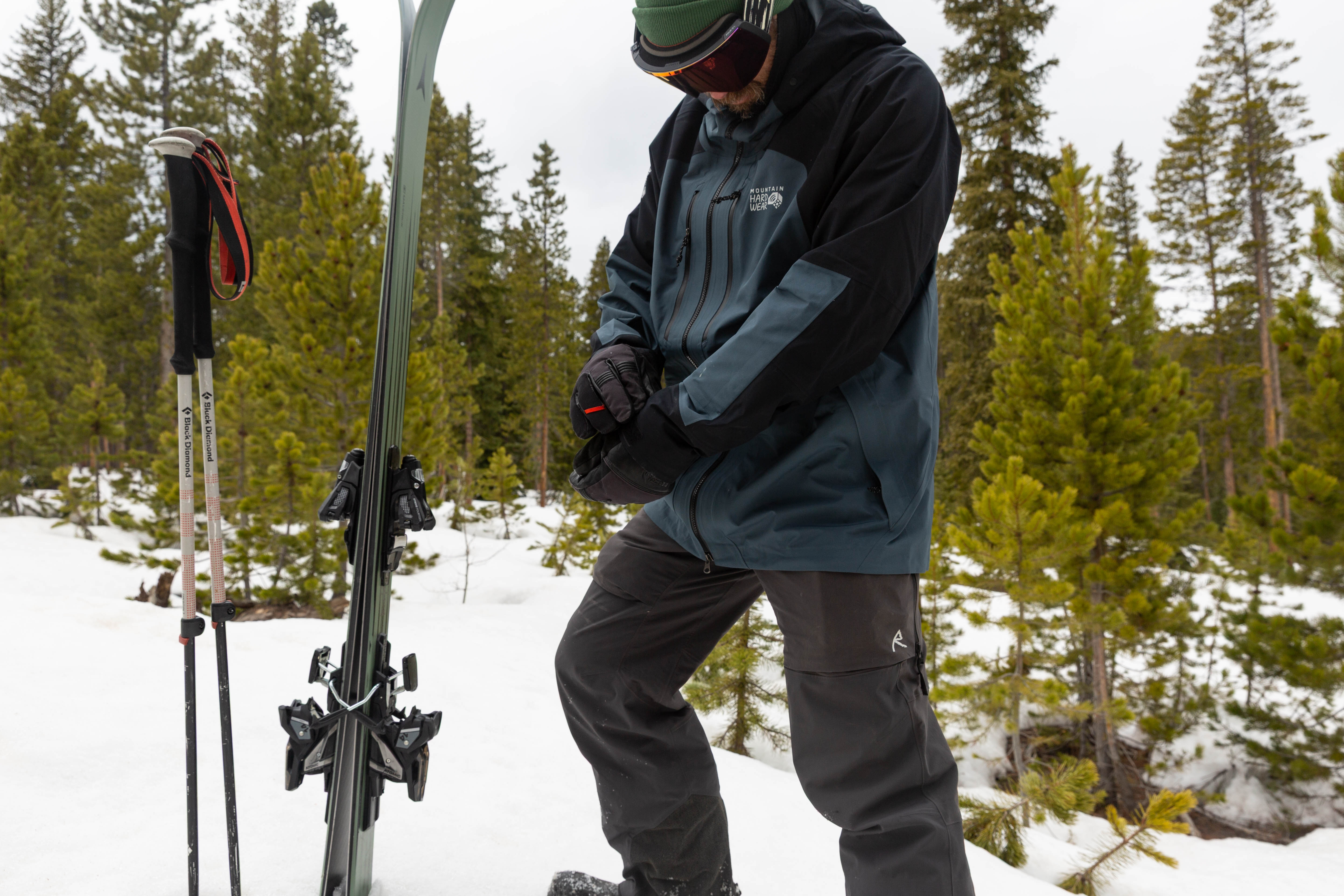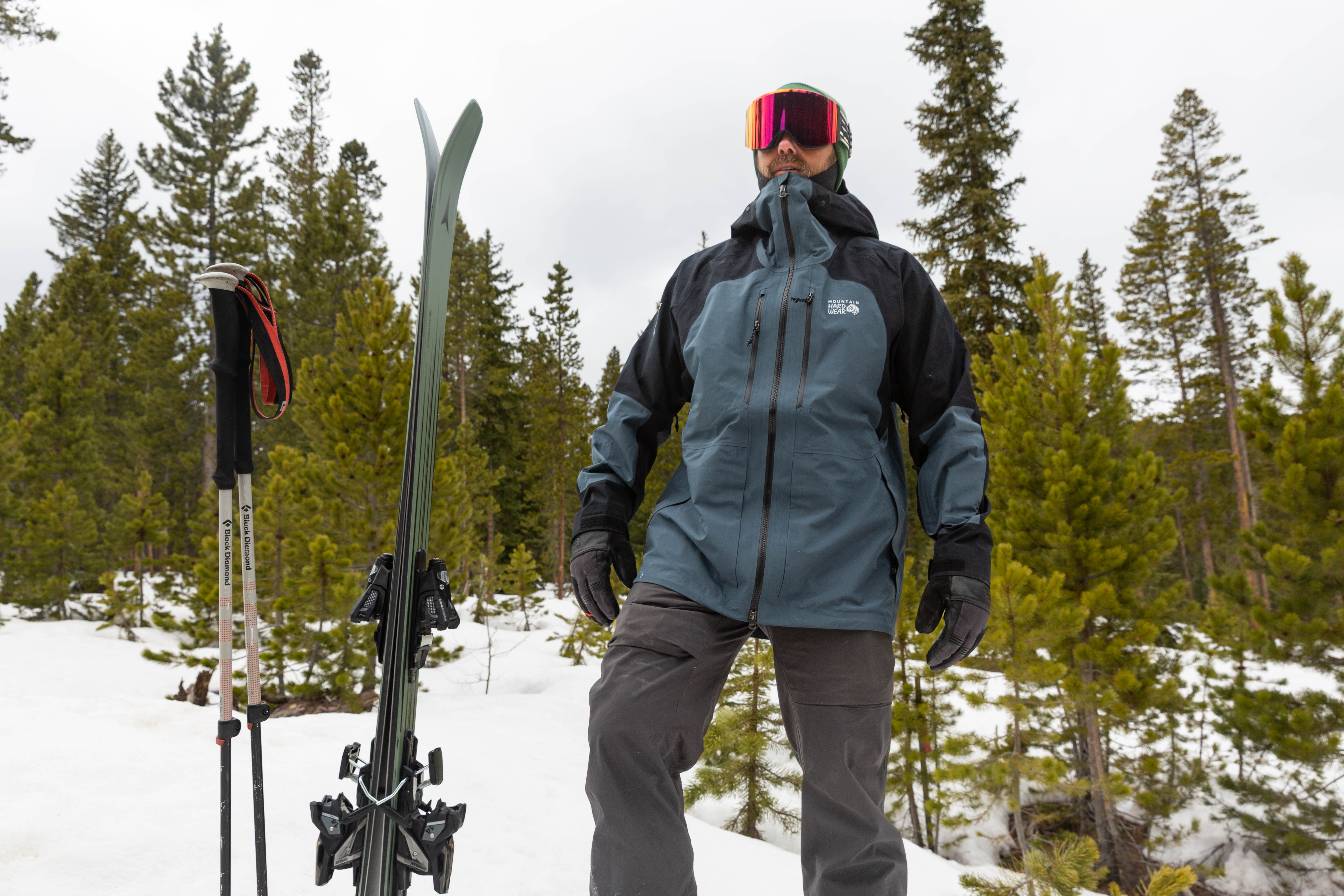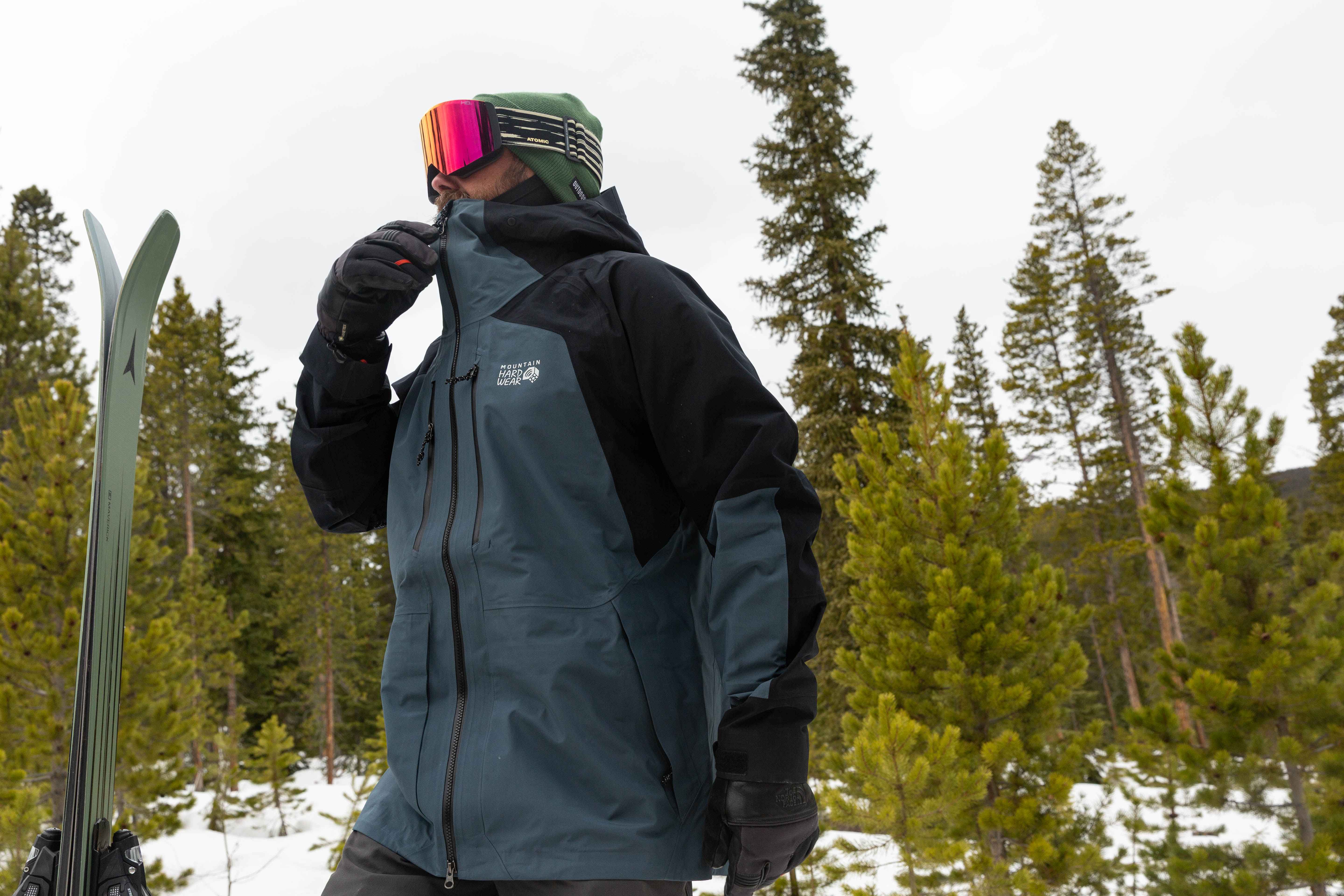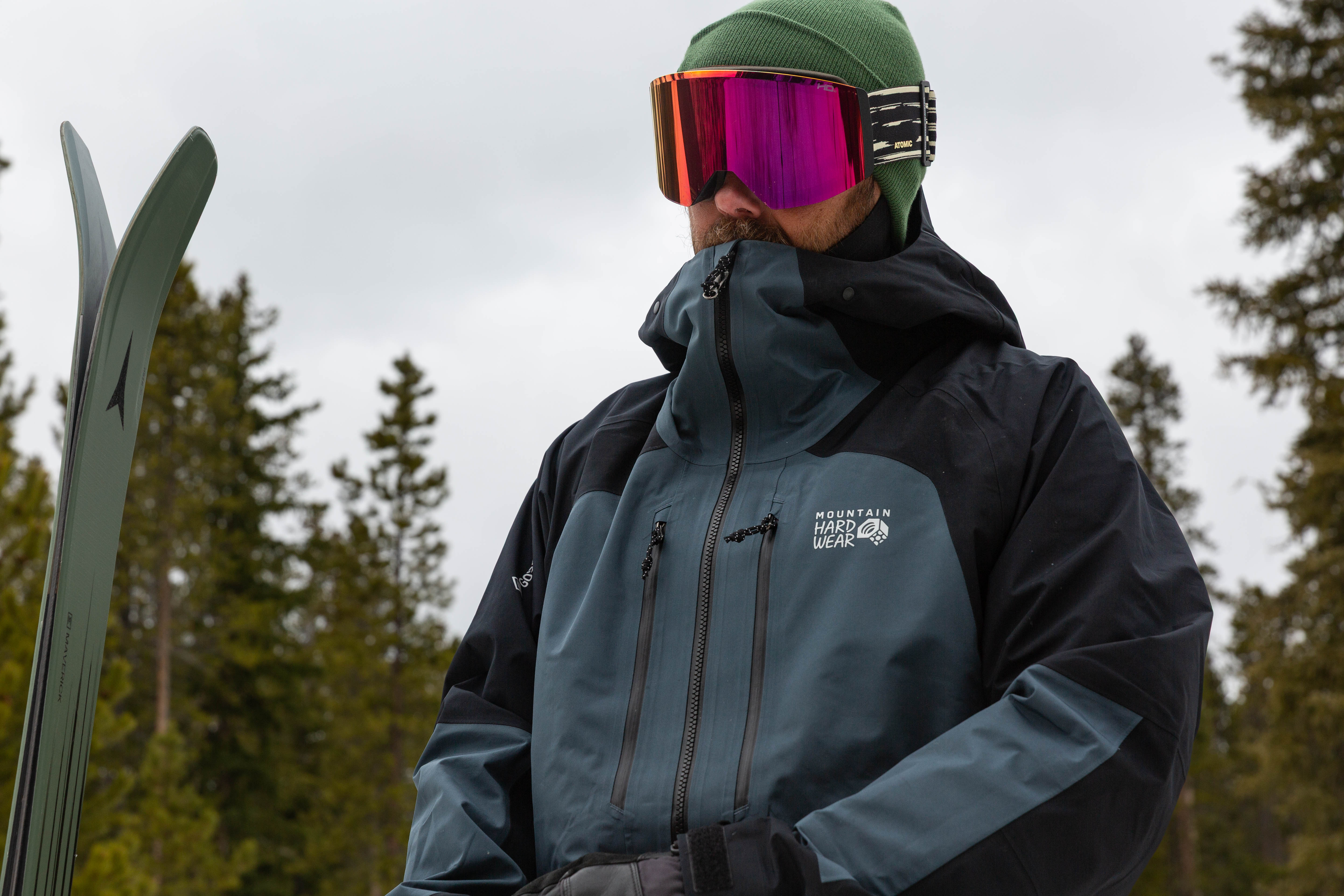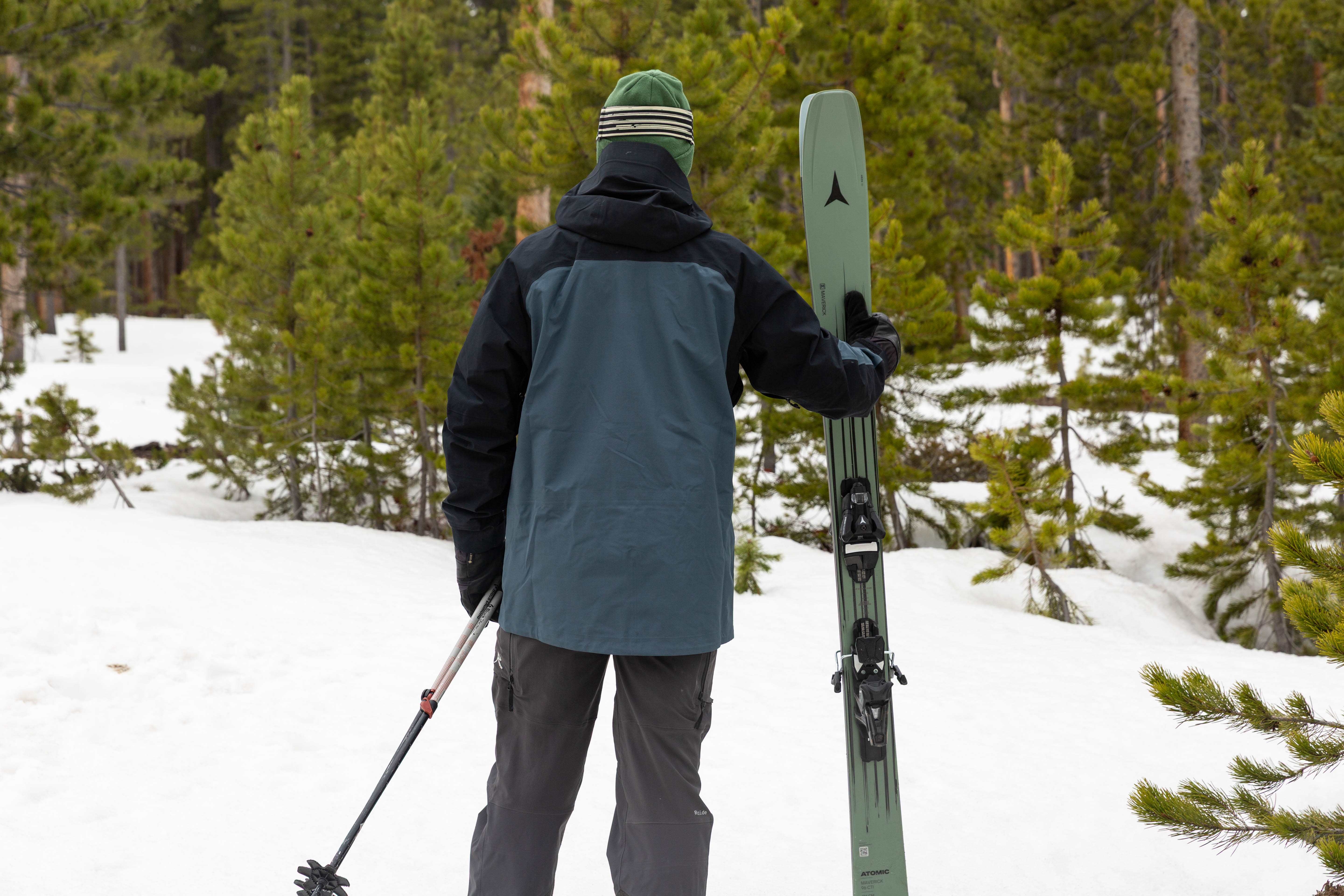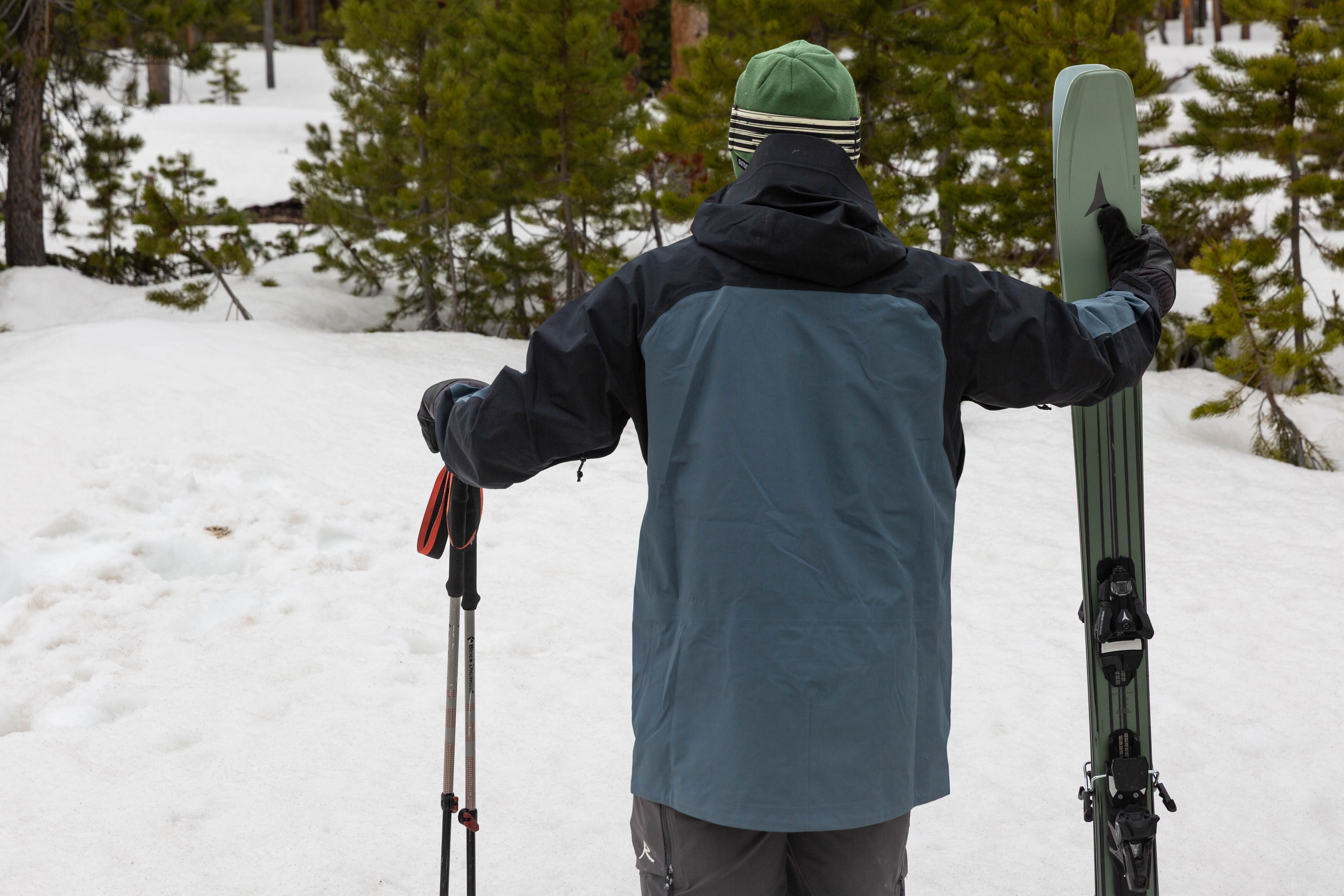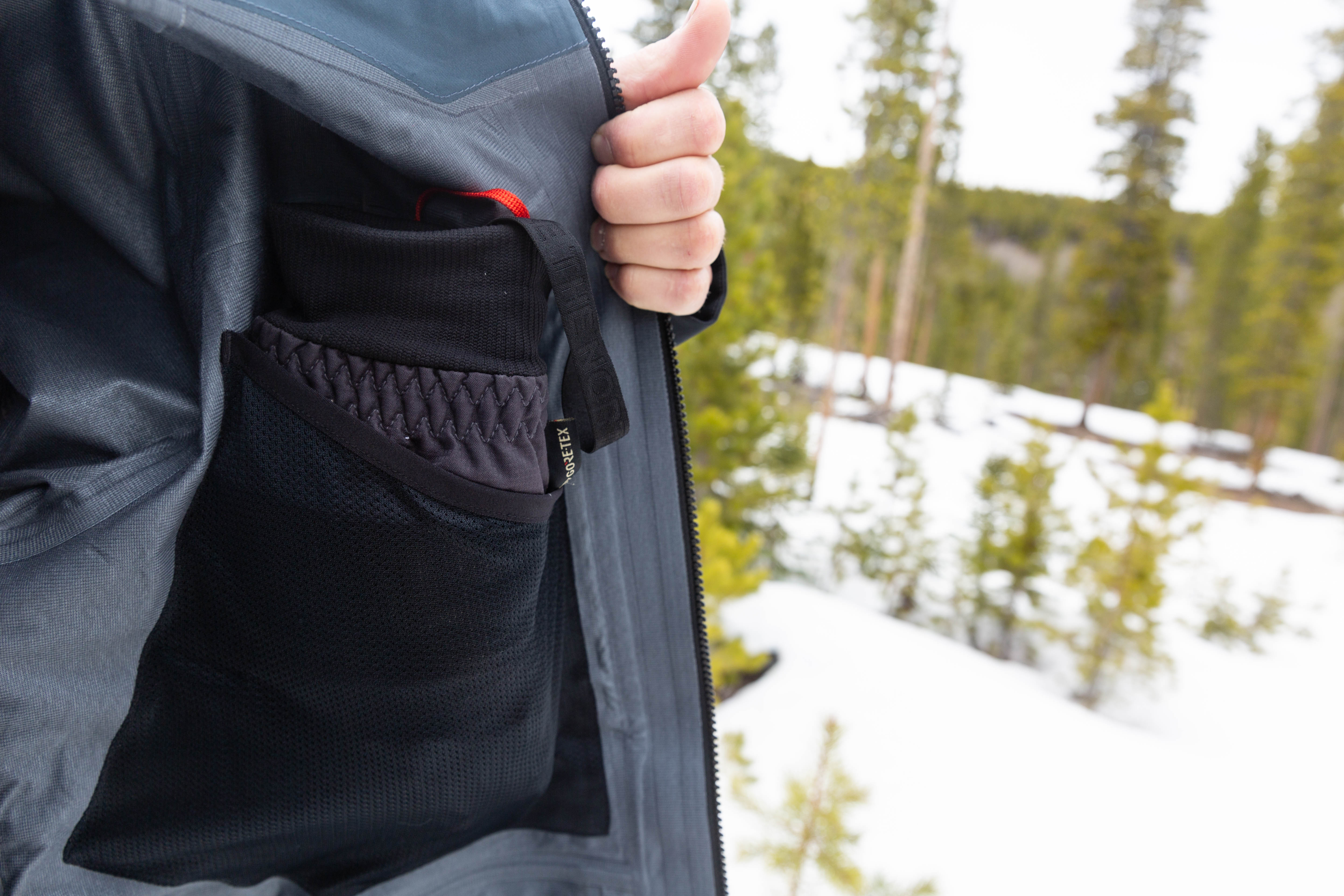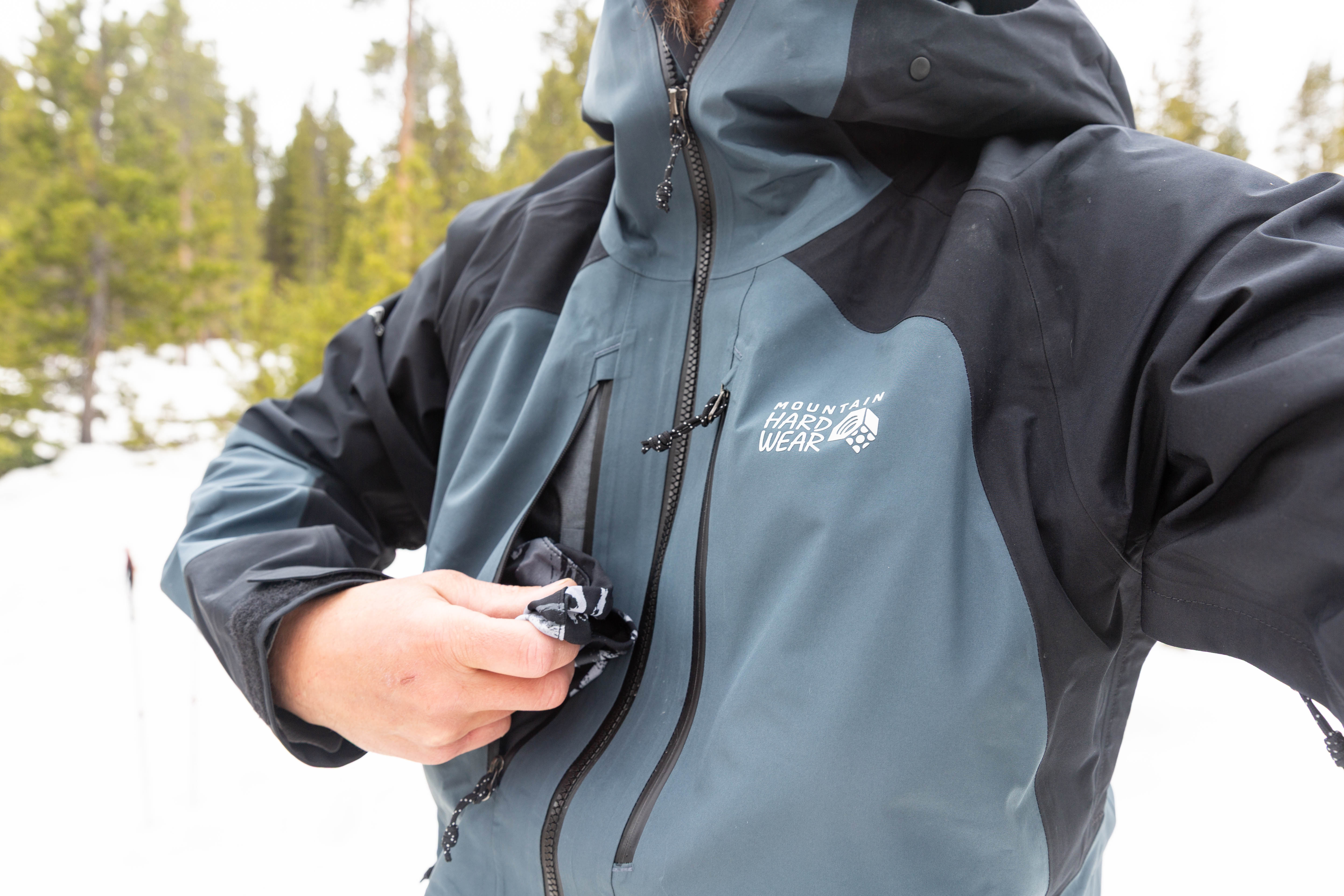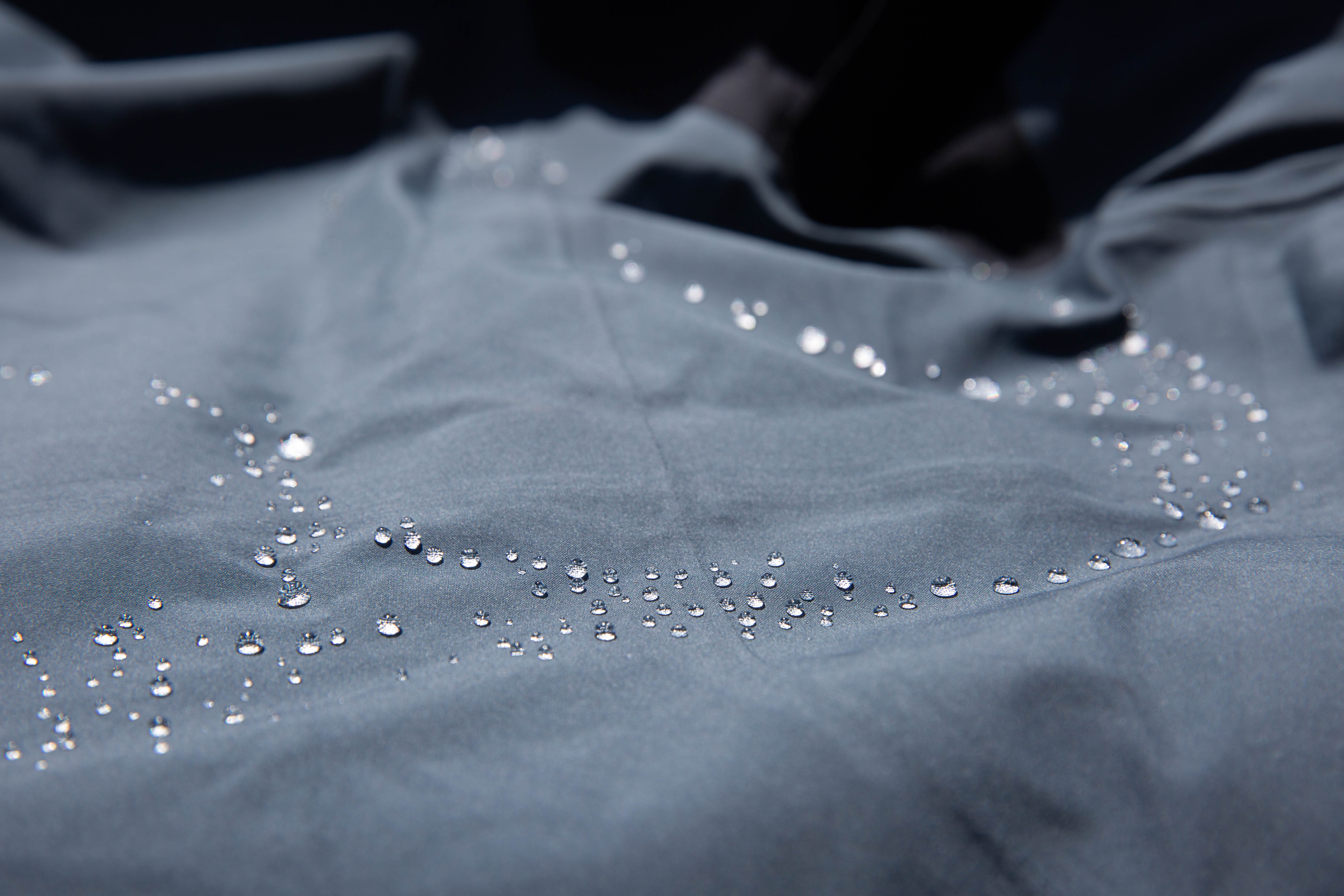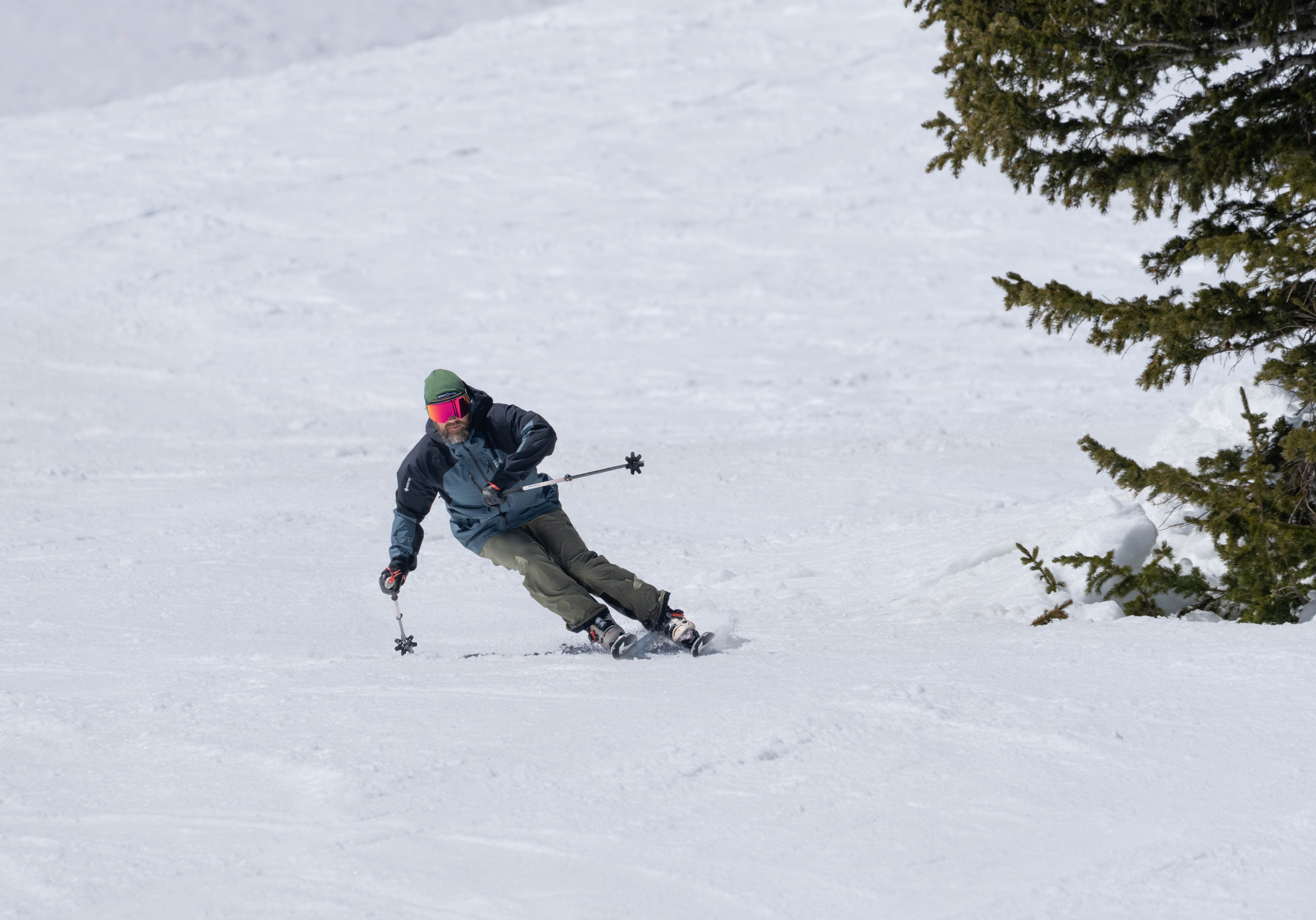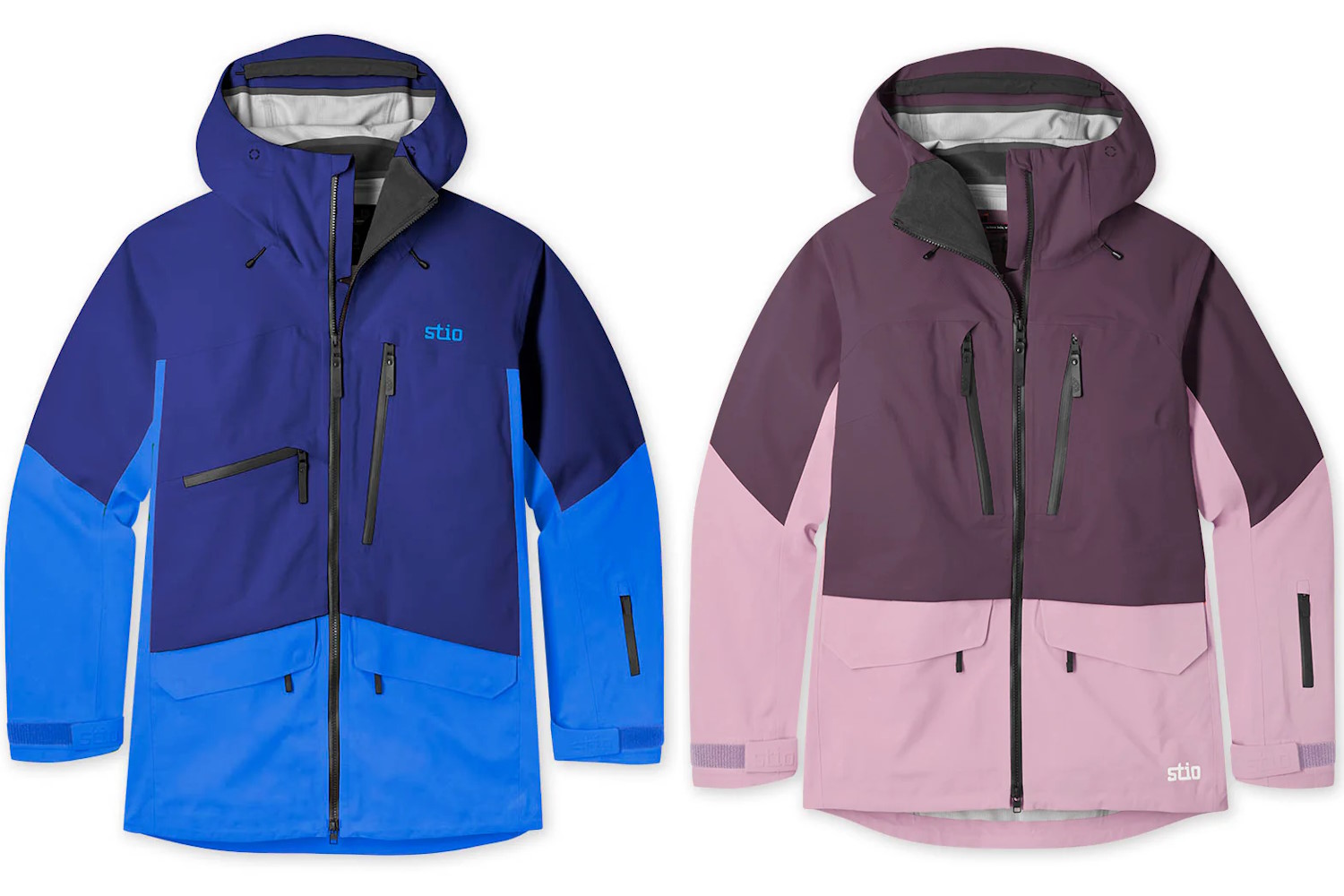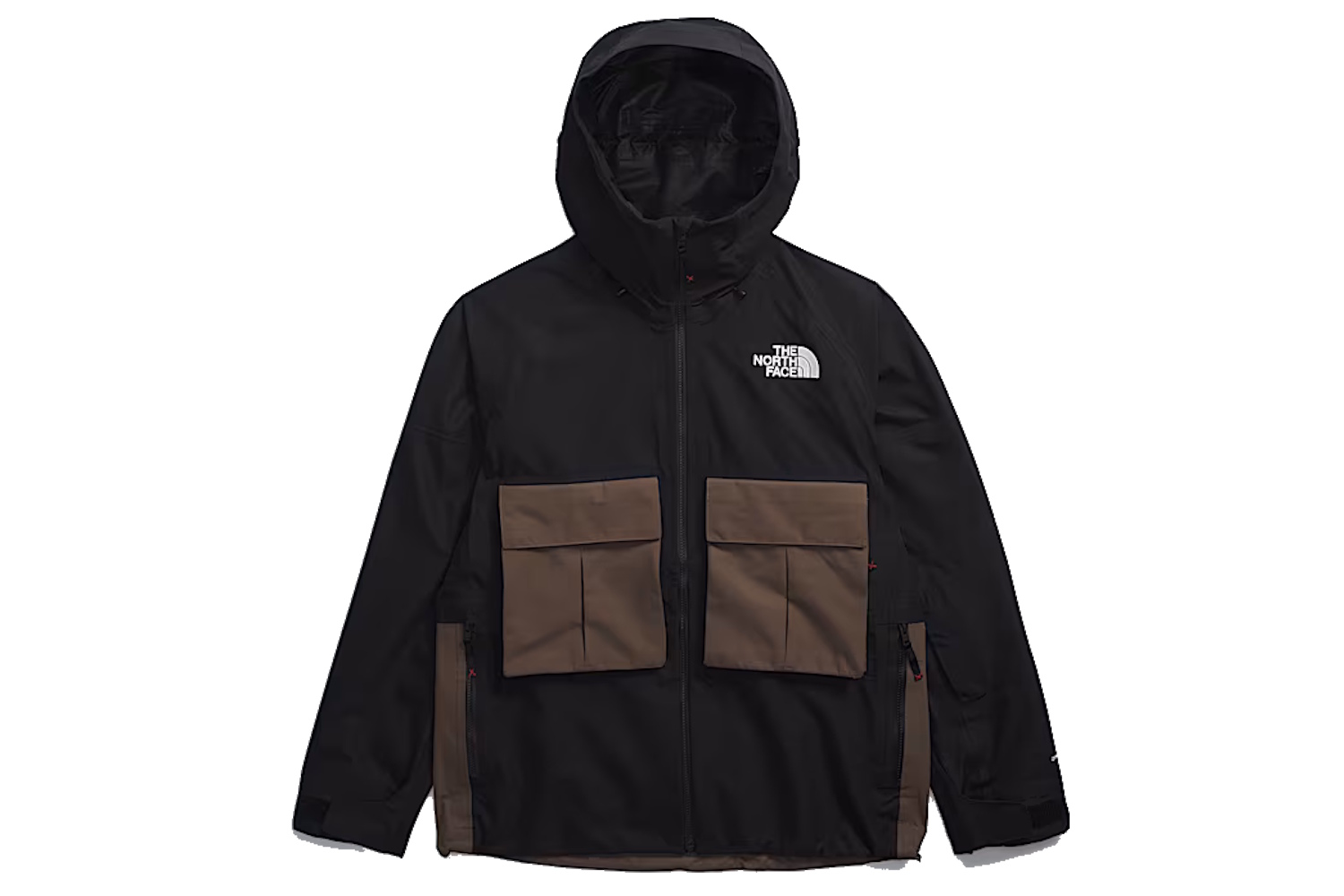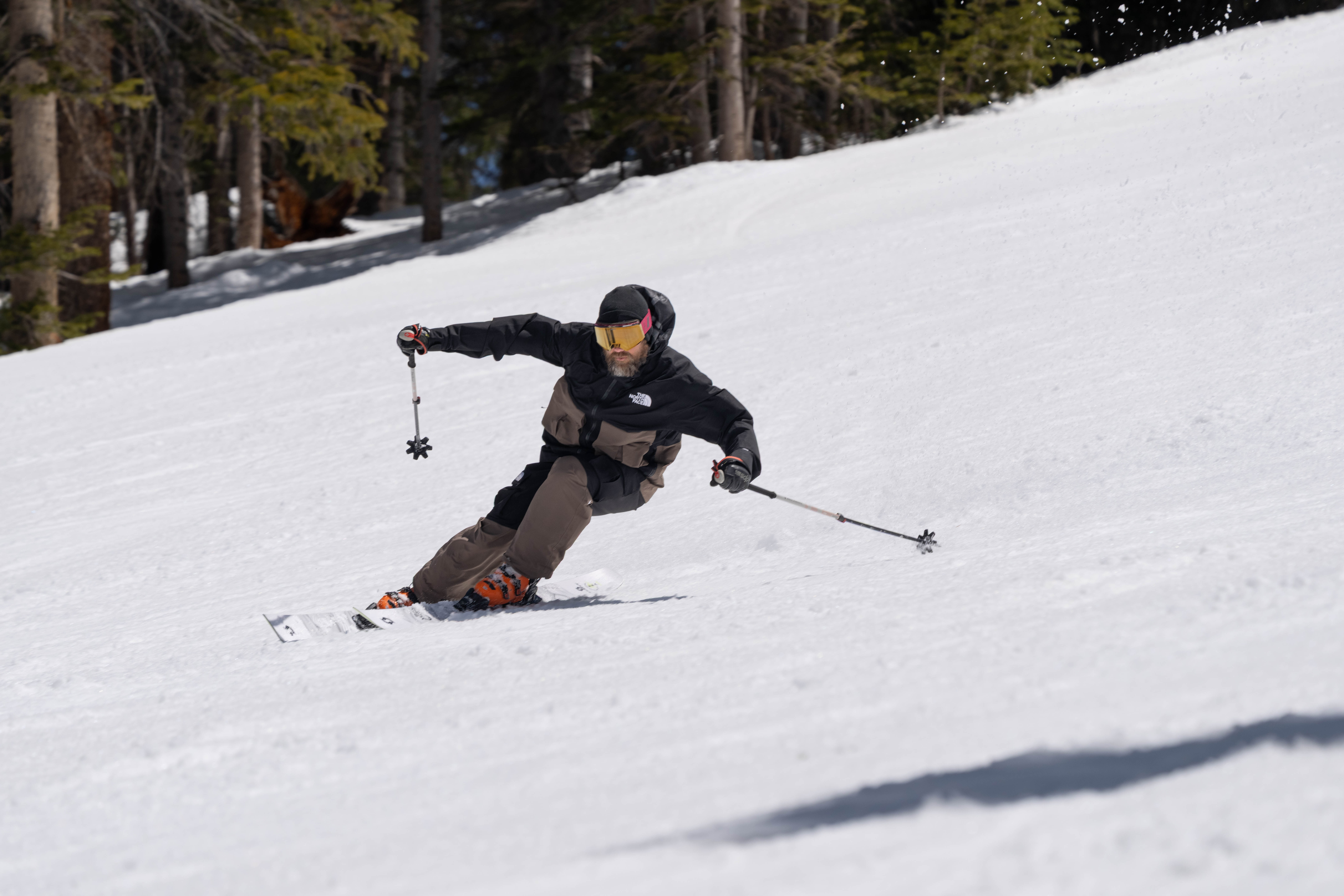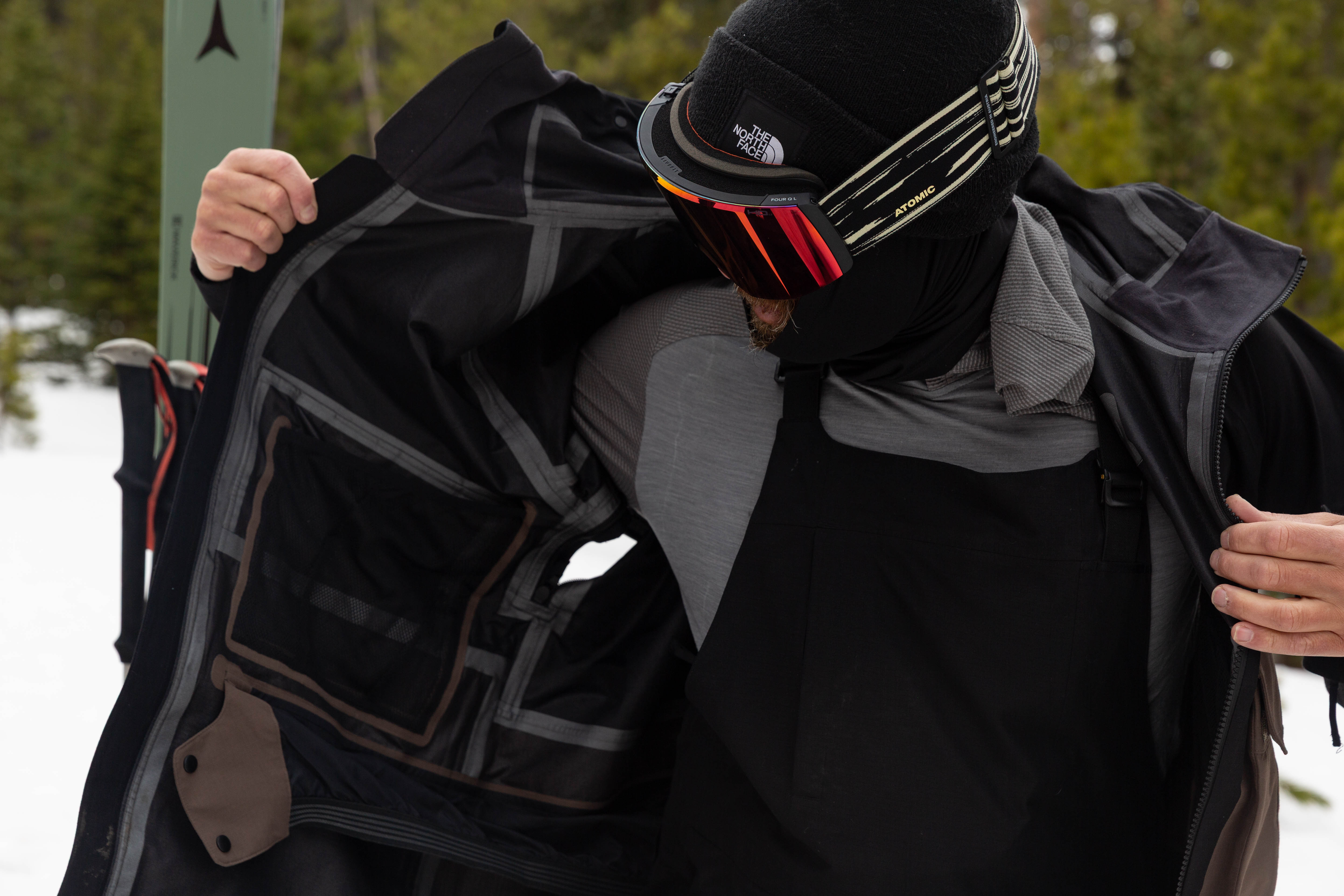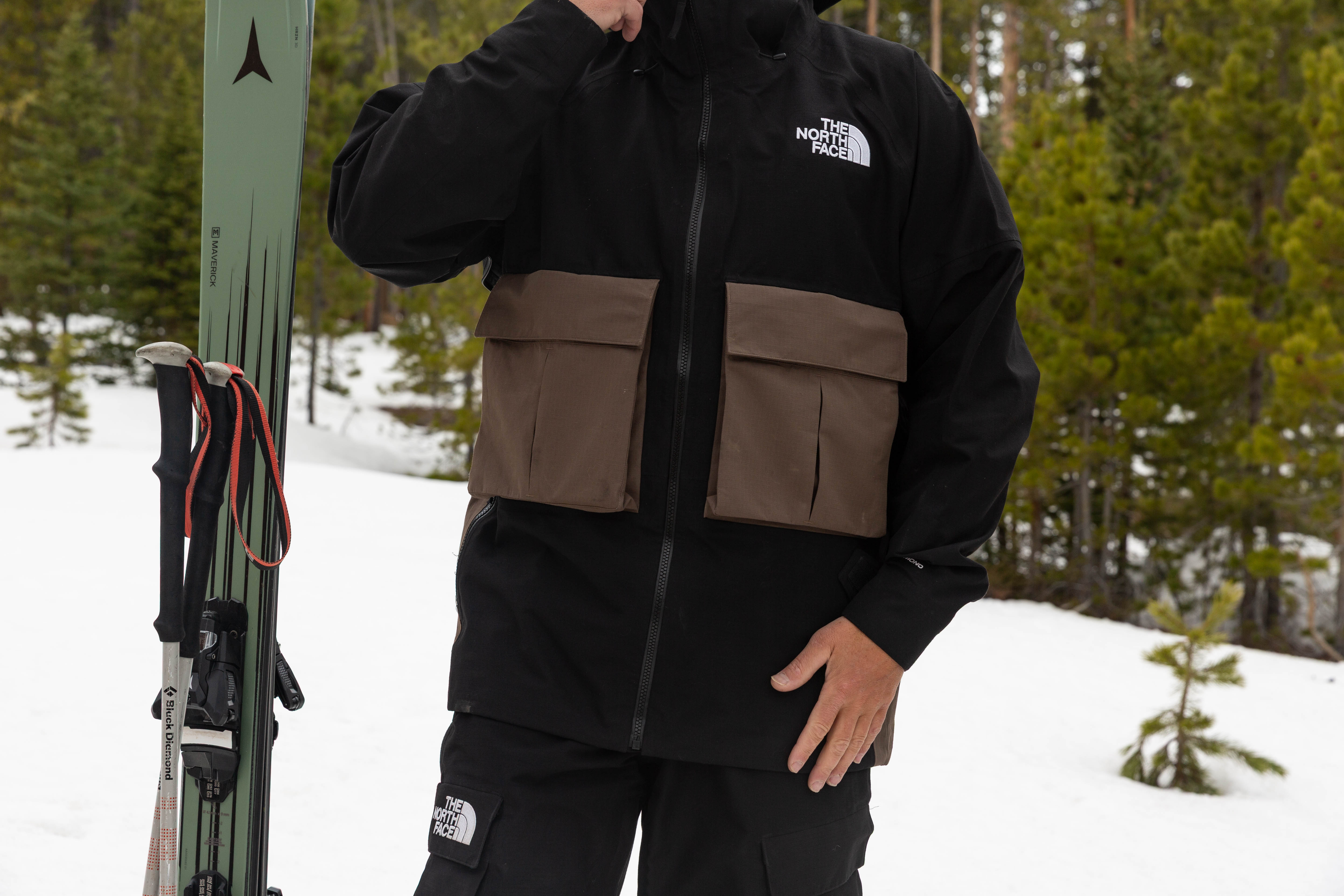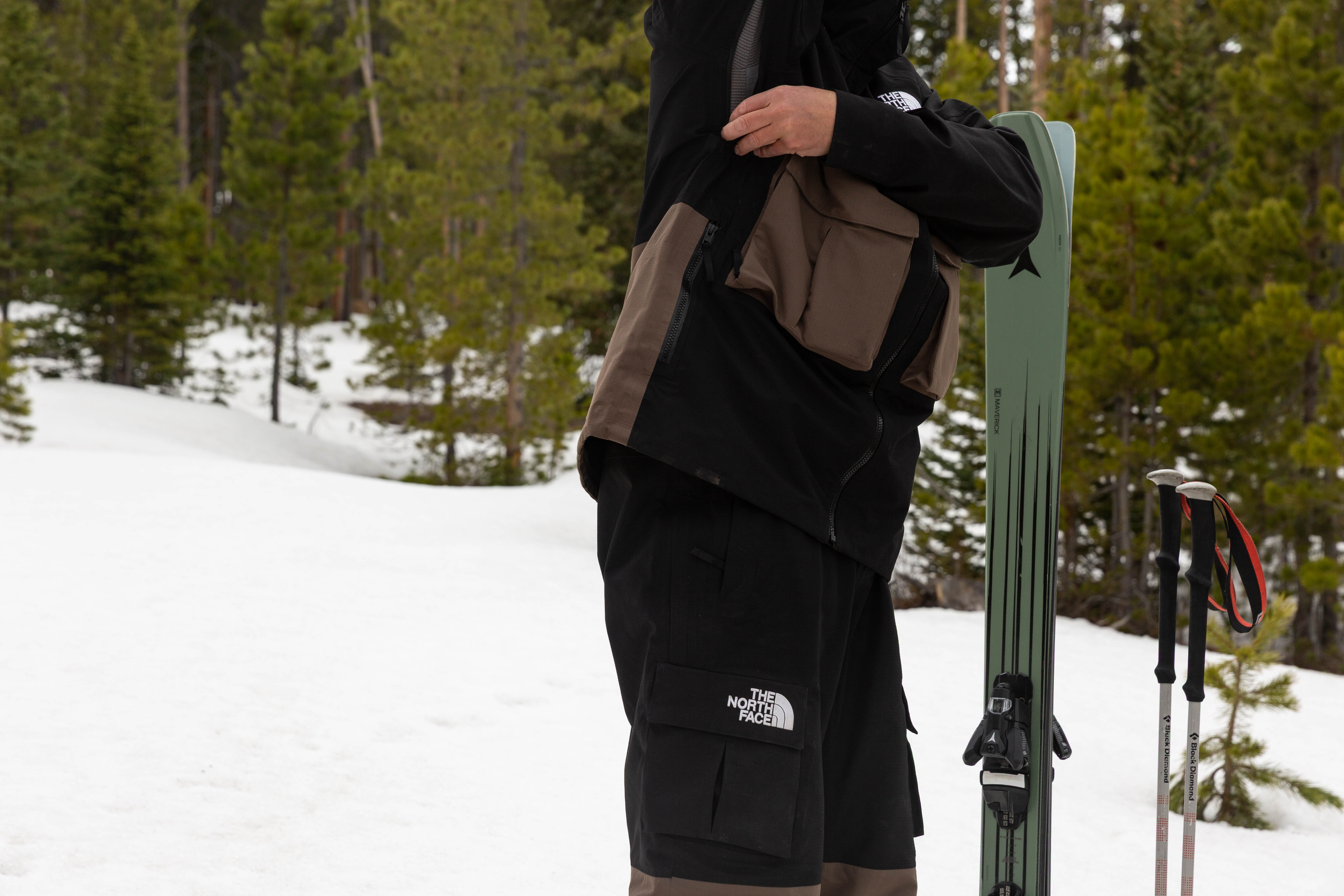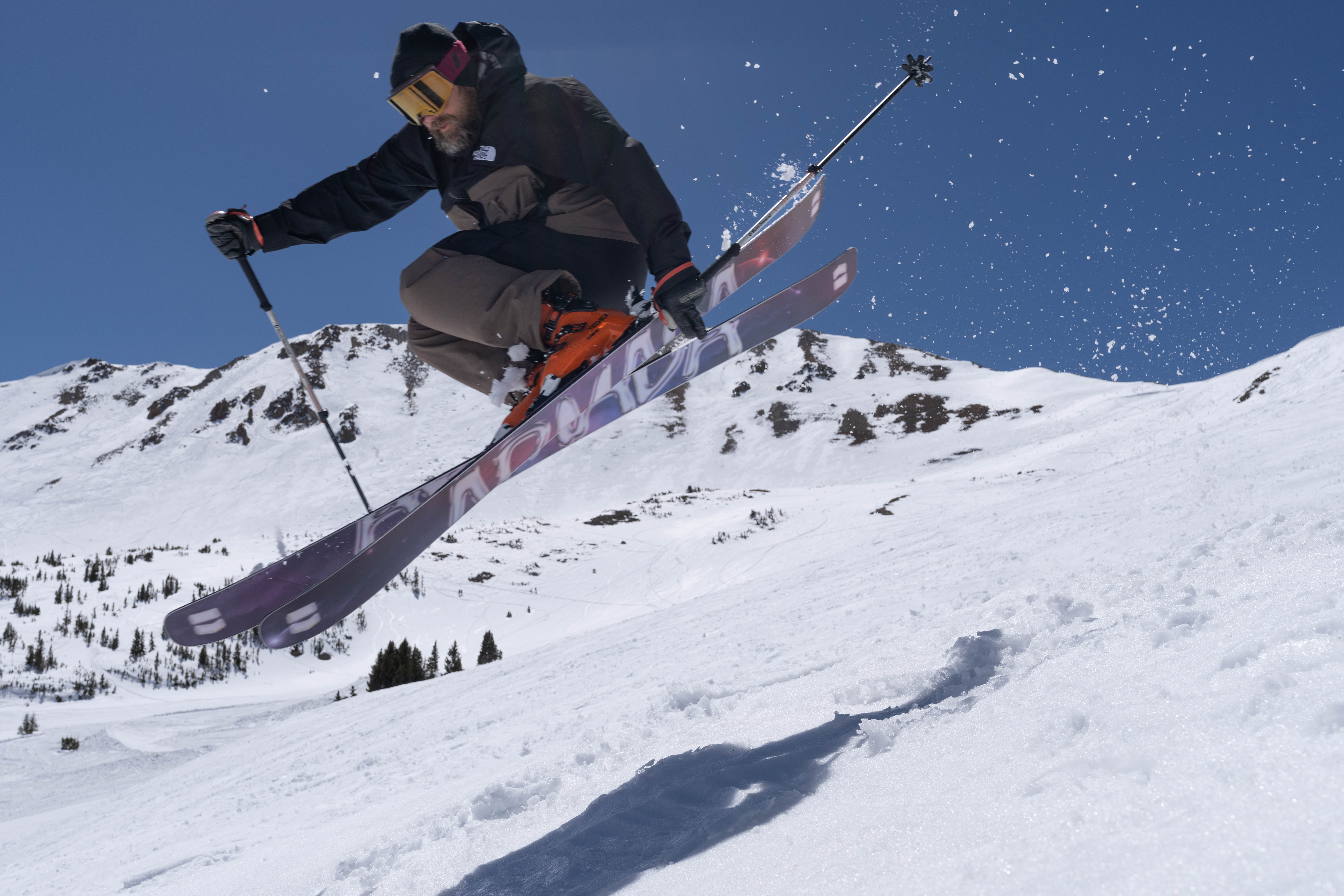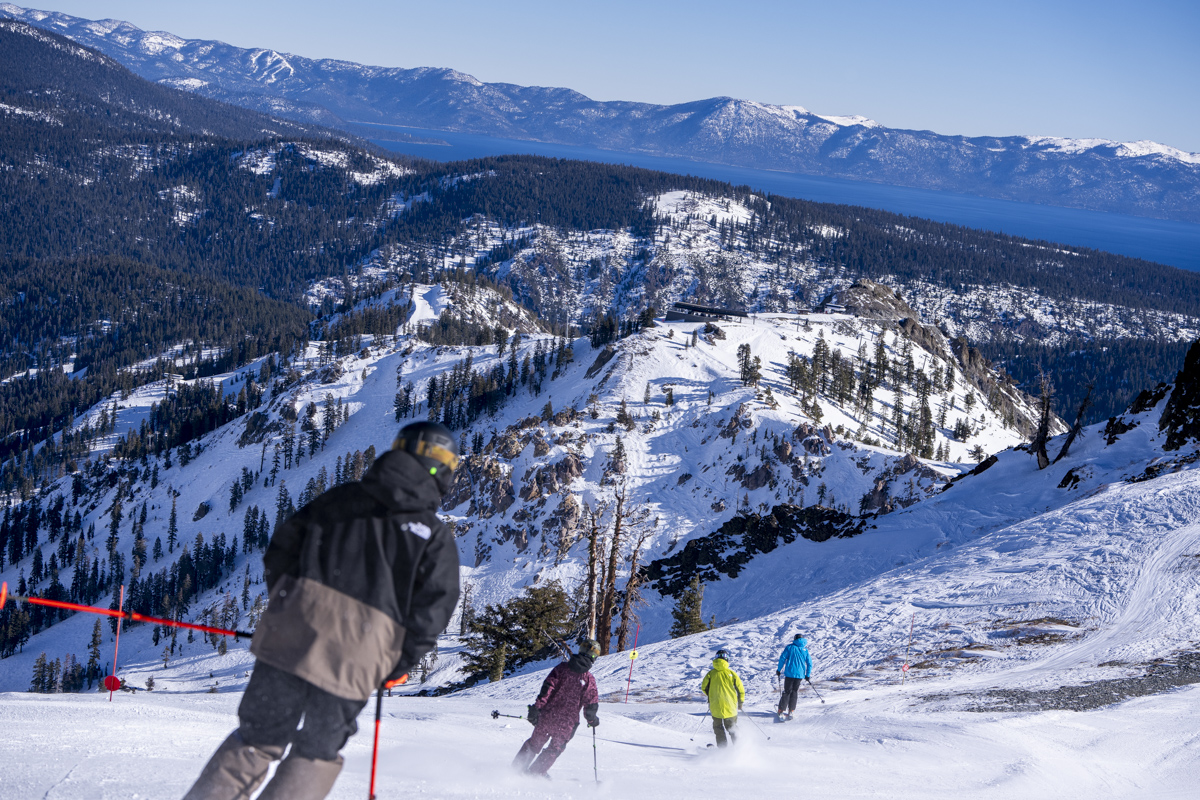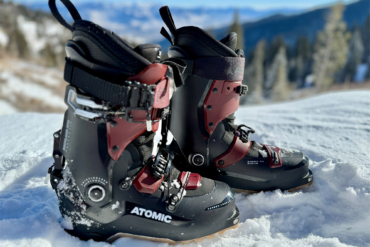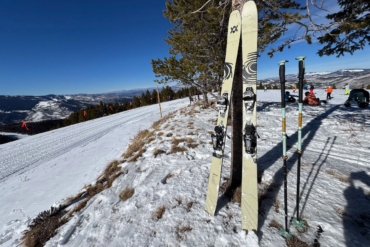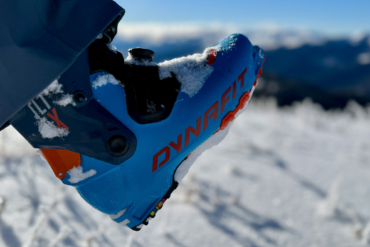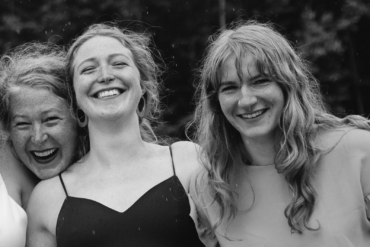Whether you’re at a ski area or out-of-bounds, you’ll need to be protected from the elements. From sunshine to bitter wind and wet snowflakes, finding the best ski jacket will keep you warm, dry, and on the mountain longer.
To help you find the best fit and option for your needs, we created this guide with our favorite jackets for alpine skiing at the resort or heading into the backcountry.
If you’re looking for a stylish, supremely waterproof, and durable ski jacket for resort laps, you can’t go wrong with the Stio Environ Jacket, which has a uniquely cozy collar and many size options. And for $200 less, you can get the equally waterproof Eddie Bauer Chair Six Jacket for Men, which is less tailored and lacks comfort details like fleece-lined pockets but gets the job done.
Editor’s Note: We updated our Ski Jackets buyer’s guide on December 17, 2025, with the field-tested Mountain Hardwear Boundary Ridge GORE-TEX Jacket.
The Best Ski Jackets of 2025-2026
Rab Khroma Kinetic Waterproof Jacket
-
Weather Protection
9.5
-
Fit and Mobility
8.5
-
Durability and Construction Quality
9.0
-
Breathability and Ventilation
9.0
- Fit: Regular
- Insulation: None
- Shell: 3-layer 20D Proflex
- Waterproof rating (mm): 20,000mm
- Breathability (g): 25,000
- Weight: 474 g (women’s size 10); 538 g (men’s size M)
Pros
- Stretchy
- Breathable
- Very comfortable
Cons
- No powder skirt
- Hemline a little high
Eddie Bauer Chair Six Shell Jacket
-
Weather Protection
9.0
-
Fit and Mobility
6.5
-
Durability and Construction Quality
7.0
-
Breathability and Ventilation
7.0
- Fit: Regular, straight
- Insulation: None
- Shell: 3L 100% polyester WeatherEdge Waterproof Stretch Fabric
- Waterproof rating: 20,000 mm
- Breathability: 20,000 g
- Weight: 499 g
Pros
- Budget-friendly
- Material acts like a hardshell, moves like a softshell
- Sealed seams
- Extended size options for women including petite, tall, 1X-3X
Cons
- Pockets are mesh-lined
- Powder skirt is not removable
- Standard length that ends at hips could be a drawback for some skiers
Norrona Tamok GORE-TEX Performance Jacket
-
Weather Protection
9.5
-
Fit and Mobility
8.9
-
Durability and Construction Quality
9.0
-
Breathability and Ventilation
9.0
- Fit: Freeride
- Insulation: None
- Shell: GORE-TEX (3-layer) 100% recycled, Bluesign-approved nylon, PFC-free DWR treatment
- Waterproof rating (mm): 28,000
- Breathability (g): 20,000
- Weight: 754 g
Pros
- Exceptional durability and build quality
- New GORE-TEX ePE fabric slashes environmental footprint
- Excellent coverage for powder and storm days
Cons
- Expensive
- Too long, heavy for backcountry use
Patagonia SnowDrifter Jacket
-
Weather Protection
8.5
-
Fit and Mobility
8.5
-
Durability and Construction Quality
8.0
-
Breathability and Ventilation
9.0
- Fit: Regular
- Insulation: None
- Shell: 3-Layer H2No Patagonia performance benchmark, PFC-free (fabric, membrane, DWR finish), 100% recycled plain weave, 100% recycled polyester backer
- Waterproof rating (mm): 20,000
- Breathability (g): 20,000
- Weight: 590 g
Pros
- Stretchy material makes for an incredibly comfortable fit
- One of the best-looking jackets tested
- Among the most sustainable, toxin-free, healthiest options on the market
Cons
- A bit lightweight for harsh weather and wetter snow climates
- Not insulated if that's a necessity
Stio Environ Jacket
-
Weather Protection
9.0
-
Fit and Mobility
8.5
-
Durability and Construction Quality
9.0
-
Breathability and Ventilation
8.0
- Fit: Regular
- Insulation: No
- Shell: PeakProof 3L waterproof/breathable, 100% recycled polyester 150-denier face fabric, PeakProof membrane
- Waterproof rating (mm): 20,000
- Breathability (g): 10,000
- Weight: 822 g
Pros
- Durable construction
- Generous size run, XS-XXXL for men and XXS-XXL for women
- Recycled fabric
Cons
- A bit heavy for backcountry use
- Not very breathable
Black Diamond Recon Stretch LT Shell
-
Weather Protection
9.0
-
Fit and Mobility
8.5
-
Durability and Construction Quality
9.0
-
Breathability and Ventilation
9.0
- Fit: Athletic, slim
- Insulation: None
- Shell: BD.dry 3L PFC-Free DWR Membrane, 93% Nylon, 7% Elastane face fabric
- Waterproof rating (mm): 20,000
- Breathability (g): 20,000
- Weight: 482 g
Pros
- Excellent stretch for a ski shell
- More breathable than traditional ski shells
- Light and packs down small
Cons
- Too light for harsh, cold resort days
- Demands smart layering for year-round use
Patagonia Insulated Powder Town Jacket
-
Weather Protection
9.0
-
Fit and Mobility
8.5
-
Durability and Construction Quality
9.0
-
Breathability and Ventilation
7.0
- Fit: Regular
- Insulation: 80g (40g in the sleeves) Thermogreen 100% recycled polyester
- Shell: 2-layer 100% recycled postconsumer polyester, PFC-free DWR, Bluesign-approved 100% recycled polyester taffeta liner, Patagonia's H2No in-house multiyear durability standard
- Waterproof rating (mm): 20,000
- Breathability (g): Unavailable
- Weight: 870 g (men’s); 764 g (women’s)
Pros
- RECCO included
- Super comfortable to move in
- Underarm zippers are included
Cons
- Perfect amount of warmth on a cold day but a bit toasty on super warm spring days
Other Shred-Ready Ski Jackets
-
Weather Protection
9.0
-
Fit and Mobility
9.0
-
Durability and Construction Quality
9.0
-
Breathability and Ventilation
8.0
- Fit: Slim
- Insulation: None
- Shell: 3L MaxAliento fabric (88% nylon, 12% spandex)
- Waterproof rating (mm): 25,000
- Breathability (g): 25,000
- Weight: 709 g
Pros
- Softer stretch material allows more tailored fit
- Highly breathable and waterproof
- Durable face fabric
Cons
- Hard to layer underneath snug fit
-
Weather Protection
9.0
-
Fit and Mobility
8.9
-
Durability and Construction Quality
9.3
-
Breathability and Ventilation
8.5
- Fit: Freeride
- Insulation: None
- Shell: 80D and 40D Recycled GORE-TEX Pro Most Breathable
- Waterproof rating (mm): 28,000
- Breathability (g): 20,000
- Weight: 611 g
Pros
- Best-in-class weatherproofing
- Mobility-friendly fit
- Lightweight
Cons
- Expensive
- Inadequate breathability for high-output touring
-
Weather Protection
8.5
-
Fit and Mobility
8.0
-
Durability and Construction Quality
8.0
-
Breathability and Ventilation
8.2
- Fit: Relaxed
- Insulation: None
- Shell: Ripstop 3-layer eVent DV Alpine shell; 100% Nylon face with 20D Tricot backer
- Waterproof rating (mm): 16,000
- Breathability (g): 20,000
- Weight: 625 g
Pros
- Excellent breathability
- Lightweight
- Relaxed fit
Cons
- Expensive
- Thin for cold resort days
-
Weather Protection
8.0
-
Fit and Mobility
9.0
-
Durability and Construction Quality
8.8
-
Breathability and Ventilation
9.8
- Fit: Regular, looser
- Insulation: None
- Shell: 3-layer Dermizax EV, 150-denier nylon face fabric on hood and shoulders; drops to 50-denier for the rest of the jacket
- Waterproof rating (mm): 20,000
- Breathability (g): 45,000
- Weight: 581 g
Pros
- Highest level of breathability we've seen
- More durable material where it matters
- Pack-friendly pocket arrangement
Cons
- Too light for brutally cold resort days
-
Weather Protection
9.0
-
Fit and Mobility
9.1
-
Durability and Construction Quality
9.5
-
Breathability and Ventilation
9.0
- Fit: Relaxed
- Insulation: None
- Shell: 3-layer
- Waterproof rating (mm): 28,000
- Breathability (g): 20,000
- Weight: 700 g
Pros
- Enough room to layer up a fleece or micro puff jacket beneath the shell
- Extremely durable
- Slightly longer drop in the back for extra protection
Cons
- Expensive
-
Weather Protection
9.0
-
Fit and Mobility
8.0
-
Durability and Construction Quality
8.5
-
Breathability and Ventilation
9.0
- Fit: Average
- Insulation: None
- Shell: GORE-TEX ePE 75D 3L
- Waterproof rating (mm): 28,000 mm
- Breathability: <13 RET
- Weight: 719 g
Pros
- Reinforced fabric in high-wear areas
- High performance in a lighter, more flexible fabric
- Roomy, long fit to keep snow out and permit layering
Cons
- Water repellent coating needs regular maintenance
- Too heavy for backcountry pursuits
-
Weather Protection
9.0
-
Fit and Mobility
8.5
-
Durability and Construction Quality
9.0
-
Breathability and Ventilation
7.5
- Shell: 3L 100% recycled PeakProof, 150-denier face, 20-denier tricot backer, 80/20 PFC-free DWR finish
- Insulated: No
- Waterproof (mm)/breathability (g) rating: 20,000/10,000
- Number of pockets: 8
- Weight: 876 g (men's); 766 g (women's)
Pros
- Freeride, baggier fit for freedom of movement
- Ample, spacious pockets
- Hood fits over helmet easily
Cons
- Pricier choice
- Not primary pick for backcountry and uphilling
-
Weather Protection
8.0
-
Fit and Mobility
8.0
-
Durability and Construction Quality
7.5
-
Breathability and Ventilation
7.5
- Fit: Baggy
- Insulation: None
- Shell: DryVent Mono 3L, 100% recycled polyester
- Waterproof rating (mm): N/A
- Breathability (g): N/A
- Weight: 986 g
Pros
- Soft, comfortable fabric
- Roomy cut for layering and mobility
- Plenty of oversized pockets
Cons
- Fabric not as durable as stiffer jackets
Ski Jackets Comparison Chart
Scroll right to view all of the columns: Price, Fit, Insulation, Shell, Waterproof Rating, Weight.
| Ski Jackets | Price | Fit | Insulation | Fabric | Waterproof Rating | Weight (men’s) |
| Stio Environ | $465 | Regular | Not Insulated | 3L | 20K | 822 g |
| Eddie Bauer Chair Six | $249 | Regular, Straight | Not Insulated | 3L | 20K | 499 g |
| Arc’teryx Sabre | $750 | Relaxed | Flannel backer | 3L | 28K | 700 g |
| Rab Khroma Kinetic Waterproof | $400 | Regular | Not Insulated | 3L | 20K | 538 g |
| TREW Gear Capow | $549 | Regular | Not Insulated | 3L | 20k | 581 g |
| Patagonia SnowDrifter | $449 | Regular | Not Insulated | 3L | 20K | 590 g |
| Black Diamond Recon Stretch LT | $400 | Athletic | Not Insulated | 3L | 20K | 482 g |
| Strafe Nomad | $679 | Relaxed | Not Insulated | 3L | 16K | 625 g |
| Nivis Gear Protego Pro | $690 | Athletic | Not Insulated | 3L | 25K | 709 g |
| Mountain Hardwear Boundary Ridge GORE-TEX | $550 | Freeride | Not Insulated | 3L | 28K | 719 g |
| Patagonia Insulated Powder Town | $399 | Regular | 80g (40g in sleeves) Thermogreen 100% recycled polyester | 2L | ~20K | 870 g |
| Norrona Tamok GORE-TEX Performance | $699 | Regular | Not insulated | 3L | 28K | 754 g |
| Rab Khroma Latok | $680 | Freeride | Not insulated | 3L | 28K | 611 g |
| Stio Figment | $499 | Freeride | Not insulated | 3L | 20K | 876 g |
| The North Face Dragline | $450 | Freeride | Not insulated | 3L | ~15K | 986 g |

How We Tested the Best Ski Jackets
Our Expert Testers
Contributor Justin Park skis more than 100 days each season, split evenly between backcountry and resort days. From sub-zero January pow days to slushy June touring missions, he puts dozens of jackets, skis, boots, and pants through its paces at high elevations.
GearJunkie Senior Editor Morgan Tilton specializes in snowsports and has lived in Colorado’s Rocky Mountains for more than three decades, where she grew up, learned to ski at her home mountain of Telluride Ski Resort, and lives today in Crested Butte. She’s been an outdoor industry journalist covering snow sports for over a decade.
Albert Kim, one of our lead GearJunkie testers, is in southern Utah. He cut his teeth in the snowsports industry working as a ski builder for Wagner Custom Skis in Telluride, Colorado.
Since 2021, additional contributors have included Steve Graepel, Ryan Wilchens, Eric Phillips, Sarah Stubbe, Kaylee Walden, Sean McCoy, Austin Beck-Doss, and GearJunkie Editor Will Brendza.
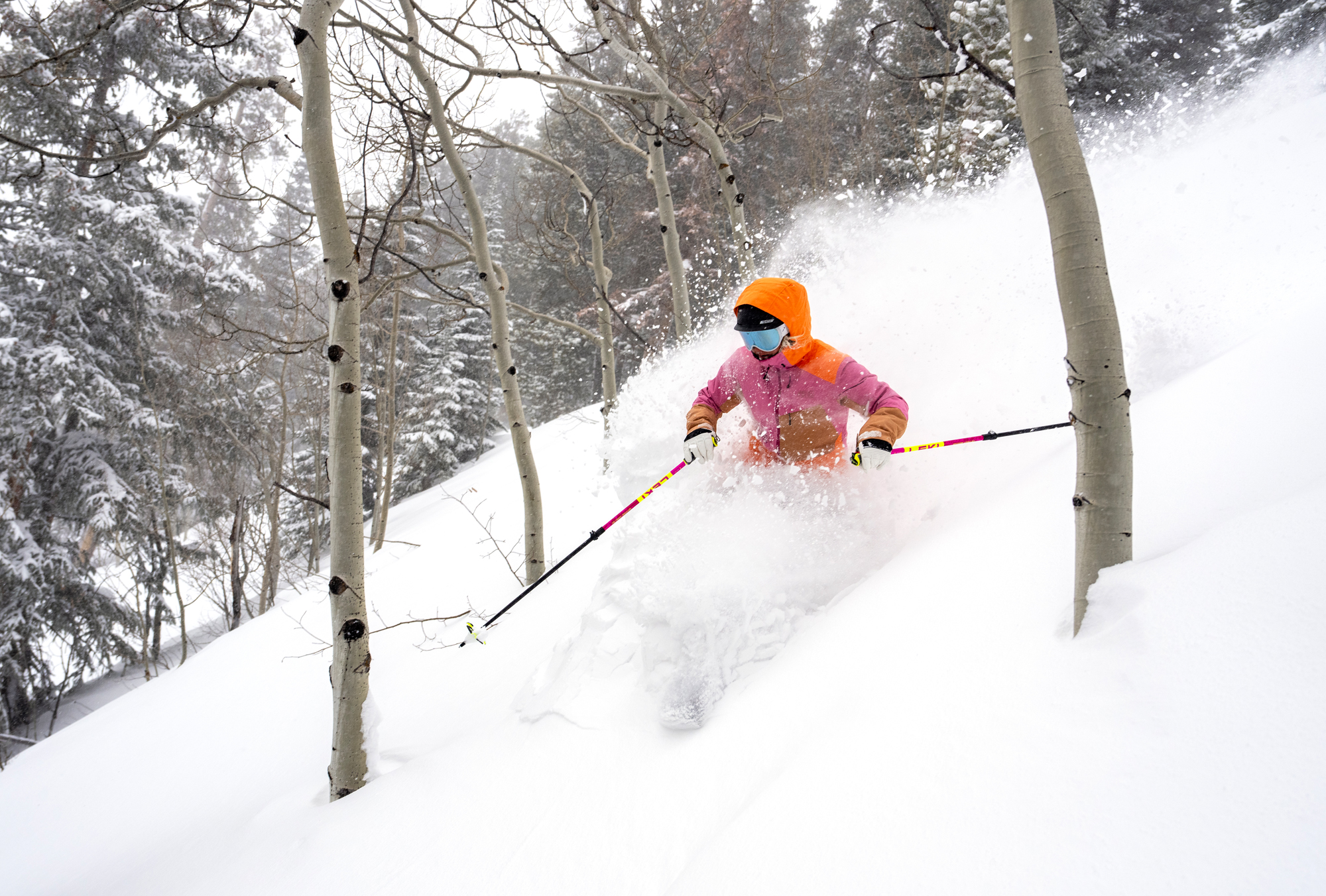
Our Testing Grounds
In addition to managing two dozen gear testers, Tilton field tests from Crested Butte Mountain Resort to Wyoming, Montana, and British Columbia. So far in 2025, Tilton has tested ski jackets for over 165 hours, 700 miles, 195,000 vertical feet, and 44 days of winter adventures. In 2024, she tested apparel for 216 hours throughout 62 days of recreation from ski areas to the backcountry. In 2023, she tested gear for 114 hours across 35 days. Those days exclude the countless hours of shoveling.
Based in Breckenridge, Colo., Park tests ski gear more than 100 days each season. Despite the desert environment of southern Utah, Kim regularly skis at Brian Head Resort and the surrounding backcountry near an elevation of 10,000 feet. Constantly changing conditions have Kim putting his outerwear through its paces, which demands top-tier protection and durability.
The GearJunkie team has met for annual on-snow test weeks to grind out turns and swap notes, including two gatherings at Crested Butte Mountain Resort, which is known for its expert terrain.

Our Testing Process
Throughout the field tests, we note various metrics, including performance, protection, quality, longevity, fit, functionality, features, size range, and value.
In addition to our experience, we consider the most novel, style-specific, popular, highly rated, and legacy products across various price points. This collection of ski jackets serves a range of athletes and applications.
Our Ski Jackets Rating System
We score each ski jacket on a 1–10 scale for Weather Protection, Fit and Mobility, Durability and Construction Quality, plus Breathability and Ventilation. While considering weather protection, we take into account how the jacket shields moisture and wind. Fit and mobility examines how effortlessly the jacket moves with us while going uphill, downhill, ski pole planting, wearing a ski backpack, and bending over, as well as if there are any snag points. Durability and construction quality considers the overall material, seams, collar, hood, zippers, and pockets. The breathability and ventilation takes a look at how effectively the design releases moisture and heat during high-output activity, including the material and mechanical vents.
The Overall Rating is based on contextual, editorial judgment, and the complex user experience across various scenarios and conditions.
Buyer’s Guide: How to Choose a Ski Jacket
Ski jackets are useful for activities other than laps at your local ski hill or in the backcountry. These winter jackets are so functional that they can also be used for shoveling the driveway, walking the dog, snowmobiling, snowboarding, and more.
If you’re looking for a jacket specific to snowboarding, check out our Best Snowboard Jackets buyer’s guide. The main differences are the fit, style, and brand alliance.
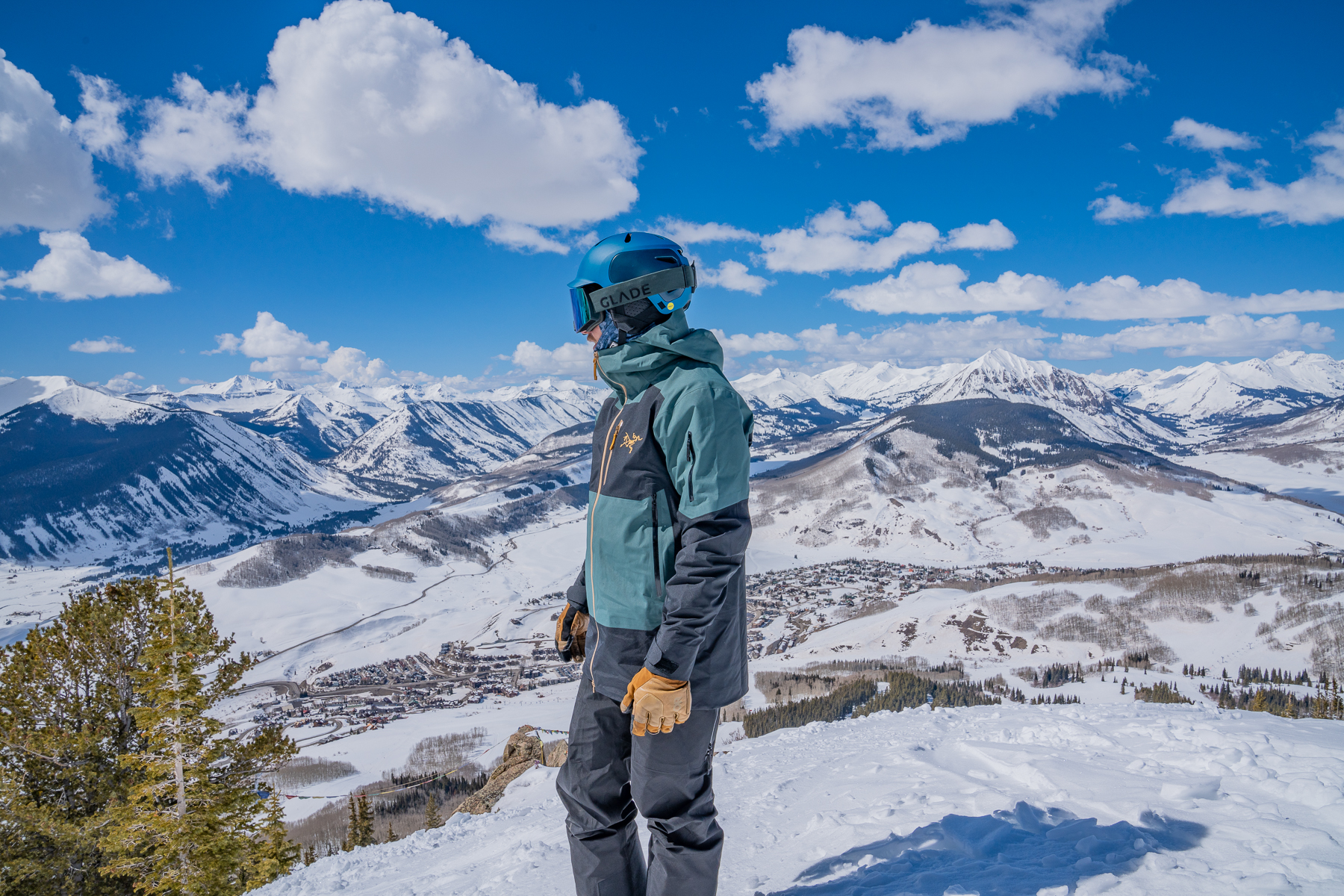
Ski Jacket Fit
Generally, ski jacket designs land in two camps: trimmer with a more streamlined, athletic fit or roomier and boxier with a more relaxed silhouette. Both can be comfortable. If you’re wearing a backpack in the backcountry, it can be better to wear a well-fitted jacket so the fabric doesn’t get pinched up.
Each manufacturer has its size charts for ski jackets. Make sure to take your measurements and match them with the size charts.
Many companies deliver more size inclusivity with broader offerings for men’s and women’s apparel, including TREW Gear, Columbia, Obermeyer, and L.L.Bean. While there are, unfortunately, no men’s ski jackets with extended sizes on our list, the Stio Men’s Environ Jacket offers the broadest size range of XS to XXXL. The Eddie Bauer Chair Six Jacket for Women has plus sizes 1X-3X and XS-XXL, petite, and tall options. We’d like more size options for our favorite men’s ski jackets.
Everyone’s body is unique, so check the exchange and return policy before you buy.

Insulated vs. Non-Insulated Ski Jackets
Some ski jackets offer no insulation, which is a versatile option for use across various conditions. This waterproof, breathable layer helps you stay dry and protected from the sun, wind, or abrasion, like from a tree branch or snow burn if you slide out. There’s typically enough room to add a midlayer and base layer beneath for chilly or cold days.
This type of jacket works well for warm spring turns at the resort or powder days when you typically accumulate heat carving turns. A range of weights and densities exists so that you might prefer a heavier hand feel if you ski where there’s frequent wind chill.
Other ski jackets, like the Patagonia Insulated Powder Town, are insulated for additional warmth in cold, windy locations. For some skiers, especially those going into the backcountry, these jackets can pigeonhole them into donning too much warmth.
Insulated jackets also tend to be overkill on warm spring days or in milder winter locations. The type and warmth of insulation vary across each jacket, ranging from flannel to down-filled panels or synthetic proprietary fabrics.

2-Layer vs. 3-Layer
A two-layer jacket has a face fabric — such as polyester or nylon — connected to an inner liner that protects the fabric, is breathable, and adds comfort. These jackets usually feel less hefty than a three-layer jacket. One of our favorites is the Patagonia Insulated Powder Town, which combines a layer of insulation with an outer fabric treated for waterproof protection. The price is generally more moderate compared to three-layer jackets.
Regarding durability, a three-layer jacket is a waterproof/breathable membrane — often made by GORE-TEX — sandwiched between a tough face fabric and liner. Sometimes the outer fabric is treated for waterproofness. These jackets offer more protection for fierce weather conditions and are pricier. Broadly, you’ll want to scrutinize how robust you need your coat to be for your ski conditions.
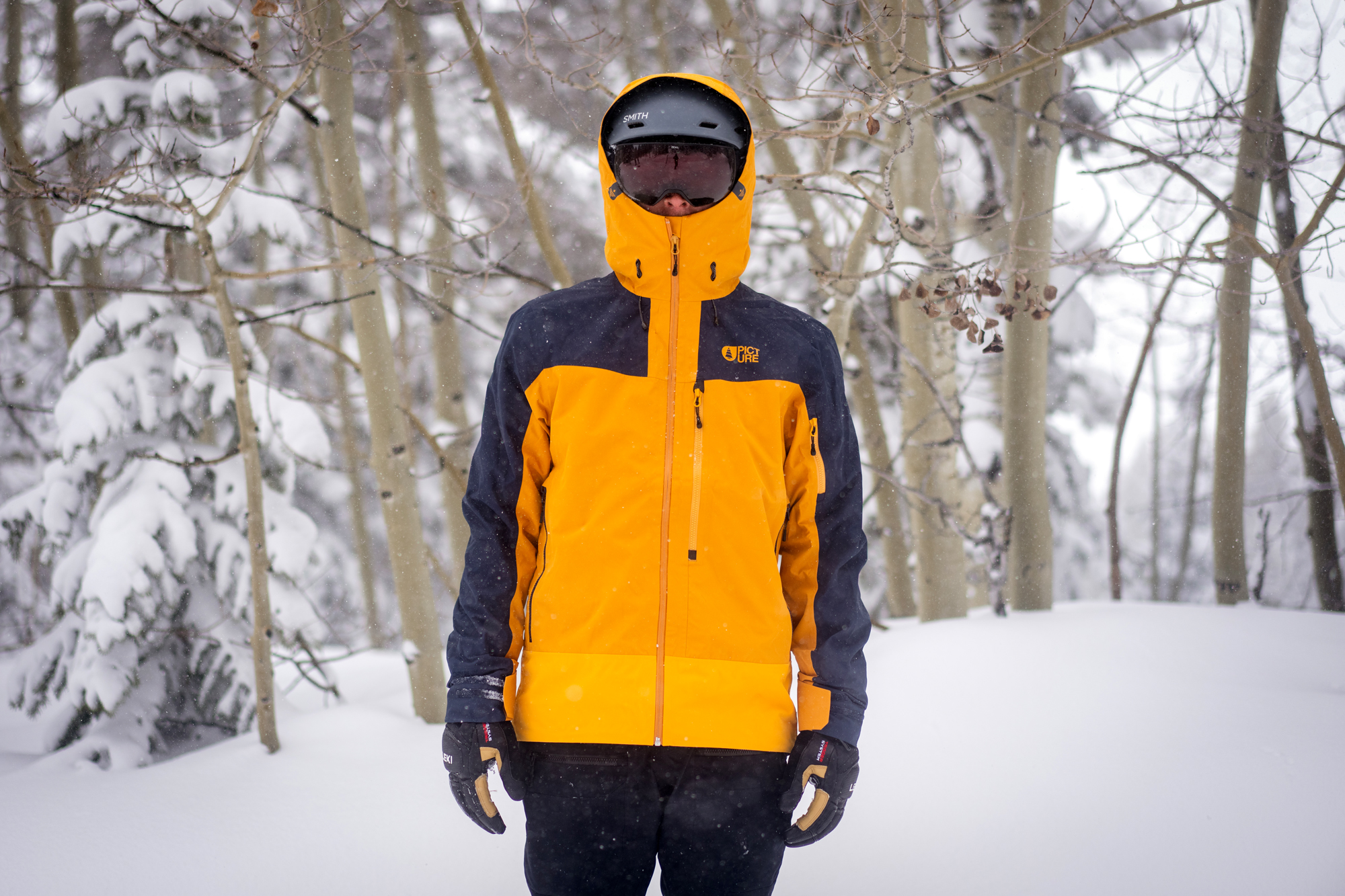
Waterproofness
A waterproof jacket is ideal for skiing because weather can be flippant, and you don’t want to run the risk of getting wet from snow or rain. The top-A waterproof jacket is ideal for skiing because the weather can be unpredictable, and you don’t want to risk getting wet from snow or rain. The top-tier waterproofing standard is GORE-TEX, a membrane integrated into various jacket designs.
The material is waterproof, windproof, and breathable. Some brands have a proprietary version of waterproof/breathable fabrics.
Manufacturers rate waterproofing by how much water a fabric withstands before leaking, typically from 5,000 mm to 20,000 mm or higher. The latter end of the spectrum leads to a less breathable fabric.
- 0-5,000 mm: Resistant to light rain, dry snow
- 6,000-10,000 mm: Waterproof for light rain and dry, non-heavy snow
- 11,000-15,000 mm: Waterproof for moderate rain and dry, non-heavy snow
- 16,000-20,000 mm: Waterproof for heavy rain and wet snow
- 20,000 mm and greater: Waterproof for heavy rain and dense, wet, heavy snow
The most waterproof jacket we’ve tested provided 30,000mm protection. Jackets at 10,000 mm are adequate for many skiers and riders, though it depends on the environment.
Face fabric treatments, which can be eco-friendly formulas or chemicals toxic to the environment, can also make a jacket waterproof. And some jackets have sealed seams to block moisture.
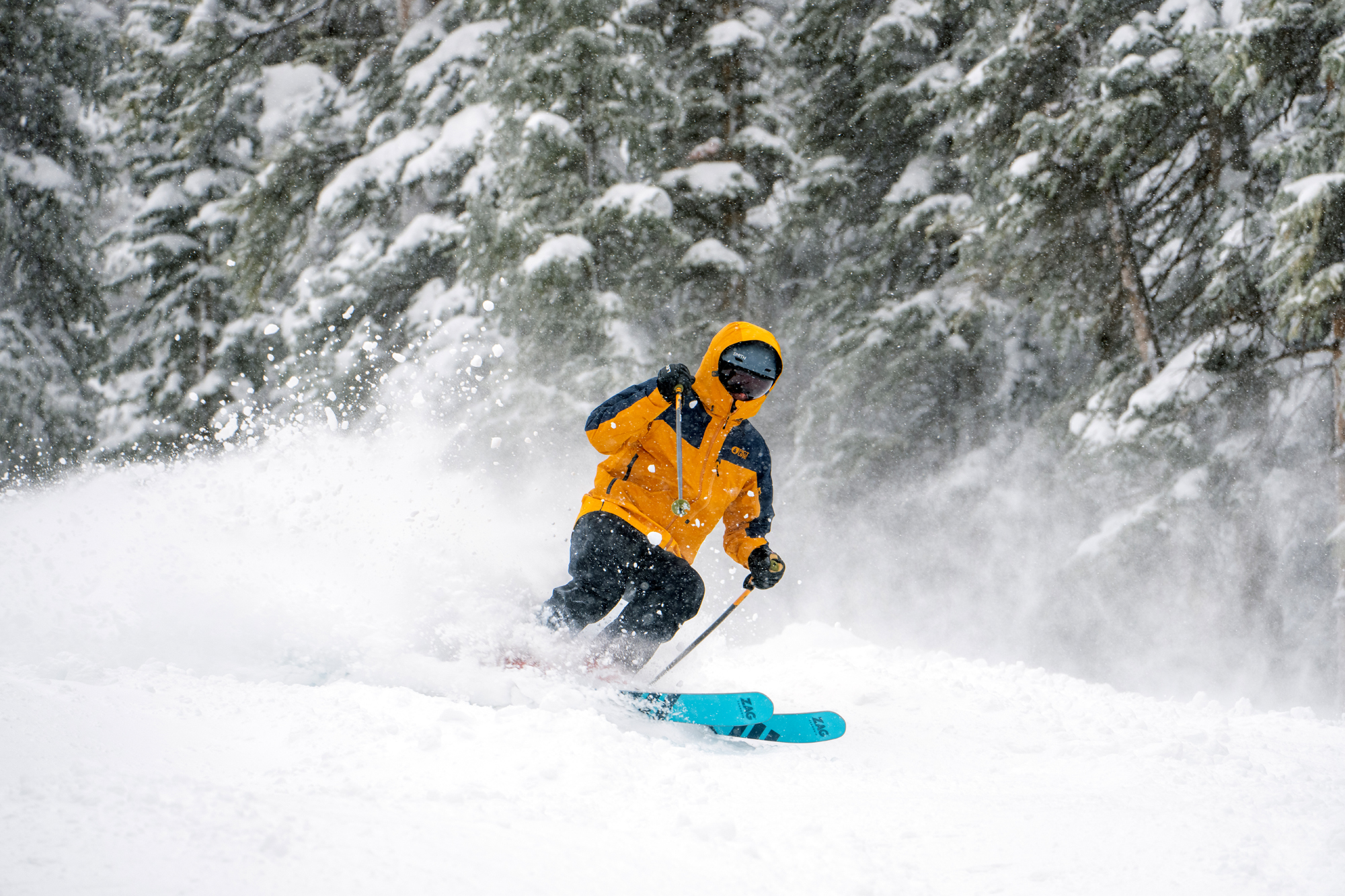
Breathability & Air Permeability
For high-output skiing on powder days, aim for a jacket with 10,000-15,000 g of breathability. Backcountry skiers and uphill athletes should look for even more breathability — 20,000 g or more.
The breathability of a ski jacket is constantly in a constant balance or pull game with its waterproofness. Generally, the more waterproof an outer layer is, the more difficult it is for the fabric to be fully breathable. On the far end of that spectrum, imagine your favorite workout t-shirt you pull on for a hike or the gym: It’s not waterproof, but it allows your sweat to exit.
A few jackets, such as the Strafe Nomad Jacket, are air-permeable. These jackets use a different waterproof/breathable construction than the standard set by GORE-TEX. While GORE-TEX membranes allow moisture to escape in the form of vapor, air-permeable fabrics let air pass through, so you don’t have to start sweating to activate the jacket’s breathability. Fabrics with air permeability include the Strafe Nomad’s eVent, Flylow’s The Perm, and the BD.dry fabric used in the Black Diamond Recon LT Shell.

If you want a more breathable ski jacket, pay attention to that metric and whether there are underarm vents. Of course, if breathability is a priority, you’ll also likely want a jacket that is not insulated.
Ventilation
Ski jackets often offer ventilation through underarm zippers, which help regulate body temperature. This feature is great for warm-blooded folks or those who ski in warm conditions and for powder days when your body works hard to make turns. Some underarm zippers are longer than others.
One innovative ventilation design we’ve seen is a front-facing, closable mesh vent that parallels the front zipper. In terms of quality, YKK zippers are the toughest.
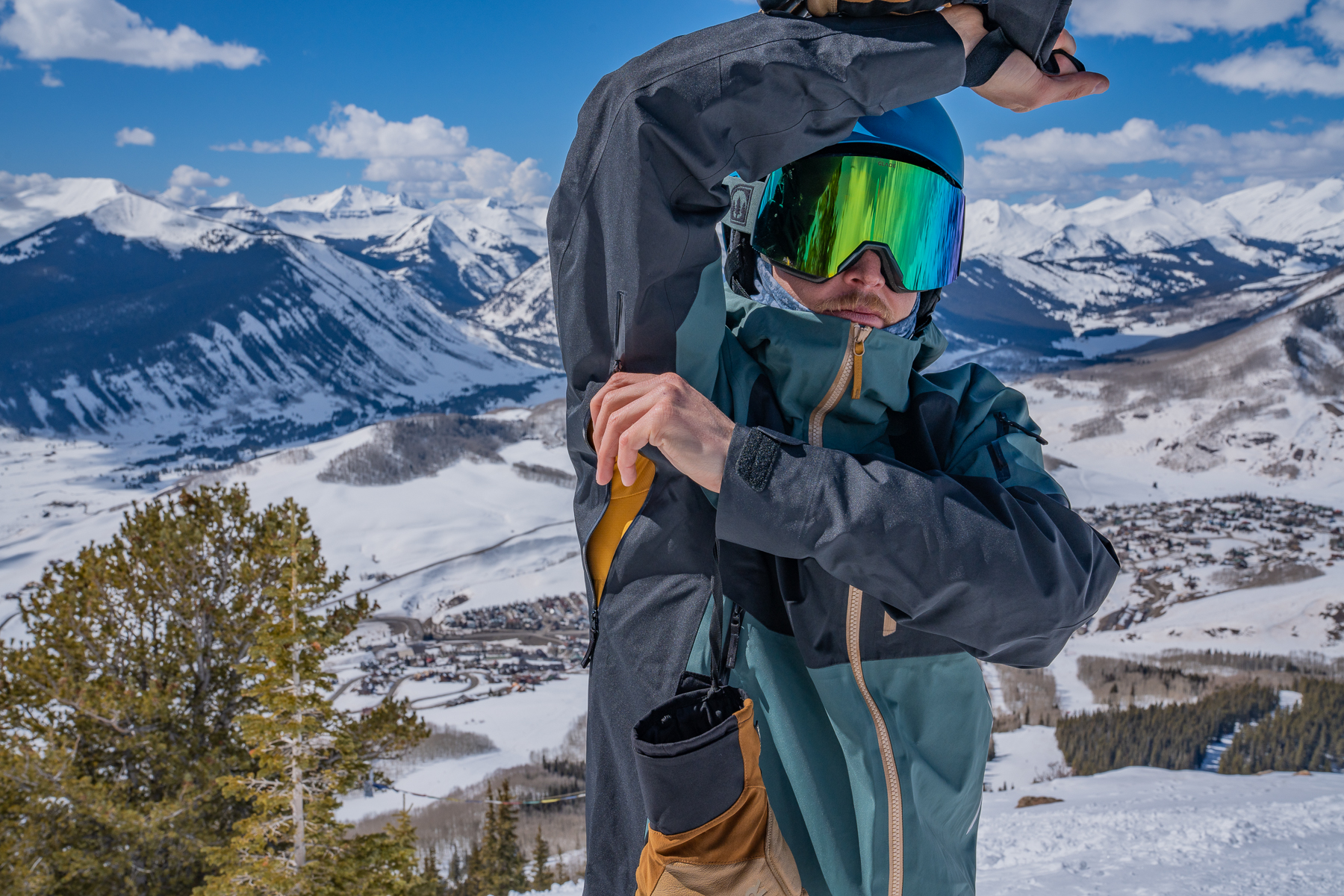
Overall Weight
A jacket’s overall weight is important for backcountry skiers who often need to stash a jacket in a pack and can’t sacrifice space for bulk.
Similarly, some uphill athletes want a jacket for weather protection but only need a light layer. And occasional resort skiers take laps with a backpack on and might need to store a jacket as the conditions warm.
The lightest jackets in our top picks are 450-550 g, like the Black Diamond Recon Stretch LT Shell. Heavier jackets are closer to 900-1,000 g.
Ultimately, you shouldn’t compromise a jacket’s safety or comfort details and adequate warmth to lose weight.
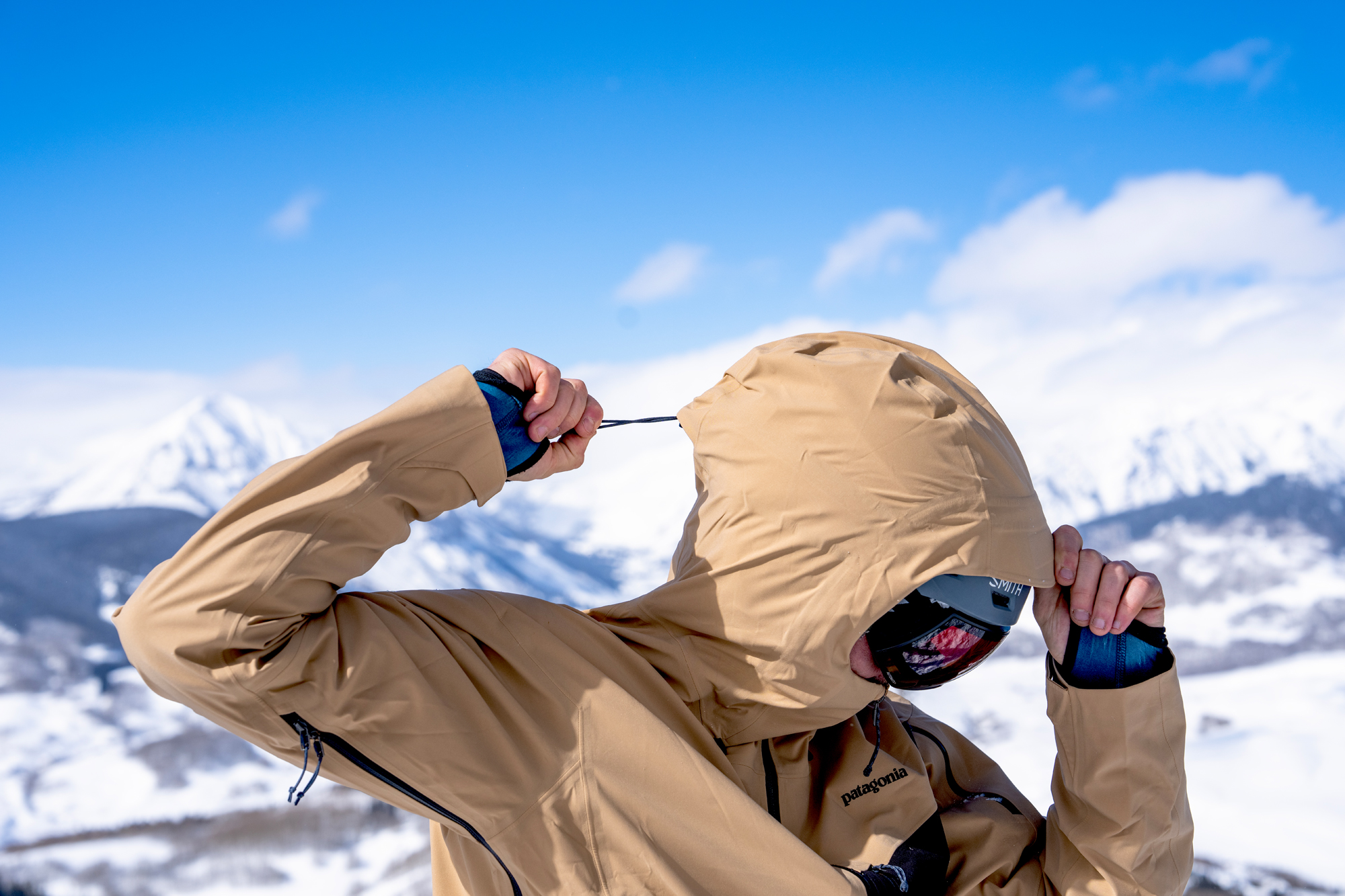
Collar & Hood
An ergonomic collar and hood protect the face, head, and neck against sun, snow, sleet, hail, wind, or rain. Pulling up a hood can help the body retain heat in chilly conditions.
Jacket collars vary in height and ideally have an interior chin guard that feels snug against the face — a key component on a gusty chair lift.
Hoods can be helmet-compatible, a priority if you need extra protection and warmth around your face and neck while riding a lift or skiing during a snowstorm. Some hoods are adjustable via elastic pulls. And others have an integrated visor so they don’t collapse beneath moisture. Some jackets feature removable hoods, while others have fixed ones.
One of our favorite hoods is on the Patagonia Men’s SnowDrifter Jacket. It offers a great shape that fits over a range of helmet sizes and doesn’t catch a draft. Plus, it has plenty of flexibility to swivel our heads while skiing downhill or sitting on the lift.
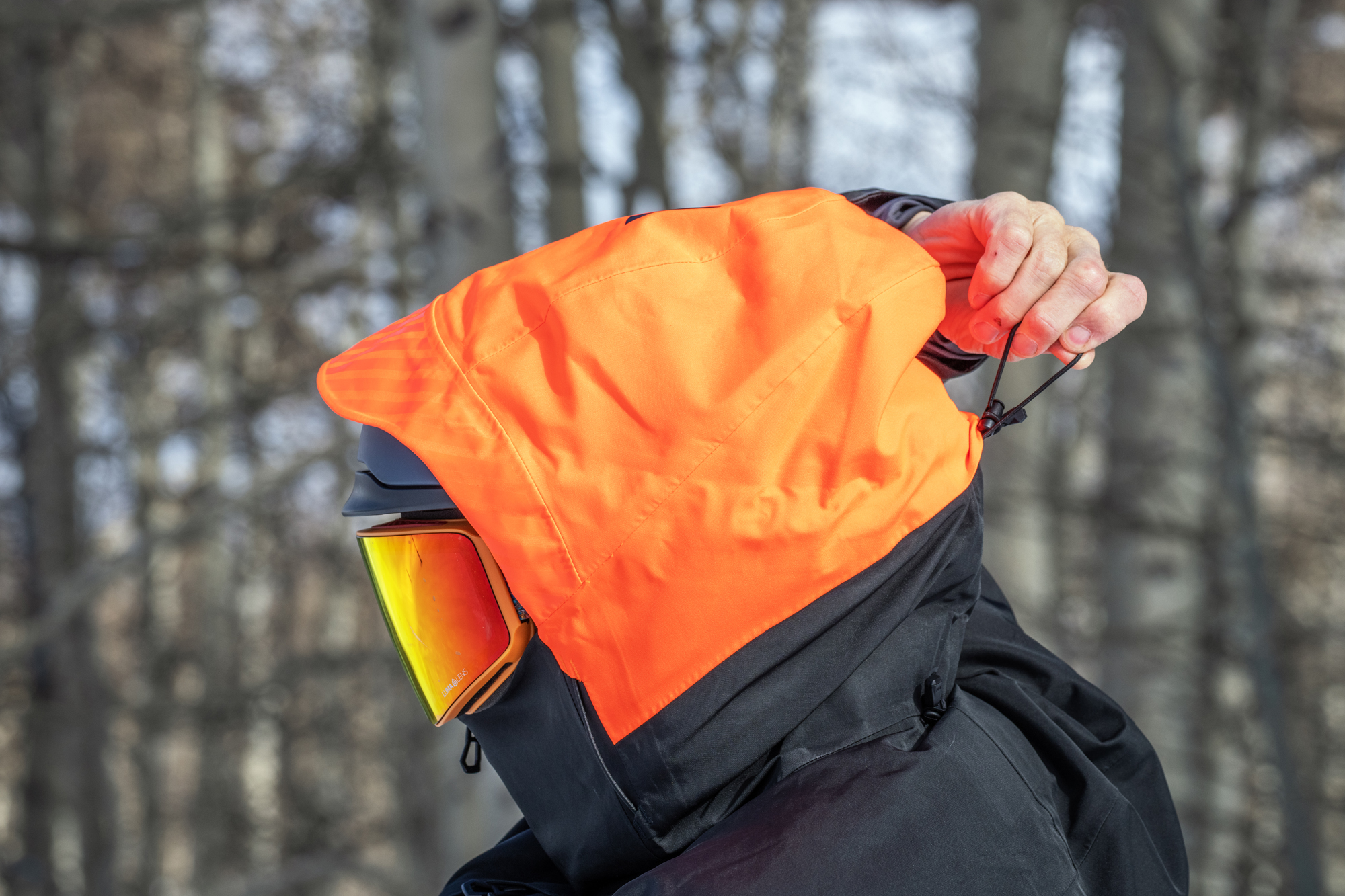
Sleeve Cuffs & Powder Skirt
Powder skirts can be a great addition to a jacket to prevent fluffy flakes from flying up and soaking your base layers or lower back. Some ski jackets, like the Eddie Bauer Chair Six Jacket for Men, feature fixed powder skirts you can’t remove. Others have a zipper or attachment points to connect to your ski jacket.
Sleeve cuffs generally have a Velcro closure, though they vary in width, length, and pliability. Some designs have additional snaps. Many cuffs have an inner wrist gaiter or storm cuff (a cuff within a cuff). It’s usually made of stretchy fabric and adds warmth while blocking wind. Sometimes, it has thumbholes to help secure the fabric over the top of the hand.
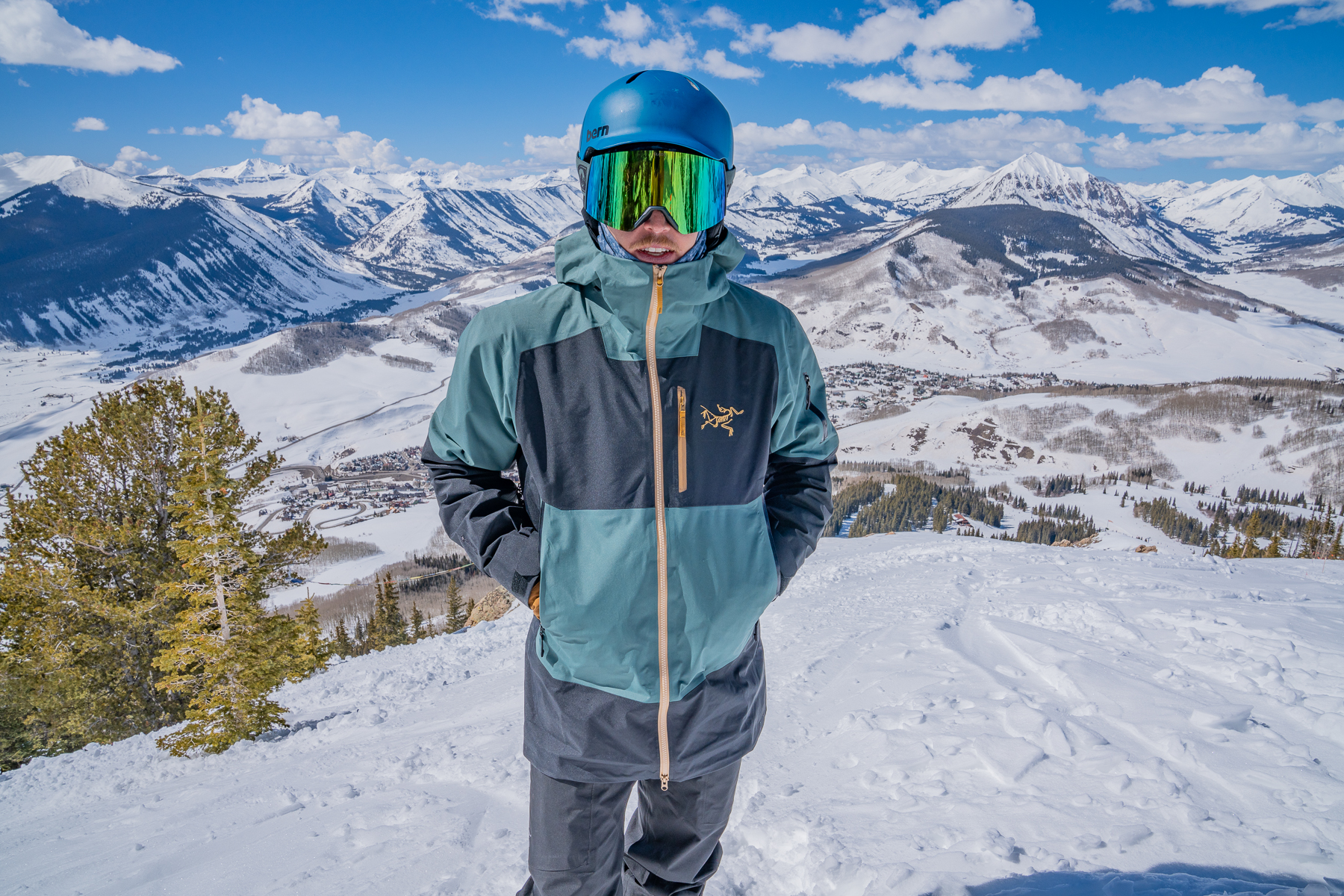
Pockets
Most ski jackets include two exterior hand pockets with zip closures, which can be low or high to accommodate a backpack belt or harness for ski mountaineering. Other exterior pockets can include small pouches on the arm or the chest. Deep, wide, higher-placed exterior pockets can be nice for stowing a smartphone or notebook in the backcountry.
Interior pockets often have a zip closure, ports for headphones, or a mesh construction with an elastic band at the top. These can be great for carrying a credit card or ID.
Deep, wide interior pockets can be essential for holding backcountry skins, especially if the temperature is crisp and you must prevent the glue from freezing over between uses. Occasionally, a pocket is insulated to help extend your smartphone’s battery life.
Examine what you’ll need to carry, the adequate pocket size, and if the pockets are in the most comfortable place. For resort skiing, one of our favorite jackets for the pocket design is the Stio Men’s Figment Jacket, which has two chest pockets and two large hand pockets on the front.

Sustainability
Outdoor brands such as Patagonia and outdoor retailers such as the REI Co-op have been pushing sustainability for years. Today, most outdoor brands have made at least minor moves in this direction: incorporating recycled fabrics, using less intensive production methods, and offering end-of-life options for old apparel.
Legislation at state and federal levels is getting into the fight, as well, with the EPA declaring several PFAS chemicals officially hazardous. California and New York both have PFAS bans for apparel, instated in 2025, so outdoor brands have been hard at work getting product lineups into compliance by eliminating these forever chemicals from garments.
Many brands now incorporate the GORE-TEX ePE fabric and membrane, which eliminates long-lasting perfluorinated chemicals from the fabric, membrane, and topical treatments.
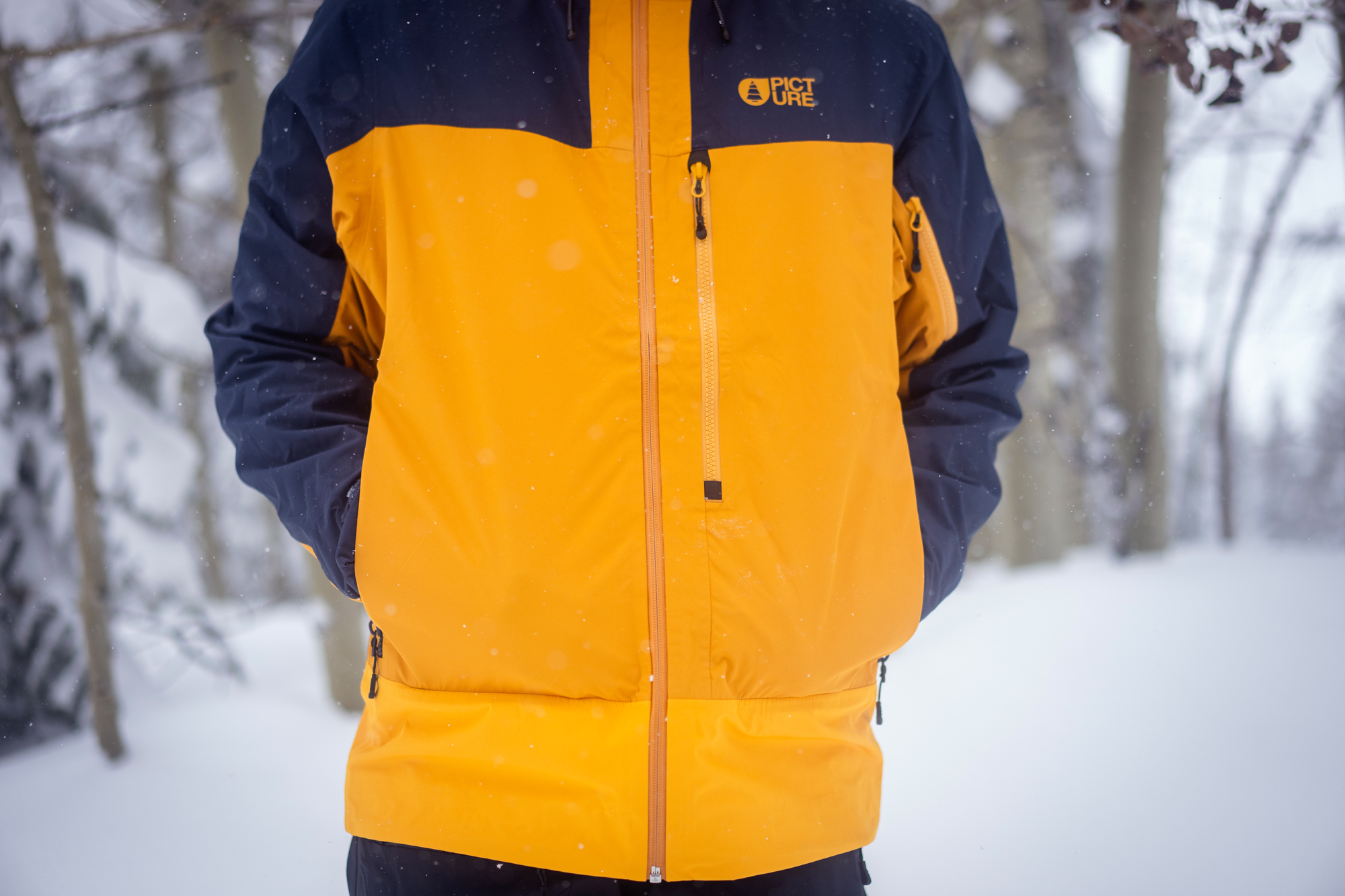
How To Wash & Dry Your Ski Jacket
Many brands now incorporate GORE-TEX ePE fabric, which is PFAS-free, into ski jacket designs. Washing your PFAS-free fabric reactivates the DWR and removes the oil and grime that decreases the waterproofness and breathability. Also, ePE fabrics are more susceptible to oil-based stains, whether that’s oil from your breakfast burrito or a greasy chairlift.
“PFAS-free DWR coatings require more frequent wash and care to maintain water repellency on face fabrics,” explained GORE-TEX expert Marshall Balick at an outdoor industry presentation Senior Editor Morgan Tilton attended in Nelson, British Columbia.
According to Balick’s presentation, technical wash detergent is ideal because it does not contain additives. If one isn’t available, choose a conventional product that is scent-free and does not contain fabric softener, like Seventh Generation.
That said, if you only have a detergent with a scent and fabric softener, such as Tide, then it’s still better to wash your garment than not. But be sure to double-rinse. Later, it’d be best to wash your garment with a technical detergent, which will remove the additives from the fabric.
How frequently do you need to wash your ski jacket? It’s time to clean when your garment wets out and water no longer beads on the surface. You’ll hang the outer layer to dry. Then, you must put it in the dryer for 20 minutes on medium heat to fully reactivate the DWR.
If that process hits a roadblock and no longer rejuvenates the face fabric (to enable droplets to bead), you must reapply an after-market product like Nikwax.
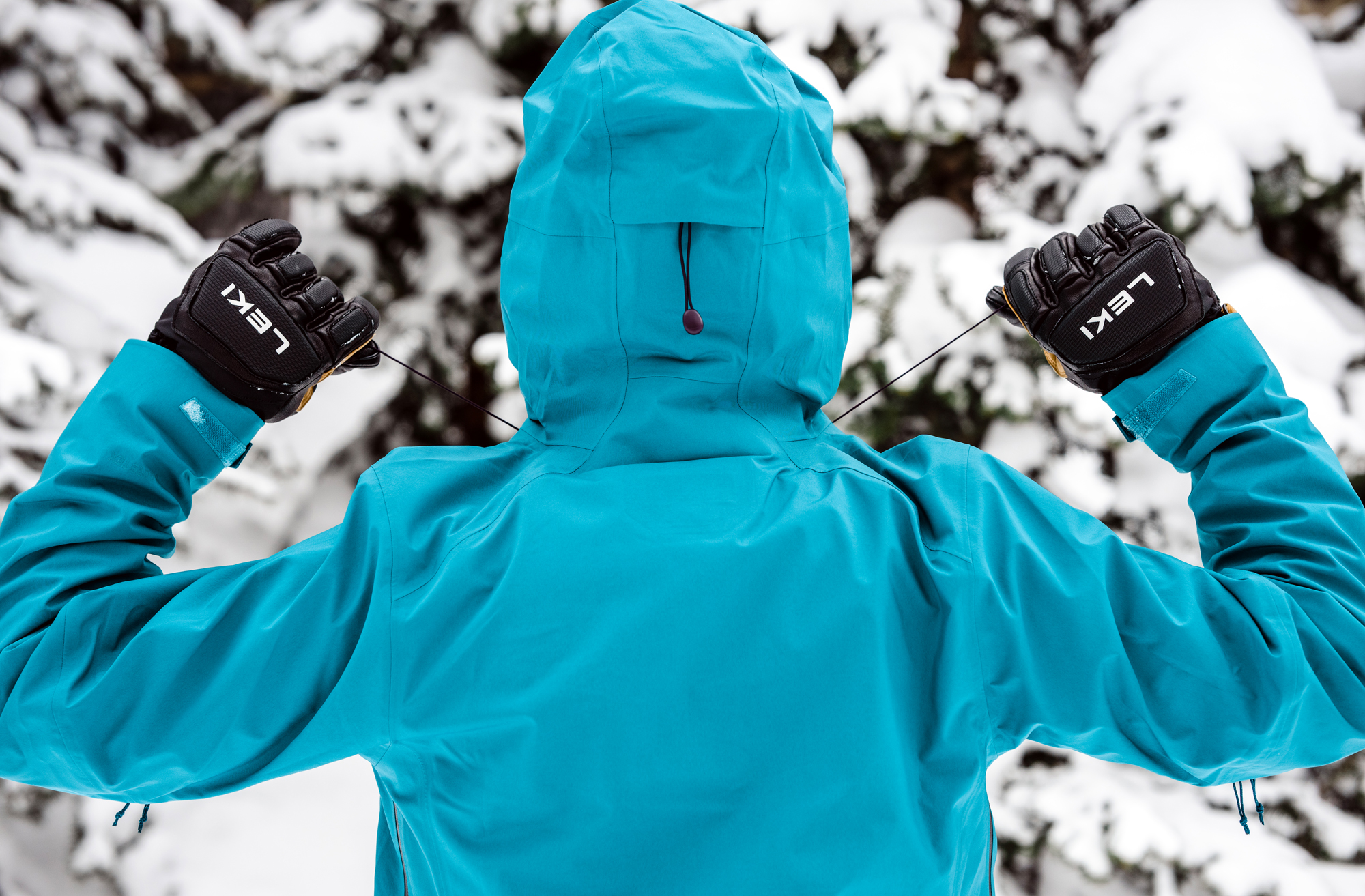
Price & Value
Like most ski gear, purpose-built ski jackets from name brands aren’t cheap, and you can expect to spend a couple of hundred dollars even for the lower-tier options. Ski jackets that are the most robust, weatherproof, and built with the highest quality fit and materials can rack up a bill in the $700 range.
Budget: Basic Protection in a Ski Jacket
The cheapest option in our top picks is the Eddie Bauer Chair Six Jacket ($249), which delivers 20K/20K performance that’s more than adequate for most ski days while keeping the price very reasonable.
Mid-Tier: Articulated, Athletic Designs
For a bit more, the Black Diamond Recon Stretch LT Shell ($400) delivers lighter-weight performance in a jacket that’s equally at home on the skintrack as on the chairlift.
Premium: High-Quality Construction & Fabric
High-end shells can cost as much as $700, and while it’s not necessary to spend that much to get a competent ski jacket, these high-end options usually pair a high-performing waterproof and breathable membrane such as GORE-TEX Pro.
To illustrate, the Rab Khroma Latok Jacket ($680) is highly waterproof at 28K, supremely breathable, and reinforced with 80D and 40D Recycled GORE-TEX Pro fabric. The jacket only weighs 611 g, too.
Premium fabrics deliver on performance and usually have better durability, allowing you to spread the jacket’s cost out over many seasons of hard use.

Frequently Asked Questions
Ski jackets are specifically constructed to be waterproof, breathable, and windproof, protecting you while you play outside in the snow all day.
These designs are also comfortable and ergonomic for the sport’s significant movements, like bending over to adjust boots and bindings, planting a pole, or shifting your shoulder orientation while riding moguls.
Overall, it’s a good idea to invest in a ski jacket that will help you stay warm and dry in the conditions where you most often ski.
Study the temperature range and weather conditions where and when you most often ski. Based on how much body heat you’ll build up during your activity, choose a jacket that will keep you comfortable and dry in that environment.
Backcountry-centric ski jackets are typically more substantial and slender, with specifics for off-piste travel. They’re often more expensive.
If you want a ski jacket that works well for other heat-inducing applications, like shoveling the driveway, look for a noninsulated jacket. You can usually add layers beneath.
Alternatively, choose an insulated jacket if you want a cozier ski jacket for mellow groomer skiing in icebox conditions or chairlift rides that get blasted with wind.
You’ll also want to consider your preferred qualities, such as the number of pockets, thumbholes in the wrist gaiters, or a removable hood.

Both athletic and relaxed ski jackets are usually a bit roomy, so you can fit a base layer and midlayer beneath if needed.
Each manufacturer has its size charts for male and female categories. Match your measurements to the size charts and check the return or exchange policy before purchasing.
Next to your skin, wear a long-sleeve synthetic base layer. You might even be more comfortable in a synthetic T-shirt on super-warm spring days.
On colder days and with noninsulated jackets, skiers often add a midlayer — usually a fleece or synthetic jacket.

Totally! If the day-to-day outdoor conditions where you live are a match for the jacket’s insulation and waterproofness, you could be comfortable wearing that ski jacket as a daily driver.
But beware: The new PFAS-free Durable Water Repellent coatings rolling out across ski jackets have a shortcoming. They repel water but not oil. Yes, olive oil from cooking your morning eggs, body oils, and chairlift grease can all break down the coating, leading to unfortunate stains on your favorite ski jacket. (Also, PFAS-free DWR coatings require frequent washing and drying to maintain water repellency on face fabrics.)
If you don’t want to increase the jacket’s wear and tear through daily use, you might prefer a cozier winter jacket that’s longer, more insulated, and more fashion-forward.
One of the warmest ski jackets is the insulated Patagonia Insulated Powder Town.

Ski jackets are a long-term investment worth the money for the protection and comfort they provide in winter.
The most economical options usually range from $200 to $300, and the average cost is $300-400. The most robust designs, which are best suited for long days in variable conditions and backcountry skiing or mountaineering, can reach up to $750.
You don’t want a ski jacket to fit tightly because skiing requires a lot of freedom of movement. Plus, it’s nice to have room for a comfortable, wicking synthetic long-sleeve beneath the jacket and a fleece midlayer if the temperatures are low or a micro-puffy if the temps plummet.
Hoods offer protection and warmth around your face, head, and neck for chair lift rides and skiing during a snow or wind storm. An ergonomic hood shields the elements, including sun, snow, sleet, hail, wind, and rain. Hoods can include an integrated brim that helps keep moisture from dripping into your ski goggles.
Pulling up a hood can help the body retain heat in chilly conditions. It’s essential to look for a ski jacket with a helmet-compatible hood. Some jackets feature removable hoods, while others have fixed ones.
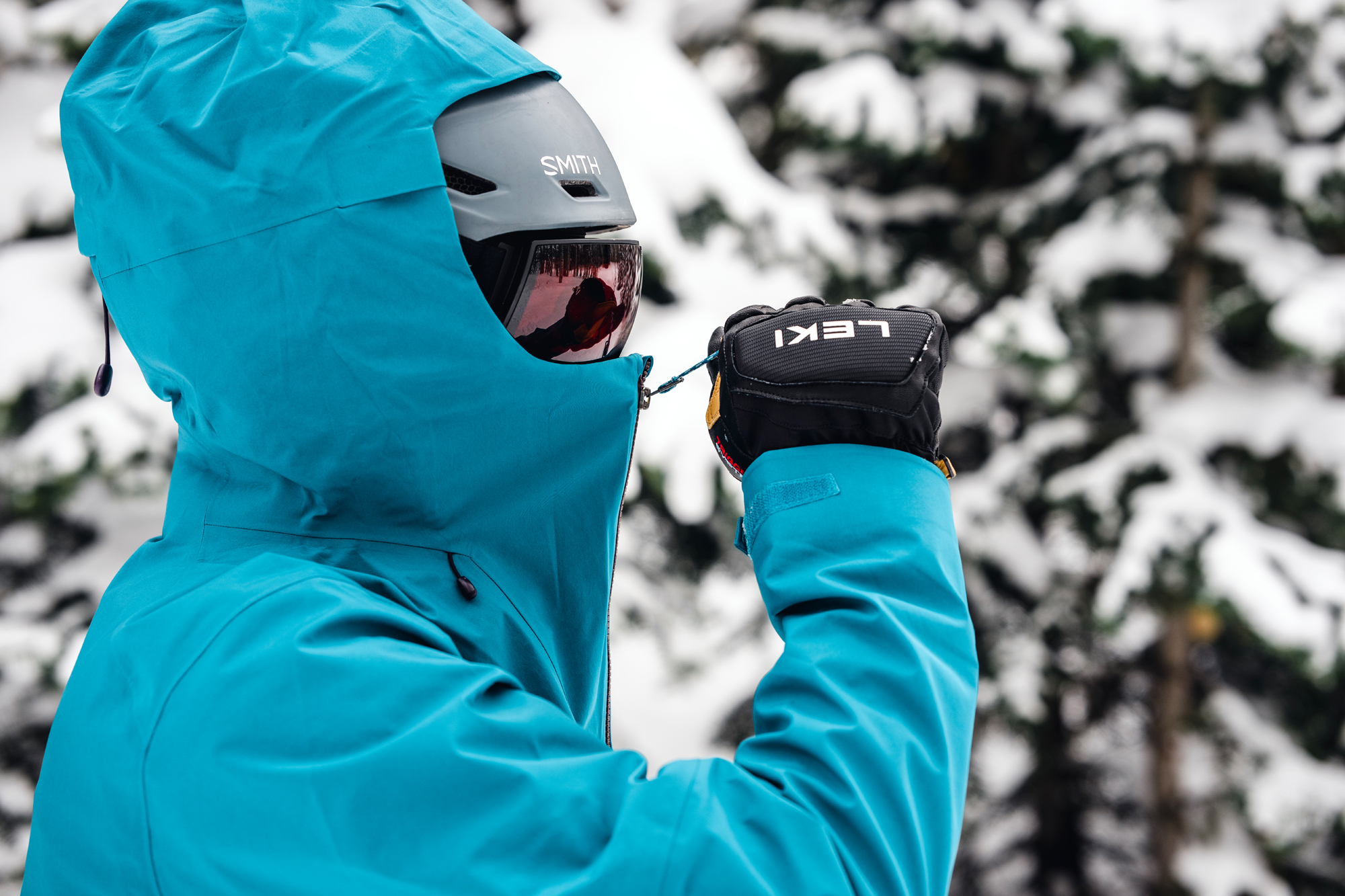
A ski jacket can break down for many reasons, including exposure to sunshine, rain, and snow. Heavy pack rub points, brushes against equipment, and contact with skin or products like sunscreen wear down the materials.
Frequency of use, the roughness of the activity, and overall user care can dissolve a jacket, too. If you use your ski jacket for everyday activity, anticipate that it will deteriorate faster. Be sure to follow the care instructions, which are unique for each jacket. You can clean your ski jacket and then reapply the DWR coating to help extend its use.
With so many variables, you can’t predict the exact lifespan of each ski jacket. We typically use our favorite well-constructed ski jackets for 5-6 years, but that number is often lower for backcountry gear: 2-3 seasons.
If you ski inbounds a couple of weeks each season and take good care of your jacket, you can easily assume the product life will be longer, even a decade.
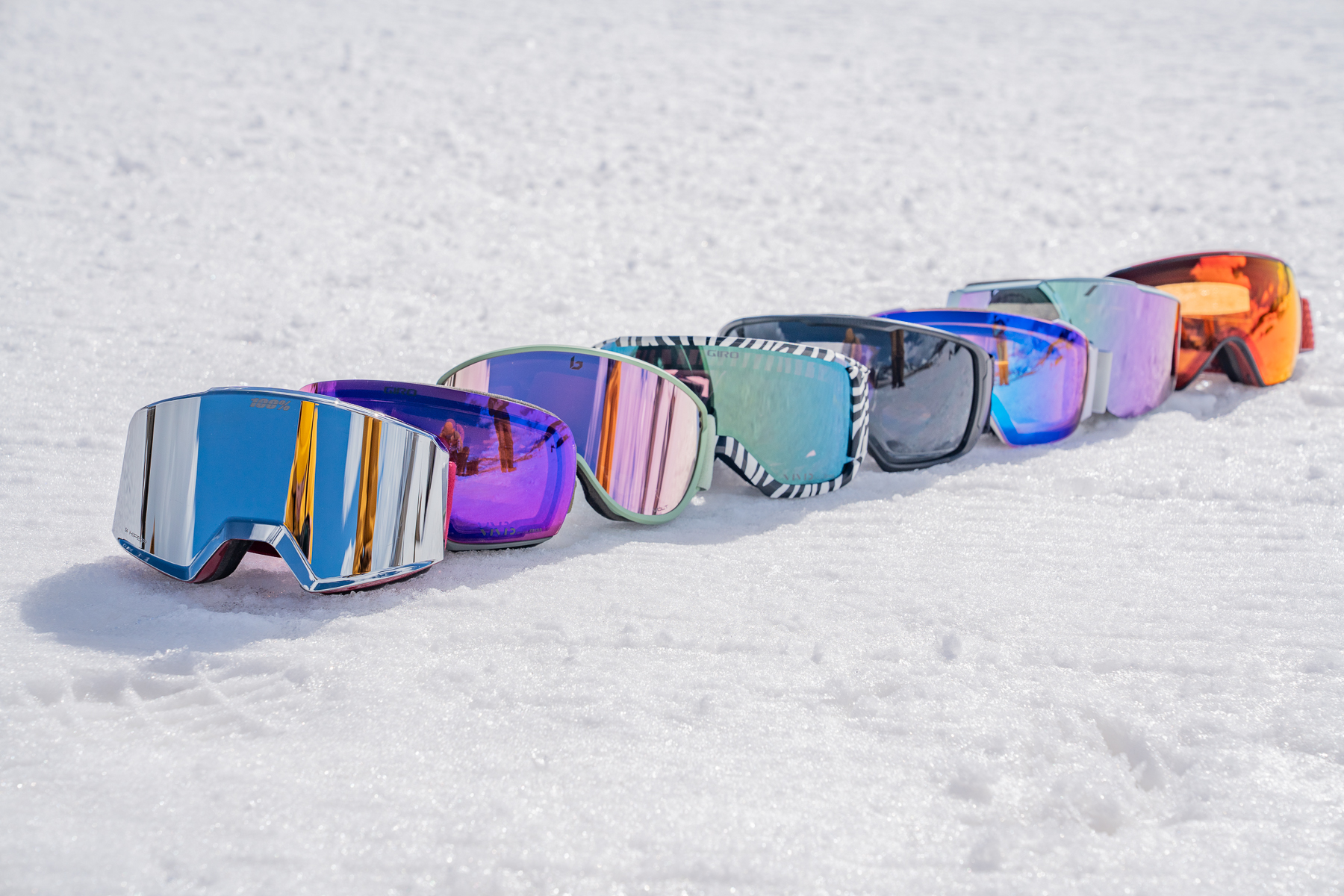
The Best Ski Goggles of 2025-2026
Searching for the best ski goggles for skiing, snowboarding, or snowmobiling? We’ve got you covered with our vetted collection.
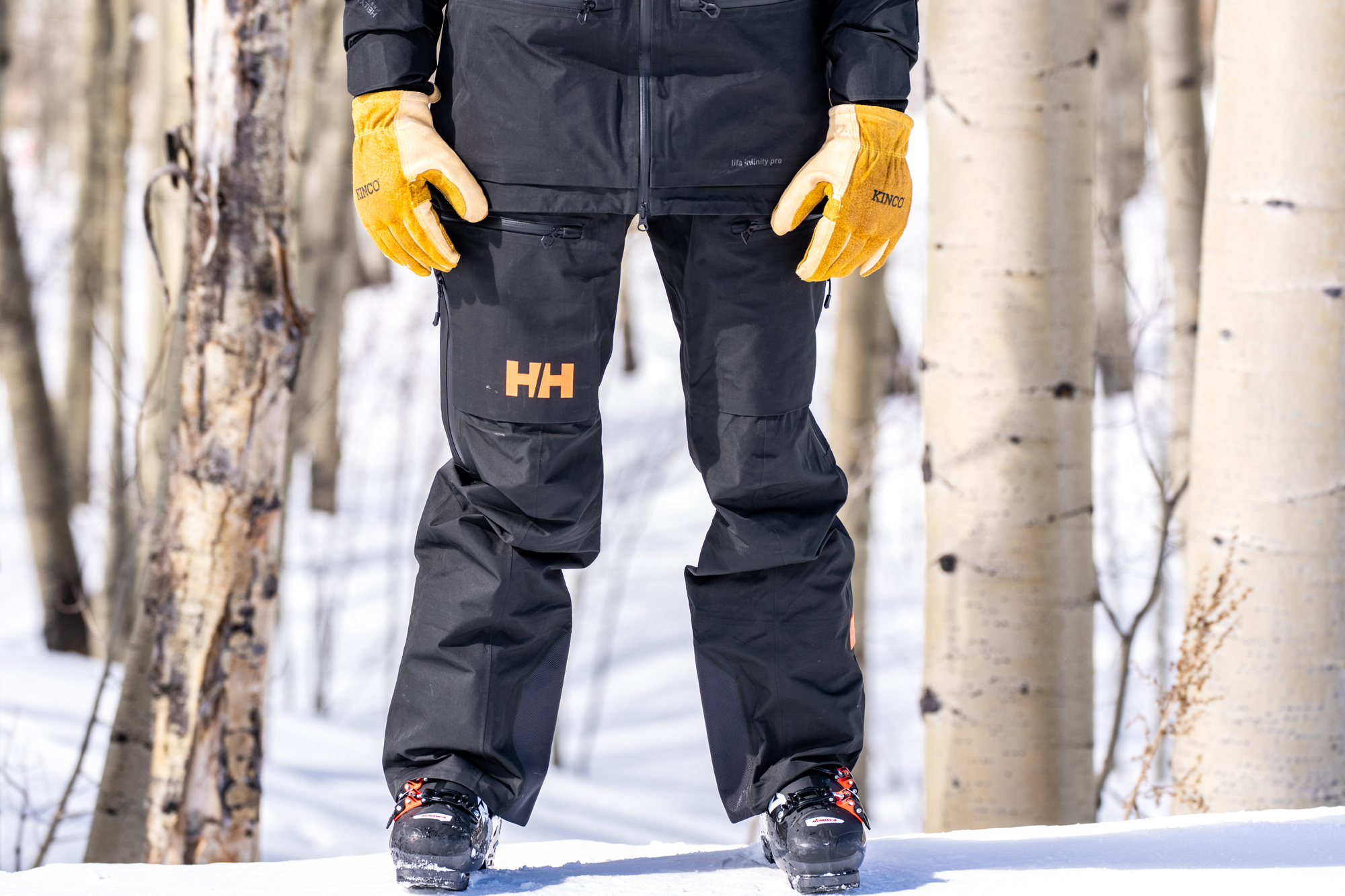
The Best Ski Pants of 2025-2026
For the resort or backcountry, we found the best ski pants for a range of conditions including Flylow, Patagonia, Rab, and more.
